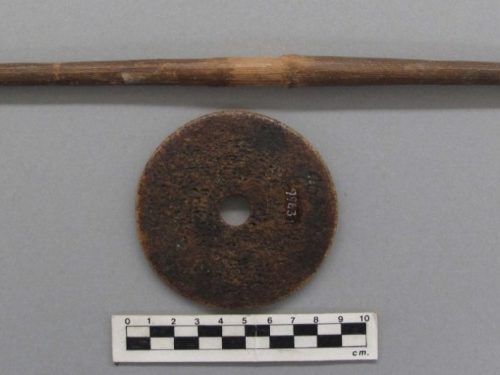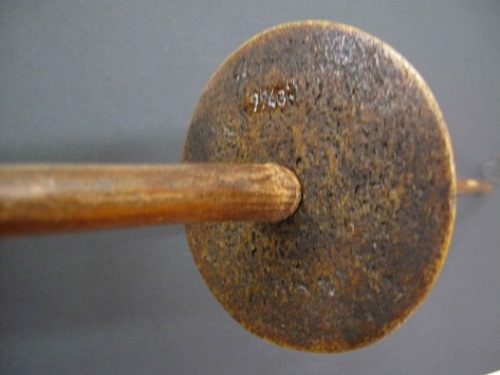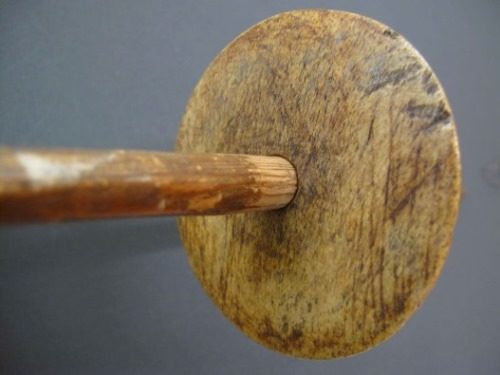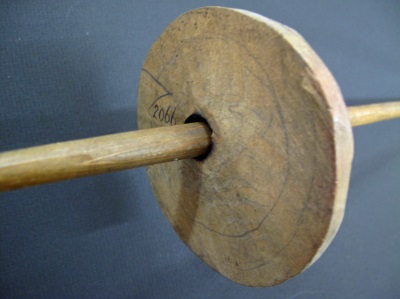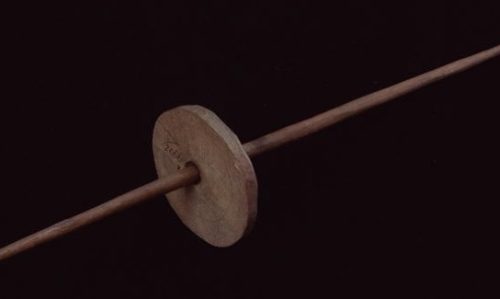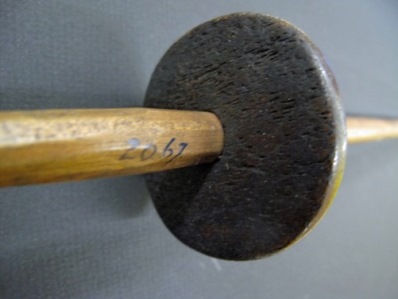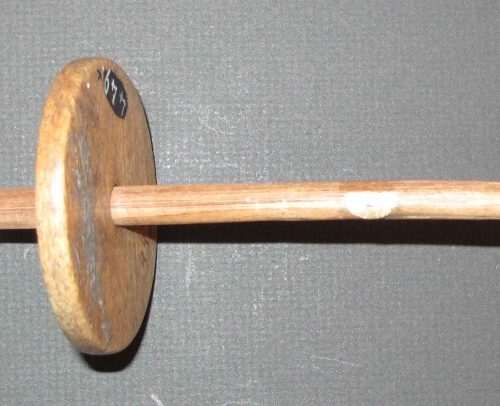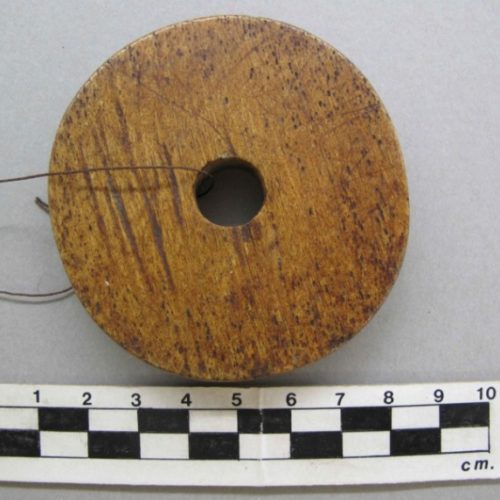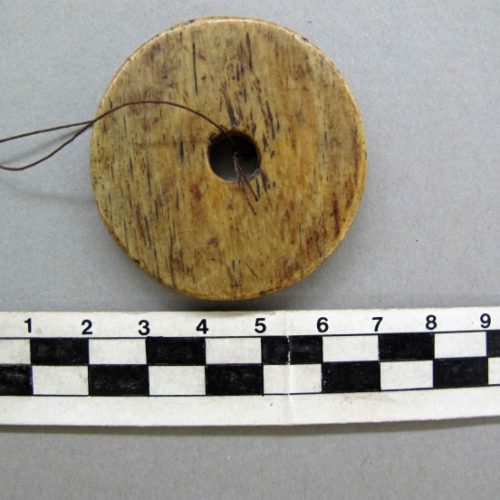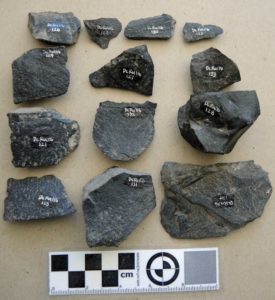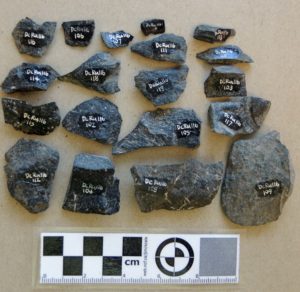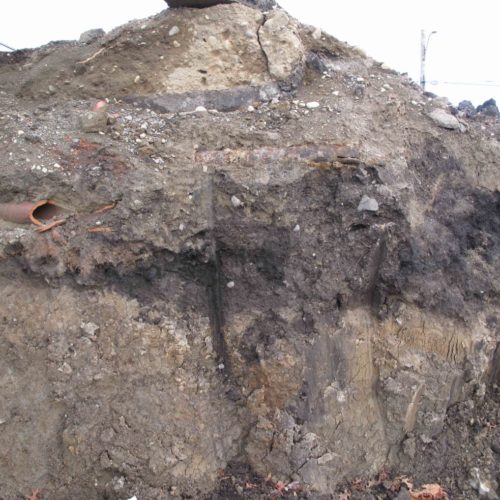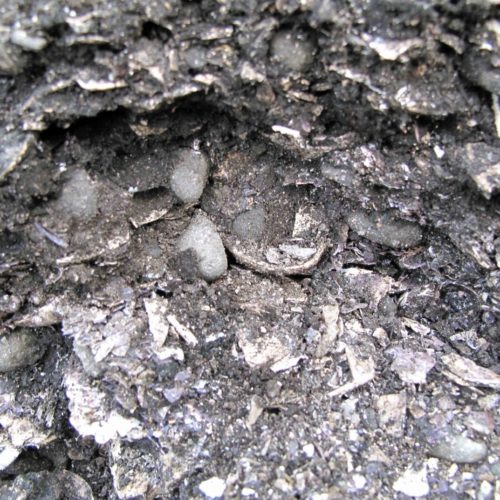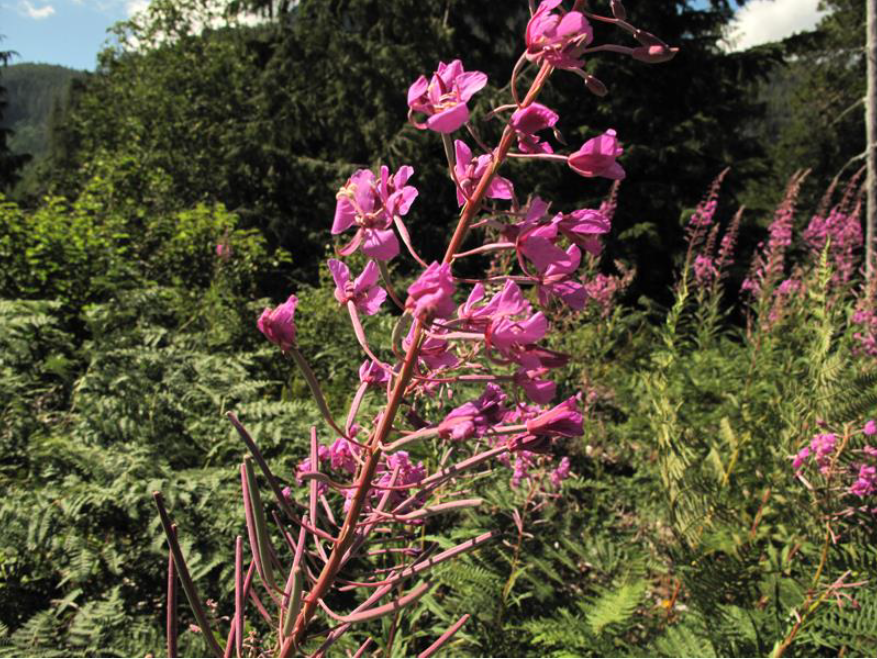Human History Curators
Small Spindle Whorls in the Ethnology Collection of the Royal BC Museum

Figure 1. Small Spindle Whorls in the Ethnology Collection.
Much of the attention in the literature has focused on the large spindle whorls used by speakers of languages in the Salish linguistic family on the south-eastern coast of British Columbia. In the 19th and early 20th centuries, small spindle whorls were found among peoples belonging to several of the larger linguistic families. The lack of iconography on most of these smaller spindles likely contributed to their being of less concern to researchers than the study of the larger whorls – many of which have geometric, anthropomorphic or zoomorphic design patterns.
The resurgence of indigenous weaving with the use of large spindle whorls in recent times has focused primarily on the use of animal wool. It earlier times the small whorls were primarily used for producing finer and longer threat made from stinging nettle. Stinging nettle thread would have been mass produced for the making of fish and bird nets as well as for a general tying string. Given that small whorls were introduced before the larger whorls, suggests that the earliest introduction of whorls into this region of North America was primarily related to the procurement of fish and birds. Although other plant fibres, such as fireweed, were likely used in earlier times, the use of animal hair and sinew along with plant fibres and bird down for clothing was probably a feature that developed later in time among some populations.
Morphology and Function
Most spindle whorls fall into two distinct sizes with a limited size range that we can refer to simply as large and small. The 20 smaller whorls in the RBCM ethnology collection range in diameter from 48mm–94.4mm. However, the upper range is biased by the three wooden whorls that range from 67-94mm. The diameter of the 17 sea mammal bone whorls ranged from 48mm-79mm. Wooden whorls are lighter than bone whorls and need to be larger to be of equivalent weight. The size of the hole in the whorl is related to the size of the whorl. Although the diameter of the central hole of the whorls ranges from 8mm-13mm, the smaller 48-65mm whorls have holes with a smaller range of 8-9mm.
The weight of the whorls in the RBCM collection can only be measured on ten whorls that are removed from their spindles or do not have associated spindles. The weight range of the 10 whorls is 16.6 – 45.9 grams. Where whorls were attached to the spindle, weights were taken of the combined elements of whorl and spindle. The range of the latter was 43.9-64 grams. The length and weights of the spindles used with small whorls was much less than those used with the larger whorls.
Regional samples are not large enough for any definitive comparisons, but comparing the more common sea mammal bone whorls, the three from the northern coastal regions are the larger in diameter range from 69.5-89mm. The five Heiltsuk examples range from 59-77mm, the three Nuxalk examples from 49-68mm, and the Kwakwala speakers six examples have a range of 48-69mm.
As a comparison, the seven bone whorls from Kwakwala speakers in the American Museum of Natural History have a similar diameter range as those in the RBCM of 40mm–80mm in diameter. Of the eight examples of Nuxalk small whorls in the Canadian Museum of History, three bone ones range from 50-64mm and five cedar ones range from 71-90mm. The five cedar Gitksan examples range from 59-95mm and two Tsimshian ones from 62-67mm. The one bone Nisga’a example conforms to the smaller size at 53mm. Two “central coast Salish” bone whorls in the Burke Museum range from 63-72mm, with a single stone Cowichan example being 50mm.
Sometimes the ethnographic literature is unclear about whether the smaller or large whorls are being referred to. Museum records may also have incorrect information added long after the whorls were collected – confusing the uses of small and larger whorls. Some small whorls were occasionally placed in ethnographic collections when, in fact, they were found in shell middens. In museum settings one needs to be aware that wool may have been added to museum spindle whorls for display purposes that were not part of the original purchase.
The size of spindle whorls differs according to the size and weight of the required thread. Most spindle whorls cluster into a standard small size and another grouping of larger varieties. The use of a small spindle whorl imparts a higher degree of twist and produces a finer and stronger thread than can be made with the larger spindle. It is for the latter reason that small whorls were primarily use for producing the finer threat made from stinging nettle. Stinging nettle thread was mass produced for the making of fish and bird nets.
The important considerations in the functioning of a spindle whorl are its weight or mass and its radius. The shape of the whorl and how its mass is distributed is also important. A spindle whorl with a lenticular cross section is thinner at the edges and will therefore have less inertia in its spin. A whorl must move at a constant speed in order to produce the best uniformity in the material being spun. The radius of the whorl and size of the spindle shaft will determine the size and weight of the fibre ball that accumulates on the whorl. For a technical functional analysis of spindle whorls see Barber (1991) and Loughran-Delahunt (1996).
In using the small spindle whorl, the yarn was fastened to the longer end of the spindle. A person sitting on the ground drew out the yarn with one hand as it was twisted and with their other hand rolled the spindle shaft below the whorl rapidly down the thigh or shin.
Ethnographic collections of small spindle whorls are found among the Nisga’a, Haida, Haisla, Heiltsuk (Bella Bella), some Tsimshian speakers, Nuxalk (Bella Coola), Kwakwala speaking peoples and Nuu-chan-nulth peoples. There are no examples of small whorls in the RBCM ethnology collection from First Nations
that belong to the Coast Salish linguistic family. Larger spindles from the latter region will be dealt with in Part 3 of this series. The RBCM collection does have archaeological examples of small spindle whorls from the latter area (see Part 1).
Practices & Materials Used
The ethnologist Franz Boas documented information on spinning and spindle whorls in the 1886 to 1897 period. He focused his attention on the Kwakwala speaking peoples of North-Eastern Vancouver Island and the Nuu-chan-nulth peoples of the West Coast of Vancouver Island, who he saw as being less affected by European culture at the time.
Boas’s First Nation consultants described four different sizes of spun thread that were used for different purposes. The method of free-dangling of the whorl was not practiced in British Columbia in the historic period.
Small spindle whorls are mostly made of sea mammal bone. Boas describes most spindle whorls from the west coast of Vancouver Island as being made of whale bone, with a few of wood and stone. Small spindle whorls in the Berlin Museum from the west coast of Vancouver Island have geometric and realistic designs. Among the “Kwakuitl”, Boas did not observe any with designs (Boas 1909:373-374).
Boas (1909:372-373), describes in detail the making of twisted stinging nettle string which is coiled up in a basket and then spun. His figure 67 shows a 34cm long, quarter section maple wood spindle shank with a small whorl attached near the thicker middle. He notes:
“The spindle-whorl is made of bone of whale, the anterior part of the skull-bone being preferred. It is ground down on a gritstone. Then it is polished, and finally rubbed with deer-tallow. The size of the spindle-whorl differs somewhat, according to the size of the thread to be made. The sizes of those in the Museum [Berlin] collection range from 7cm to 8cm. in diameter. They are not decorated. Many of the spindle-whorls from the west coast of Vancouver Island (Fig. 68) are decorated with geometrical and realistic designs. Most of these are also made of bone of whale, while a few are made of wood and of stone.”
Boas notes that his figure 68a “corresponds in style to other decorated tools of the Nootka”. He states that: “it is remarkable that the spindle-whorls from this whole region are all small, while spindles used by the tribes of the Fraser River region are very large”.
Carved figures of humans and animals are rare on small spindle whorls. Boas’s figure 68, is reproduced here as Figure 2. His figure 68a shows a squatting human with the central hole for the spindle through the centre of the figures chest. The figure is cut out within a solid ring forming the outer portion of the whorl. This figure is reminiscent of some of the later larger whorls from south-eastern Vancouver Island with human figures around a central hole. Three of the top row images and one of the bottom images show the designs that Boas refers to, while the plain ones on the bottom row are typical of the Kwakwala speakers of North-eastern Vancouver Island. These same whorls are incorrectly referred to as being from the “Lower Fraser River” in a later Boas publication (1955:371; fig. 296, p.283).

Figure 2. Small Spindle whorls from the west coast of Vancouver Island collected by Franz Boas for the Berlin Museum in the late 19th century (After Boas 1909, fig.68).
Washington State. Uses of the Spindle Whorl.
In reference to the southern coast, James Swan notes that the women “spin the thread and twine for making nets. This operation is performed in a very simple and primitive manner by twisting the strands between the palm of the hand and the bare leg …these cords, when spun, are tied up in hanks of thirty or forty fathoms each, and carefully stowed away for future use. The men make the nets” (Swan 1969:163-164).
The nets “are made of a twine spun by themselves from the fibres of spruce roots prepared for the purpose, or from a species of grass brought from the north by the Indians. It is very strong, and answers the purpose admirably. …The nets vary in size from a hundred feet long to a hundred fathoms, or six hundred feet, and from seven to sixteen feet deep” (Swan 1969:104).
Newcombe notes: “String is made by joining strands of nettle fibre by rubbing them on the thigh and then twinning them together by means of a small spindle-whorl. Sometimes these are carved with a crest of the owner” (Newcombe 1909:37). Unfortunately, Newcombe does not give any specific examples of whorls with iconography that represents an owner’s crest.
Ethnologist Wayne Suttles noted, from information collected in the 1950s, that among the Central Coast Salish speakers:
“Weavers also made a fabric of yarn produced by mixing waterfowl down with nettle fibers, and they made pack straps by twinning on suspended warps, incorporating some of the design elements seen in the blankets” (Suttles 1990:462). There is no mention here of the size of the spindle.
Suttle’s First Nations consultant Julius Charles (born about 1865. Father Semiahmoo and mother Lummi) noted that during winter hunting men wore a buckskin jacket over a bird down and nettle fibre undershirt (Suttles 1974:262-265).
During his field research in Washington State in 1925-27, Olson interviewed five Quinault First Nation consultants that were all over 60 years old, with one, Bob Pope, being over 90. Olson was informed that there were four sizes of nettle thread. Netting was made from two of these threads spun together. The same method was used for the Mt. goat and yellow cedar (Olson 1936).
“The familiar rabbit skin blanket of western North America was also made. The skins were cut into strips and these twisted hair side out, a spindle being sometimes employed. The strips were either woven as a simple cross weave or, probably more usually, used only as the warp, the weft consisting of elk sinew threads twined in at intervals. The skins of ducks were sometimes cut into strips, which were twisted and woven in the same fashion as the strips of rabbit fur” (Olson 1936:82). No mention is made if different sizes of whorls were used for the production of different materials.
Olson refers to the sheared dog hair being placed into “a cleft stick to keep the hairs aligned”. Here he clearly describes the use of the larger whorls:
“Twisting of this hair into yarn was done simply with the fingers (Pope) or by means of a spindle which was rolled down the thigh. The spindle was eight inches or so in diameter (210-220mm). A third informant stated that a spindle (without whorl) which had a hook at its tip was used to pick up the tufts of hair out of the split stick, the spindle being merely twisted by the fingers of the right hand. The yarn was then rolled into balls. Few (or none?) blankets were woven with both the warp and weft of this yarn, twisted elk sinew being woven or twined in as the other element” (Olson 1936:82).
Nuu-Chan-nulth of the West Coast of Vancouver Island
It is unclear whether small spindles were being used among some Nuu-Chan-nuth peoples in 1792. Don Francisco Mosino observed the women at Yuquot “are mainly engaged in the sedentary occupations of spinning and weaving”. But he then suggests that they do not have spindles in his reference to “distaffs”. He points out that: “They have no distaffs except their teeth and fingers, with which they bind together cypress [cedar] fibre and otter hair in order to form a thick plait. This they then make thinner and longer, until they have a skein about a foot long. They use the most simple looms, making a warp out of a cane set horizontally at a height of four and a half feet from the ground; they move their fingers along it rapidly in different directions and with extraordinary skill, making up in this way for the lack of tools which would in any other case be necessary and indispensable for this work.” (Jane 1971:107).
Drucker, working among the Nuu-Chan-nulth (1951:94), notes that after beating cedar: “A part of the strands were woven into thin cord to be used in weaving the robes, rain capes, and women’s aprons. Spinning of this, and all other cordage, was done by hand, on the bare thigh. Spindles have not been used within the reach of modern folk-memory. Several informants recalled having seen Nitinat women spinning with large wooden spindle whorls, apparently like those of the Coast Salish. Presumably the practice of spinning with small bone and stone spindle whorls went out of use very early.”
The observations of Nitinat women using large spindle whorls is interesting in light of the suggestion that the Nitinat, or at least some of them, once spoke a Salish language (Drucker 1951:94). In 1861, a settlement of “Cowichan” were recorded as living “near San Juan harbor”. The British Colonist reported that: “Some years ago this tribe was a very numerous one, but through wars and disease it has been reduced to only twenty men and women” (The British Colonist, March 9, 1861:3). Chief Charlie Jones told the story of how people from Cape Flattery “took over Nitinat Lake for a period” before the coming of Europeans (Arima 1983:105).
The Iconography on Small Spindle Whorls
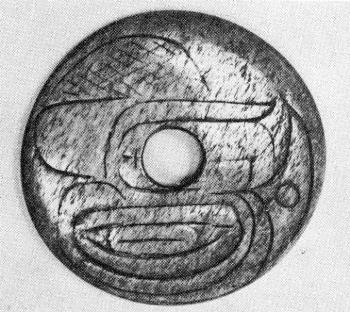
Figure 3. Small carved bone whorl (after Miles 1969:186 fig. 7.146).
There are few small spindle whorls in ethnographic collections with designs of any kind. Unique examples include one collected in 1893, by Adrian Jacobsen at Bella Bella (old RBCM #454). It has a frog on one side and what is described as a “mountain spirit” on other side. The “mountain spirit” has a human-like face with round eyes, heavy eye brows and raised cheeks. A Nuu-chan-nulth example (figure 2) collected by Boas in 1886-1897 shows a squatting whole human figure, but no interpretation of the image is given. Like some later images on large whorls of speakers of Salish languages of Vancouver Island, the hole for the insertion of the latter spindle is centered in the body of the human figure. A unique design can be found on a whale bone specimen (on a short spindle) from a private collection pictured in Miles (1963:102 & 186). It is a more stylized modernistic image (figure 3) that may represent a bird head with the hole representing an eye, or it is a combination of symbols. Miles describes this “Northwest Coast nettle fibre spindle” as having a “design Haida in character”.
It is interesting that geometric designs exist on small pre-contact stone and bone whorls from locations on the south coast and into the southern Interior but are not found as ethnographic examples.
The Ethnology Collection
Nisga’a
RBCM 1692 A,B – (with spindle A); (old #480). Nisga’a. Gitkateen. Lakalsap. Whorl: Wood. Flat. Diameter: 79-81mm; th. 9-9.3mm; hole dia, 12mm. Weight: 16.6 grams. Flat edge irregularly cut. There are two small nails in the edge on opposite sides of the whorl used for the purpose of strengthening the crack across the centre of the whorl. Purchased by Charles Newcombe in 1912. Newcombe notes: “Spinning wheel Lagiauks, spindle turned by right hand on right leg. Rest stick Watuqs”. Spindle: L: 377mm; Thickness: 10mm near center; Weight: 14.5 grams. Whorl is removed from spindle but originally near center.
RBCM 1693. Nisga’a. Stone. Large hole. Four carved oval eyes on one side. Weight: (not available). On artifact “1088”; “26 (?) 13”. Lakal? “Mark Tait, Skimmer for (BD?) GR Equals Hadaq 2.00, whirl of stone equals Hagia KS 2.00 NTBK 29A. Purchased by Charles Newcombe in 1913 from Mark Tait. Lakalzap. Greenville, Naas River”. Transfer to Nisga’a First Nation (No image).
RBCM 15908 B – (with spindle A), Nisga’a. Lakalsap. Gitkateen. Sea Mammal bone. Flat edge. Whorl: dia. 69.5-71mm; th. 9.5-13.5mm (thicker toward middle); hole dia. 11mm; Whorl Weight: 32.3 grams. Whorl positioned 21cm from one end. Spindle L: 478mm; Weight: 29.5 grams. Purchased in 1977 from Queensway Trading in Terrace, B.C., who purchased it earlier from Mr. Sam Green of Greenville.
Haida
RBCM 9963a&b. (with spindle) (old #963). Bone. Near flat disc. Slightly concave on both sides. Weight: 45.9 grams. Diameter: 83 by 84mm; hole diameter 13mm. Thickness: 4mm on outer rim to 7mm near inner hole. Spindle, wood. Length: 430mm. Thickness: maximum 13mm. Collected by Charles Newcombe in Masset, Oct. 1, 1913. (Newcombe Family papers. Add. Mss. 1077. Vol. 40, Folder 7. Subject Files, Series B: Collections. Photo by Newcombe, Nov. 1917, EC575 glass plate). Collected in 1913. From estate of William Newcombe 1961.
Haisla
RBCM 2066a,b. (with spindle); “Kitimat”. Wooden whorl. Maple? Diameter: 88.2X94.4mm; pencil line circle inside 73X77mm; th. 11.8X16.5mm (thicker near middle), whorl centered toward one end on spindle; hole dia. 11mm (slight burned area in hole). Edges flat and roughly carved. Spindle of Cedar. Length: 530mm; Thickness: 112.5mm. Weight: 64 grams. Whorl located 18cm from one end and fixed on spindle. Weight of spindle and whorl: 64 grams. Collected by Charles F. Newcombe in 1911 from Mrs Robinson of Kitamaat.
RBCM 2067a,b. (fixed on spindle) (KW) “Kitamaat”. Sea mamal bone. dia. 59.5mmX65mm; th. 80-89mm; hole dia. 12mm. Spindle of cedar: L: 523mm. Thickness: 13.5mm. Whorl 230mm from one end, near center. Combined weight of whorl and spindle: 57.8 grams. Charles F. Newcombe 1911.
Heiltsuk (Bella Bella)
RBCM 449a & b – (with spindle) Bella Bella. Sea mammal bone. (1893, F. Jacobsen) diameter 62.7X65mm across hole. Broken. Whorl position off centre. th. 8mm; hole dia. 9mm. Whorl fixed on cedar spindle, combined weight 49.8 grams. Spindle L: 32.4 (small portion of end broken); Width: 8.6mm. Preliminary Catalogue 1898: “Wooden spindle, with bone whorl and native wool”.
RBCM 450a & b – (with spindle) Bella Bella. (1893, F. Jacobsen); Sea mammal bone. Flat body and edge. dia 71-77mm; th. 8.3-8.8mm; hole dia. 11mm; Spindle L: 550mm; Th: 10.3mm. Whorl fixed on spindle. Combined weight: 62.3 grams. [Recorded in 1898 catalogue, p. 164].

Bella Bella spindle and whorl. RBCM 450&450b.
RBCM 451 (with spindle). Bella Bella. (1893, F. Jacobsen); sea mammal bone. Flat whorl; Edges flat with rounded corners; dia. 60X63mm; th. 5.9 – 6.4mm; hole dia. 11mm. Spindle: L 545mm; Th: 11.2. Whorl centered at 280mm. Combined weight of whorl and spindle: 51.8 grams.
RBCM 452a & b. – (fixed on spindle). Bella Bella. Sea mammal bone; dia. 58.8X59mm; th. 95mm; hole 11mm. Cedar Spindle: L: 410mm; Th: 10mm. Whorl 160mm from one end. Combined weight of whorl and Spindle: 48.9 grams. Whorl fixed on spindle. Collected in1893 by F. Jacobsen.

Bella Bella Spindle and whorl. Ethnology RBCM 452a&b.
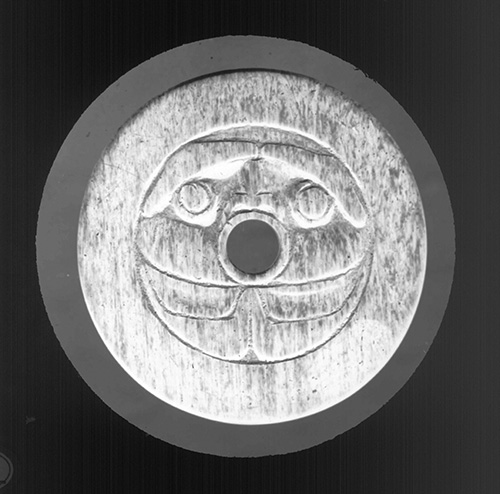
Bella Bella spindle whorl. Mountain Spirit design. RBCM 454.
RBCM 454 – Listed in Old Catalogue as “Kwakuitl”. “Carved bone whorl. “Frog on one side, mountain spirit on other”. “A. Jacobsen 1893, Bella Bella.” Acquired April 1909. The 1909, Guide to Anthropology Collection in the Provincial Museum repeats this information on page 37: “No. 454 has a frog on one side and a mountain spirit on the other”. The label of Newcombe’s Lantern Slide, EC374, has “Bella Bella Spindle whorl” on it. This artifact was stolen when on loan for an exhibit in Vancouver in 1936. A poor quality caste is located in the archaeology collection as Y-806 (75-7). The connection with this and #454 had been lost until now. The cast is nearly flat: Diameter: 67-68mm. Thick: 7.0mm at center and 6.5mm at the edges. Hole diameter: 10mm. Black and white photograph #22603. The “mountain spirit” has a human-like face with round eyes, heavy eye brows and raised cheeks. Newcombe EC374 “glass plate”, 1909 – copied as PN 1337 – shows the same image. Photograph 721 shows the frog design from Newcombe’s 374-IX/69, 1909, and a different version of the same frog image in photograph 721-A – listed as EC 374 – IX/69, 1909.
Nuxalk (Bella Coola)
RBCM 2978 – (fixed to spindle) Bella Coola. Wooden whorl. Dia. 76X82mm; Th. 12-19mm (thickens toward middle); hole 10mm; Hardwood Spindle. L: 440mm; Th: 10mm. Whorl near middle of spindle. Combined weight of spindle & whorl: 59.5 grams. (purchased from Capt. Schooner, 1917); (in image PN11455).

Bella Coola Spindle and Whorl. RBCM 2978.
RBCM 9986 – (moveable on spindle); Bella Coola; sea mammal bone, flat. Dia. 66X68mm; th. 12-14.5mm; hole 10mmm; Flat edge with 3mm inset low area; Weight: 26.5 grams. [1914, ex Gibson coll. “Bought at Van. Canadian Handicraft Guild 6/8/14”, then into Newcombe collection; old # 986]. Spindle: L. c400mm; Whorl positioned mid-way, c, 200-210. Spindle weight: 16.2 grams. Old #986. Pencilled at center of spindle: “Spindle Ex… Gibson. 1914”.

Bella Coola RBCM 9986.
RBCM 10112 – (fixed on spindle) Nuxalk; Flat sea mammal bone. Dia. 49-51mm (squarish); th. 11.0-12mm; hole dia. 9mm. “Bella Coola” in ink on one side. Old # 1112. Cedar spindle. L: 515mm; Th: 9mm. Positioned between 260mm and 270mm on spindle. Combined weight of spindle and whorl: 43.0 grams. Newcombe, June 1917. Newcombe photo EC575. Nov. 1917.

Spindle and Whorl RBCM 10112.
RBCM 10113 – (no spindle) Bella Coola; Flat sea mammal bone. Flat edge with rounded corners. Weight: 33.8 grams; dia. 65-65.9mm; th. 6.5; hole dia. 12mm; Slightly burnt. Newcombe collection, old # 1113, glass plate photo, Nov. 1917, EC575.
Kwakwala Speakers
RBCM 2068 – (no spindle); Alert Bay. Sea mammal bone. Weight: 71 grams; dia. 67.1X69mm; th. 14.1-14.4mm; hole dia. 13mm. (old C.F. Newcombe #359. Collected in 1912).
RBCM 2069 (no spindle); (KW); Sea mammal bone. Weight: 25.4 grams. dia 55mm; th. 6.6-7mm; hole dia. 11mm; (19-21mm radius shift from edge of hole). Flat with flat edges. (old C.F. Newcombe #360 collected in 1912).
RBCM 2070 – (no spindle); Alert Bay; Sea mammal bone. Weight: 19.7 grams. Diameter: 47X48mm; th. 6.1-6.3mm; hole dia. 9mm; Flat with flat edges. (old C.F. Newcombe #361, collected in 1912).
RBCM 6530 – (with spindle) (KW); Sea mammal bone. Diameter: 58X62mm; th. 8X8.2mm; hole dia. 8mm. Combined whorl and spindle: 48 grams. Fixed Whorl, located 15cm from one end of spindle. Spindle: L. 406mm; Th: 8.2mm. Acquired 1947. “Spindle with whale bone whorl for nettle fibre plain”. “Canon A. J. Beanlands Coll. Per Mrs. Alyson N. Beanlands. Collected about 1884-1909”.

Kwakwala. RBCM 6530.
RBCM 10090a, b. (with spindle) (KW); Sea mammal bone. Diameter: 63.4X65.2mm; th. 6.1- 6.6mm. Hole dia.: 11mm, Whorl weight: 8.9 grams. Slightly burnt by design. Cedar spindle. Whorl centered on Spindle. Spindle: L. 343mm; Th: 11mm. Kingcome Inlet. Old # 1090 written on center spindle under hole and on flat of whorl.
RBCM 10448 – (no spindle) “Fort Rupert, Tsaxis”. Sea mammal bone. Diameter: 59mmX61mm; th. 6-6.5mm; hole dia. 11mm. Weight: 22.9 grams. [old #1448].

RBCM 10448. Kwakwala.
Nuu-chan-nulth

Stone Whorl. RBCM 12691.
RBCM 12691 – (no spindle); Quatsino. Grey Slate. dia. 72mmX73.8mm: th. 6.9-7mm; hole dia. 10mm. Painted red, green and black. Made with steel file. Two incised circle grooves on painted side. Whorl off center. Weight: 59.7 grams. No design on one side. Modern non-traditional whorl. It was likely made as a model for sale.
Comments on some Ethnographic and Historic Accounts
There are many references to spinning that can refer to spinning by twisting fibre by hand on the knee or references that do not specify the size of the spindle whorl. In a prospecting tour of the north coast James McKenzie notes that going up the Nass River he passed five villages during which he observed the spinning of “goat hair garments for women” without mentioning the use of a whorl (McKenzie 1864:3).
Morice observed in 1892-93 that: “rabbit skin blankets were originally the only genuine textile fabric manufactured among “the Carriers, the Tsekehne or the Tsilkohtin”. Strips of rabbit skin were tied together and twisted on the thigh, and used as both warp & weft stands on a frame, but he notes that the Carrier did not use a spindle and whorl. He does illustrate a spindle with a whorl used by the Chilcotin, but does not indicate if it is small or large one (Morice1892:156).
Further south along the Columbia River-Upper Arrow Lakes region on May 7, 1814, Gabriel Franchere observed: “Natives camped on the bank of the river” – “The women at this camp were busy spinning the coarse wool of the mountain sheep, They had blankets or mantles woven or platted of the same material, with a heavy fringe all round…”. Near Rocky Mt. House Franchere notes in reference to “Mt. Sheep wool”, that: “The Indians who dwell near the mountains make blankets of it, similar to ours, which they exchange with the Indians of the Columbia for fish and other commodities” (1968:231-32; 216). No mention is made of the use of a whorl.
One of the more extensive commentaries on spinning, weaving and their similarity between the Fraser Canyon and the Lower Fraser River was made in a 1908, letter from James Teit of Spencer’s Bridge where he refers to blankets from Spuzzum that the daughters of Joseph McKay (of the HBC) were trying to sell to the Provincial Museum. It appears that the commentary here refers to the larger whorls being used in the Fraser Canyon area:
“I intended writing you before, but was waiting another chance of interviewing the Spuzzum woman. I saw her again a few days ago. She says she never saw a loom exactly like the one in Nootsack, and are different from the ordinary large blanket loom, the horizontals being different and not made to turn, and the head band is made in a simple piece stretched up and down, and not over the horizontals. (The only way to get a proper idea of this kind of loom will be to have one made). As I am going to Vancouver …on my way back I will try to stop off at Spuzzum and get one of these small looms. She said she never heard of any combs being used. The weaving being done with the fingers. Re: the breed of dogs she says the pure breed was totally extinct around spuzzum before she can remember, but she has heard from the old people they were a medium sized animal with long and very fine thick hair. They were mostly white but some it is claimed were black. They were a distinct species according to tradition introduced from the Lower Fraser, and were to be found nearly as far East as Lytton. The Indians tried to keep them from inter-breeding with the real Interior dog, and around Spuzzum favored the keeping of them rather than the former. Their hair was used in blanket weaving at Spuzzum, generally mixed with the wool of the goat. People who did not have any of these dogs used only goat’s wool. The using of dog’s hair it is said made the blankets of a softer texture & furthermore they supplied a source of wool right at hand, whereas the goats had to be hunted and their wool thus cost considerable labor.
These dogs were of altogether a different species from the common dog of the Thompson further east and were called by the special name of xlitselken. The other dog called skaxaoe (viz real dog) somewhat resembled the husky and also bore some resemblance to the Coyote and to the wolf with both of which they occasionally inter-breed. They were used mostly for hunting purposes. Re: the dyes used with blankets etc. The common colors were yellow, red & black. Yellow was obtained from Wolf moss (evernia vulpina I think is the botanical name) red from alder bark, and black bear’s hair for black. The hair of black dogs was also used when obtainable viz black specimens of xletselken. She has however heard of the following dyes also being used viz red ochre (giving a reddish tint) roots of oregon grape (yellowish) berries of the cedar (greenish), Possibly other dyes like those used amongst the Upper Thompson may also have been used, but she does not know. The ring you speak of as being used to keep up tension when the Weaver was spinning the loose wool on the spindle I have seen in use on the Lower Fraser. They were made of both wood and stone. I saw a lot of stone ones at Musquiam village, and at several points on the Lower Fraser Indians told me these stone rings were used for this purpose of course the wooden rings were much more common. As to judge from your description of Mrs. McKay’s blankets it is very unlikely the material is dog’s hair, and the dyes native. I think this is all I can tell you about these blankets at present – the weaving, and the preparing and spinning of the wool was just the same at Spuzzum as on the Lower Fraser & southern coast. I would like to keep the prints you sent me if you do not require them. …I sent a specimen of the earth (in prepared state) used for cleaning or taking the oil out of the wool to the Amer. Museum. …” (Teit 1908).
Summary Commentary
It is important to discuss the differences between small and large spindle whorls, as they often have different uses and different regional histories. Where spindle whorls came from is still a question waiting to be answered. Bone spindle whorls have been found in archaeological sites stretching from the American gulf Islands to the central coast of B.C., but their dating is unknown or their placement is within broad time periods. For example, King notes a spindle whorl in the Maritime phase of San Juan Island with a broad time frame of 500 A.D. to 1500 A.D. and suggests that: “The occurrence of a spindle whorl in the Maritime strata in conjunction with the needles and the remains of small dogs, mountain sheep, and mountain goat makes it highly probable that the Maritime phase may mark the beginning of the weaving of wool and hair in the southern Northwest Coast area” (King 1950:81). As in other cases, the spindle whorl could date to the last centuries of the time sequence given.
There are no solid examples of small spindle whorls dating before about 600 years ago. Carlson (1971) indicates that the three whalebone whorls from the Kwatna Inlet site FaSu-2 are of the late period from A.D. 1400-1800. Small stone whorls of a pre-contact age with geometric designs appear in the Fraser Canyon, but historic period references pertain to the larger whorls common on the southern coast in the historic period.
In Mesoamerica we see the establishment of ceramic and stone spindle whorls by the late Preclassic period 400-250 B.C. and early Early Classic period 250-600 A.D. and their considerable expansion by the Late Classic period 600-900 A.D. In Mexican spindle whorls (particularly the larger whorls for spinning maguey fiber) were decorated with incised and mold-made designs, but the production of decorated whorls stopped during the 16th century (Brumfiel 1997). The influence of spindle whorls appears to have spread from Northern Mexico to the American Southwest where small spindle whorls appear in the Pecos culture of New Mexico around 1100 A.D. and spread throughout the American Southwest. The latter were made of bone and ceramic with the bone examples mostly in the 5-10cm diameter range (Kidder 1932). More precise dating of spindle whorls in British Columbia is needed to tell the story of when and where they came from and the economic and social context of how they diffused over the landscape under various cultural trajectories.
Bibliography
Arima, E.Y. 1983. The West Coast (Nootka) People. British Columbia Provincial Museum Special Publication No.6.
British Colonist. 1861. The Squaw Murder. The British Colonist, March 9, p.3, Vol. 5. No. 69.
Brumfiel, Elizabeth M. 1997. Tribute Cloth Production and Compliance in Aztec and Colonial Mexico. Museum Anthropology. Journal of the Council for Museum Anthropology, 21(2)55-71.
Carlson, Roy L. 1971. Excavations at Kwatna. Anutcix (FaSu-1) and Kwatna Phase sites. FaSu-1 and 2. Late prehistoric A.D. 1400-1800. Salvage ’71. Reports on Salvage Archaeology Undertaken in British Columbia in 1971. Edited by Roy L. Carlson. Department of Archaeology, Publication No. 1. Simon Fraser University, Burnaby British Columbia.
Drucker, Philip. 1951. The Northern and Central Nootkan Tribes. Smithsonian Institution. Bureau of American Ethnology. Bulletin 144. United State Printing Office, Washington,
Franchere, Gabriel. 1968. (Ed. Milo Milton Quaife). A Voyage to the Northwest Coast of America. Citadel Press, New York. pp. 231-32; 216.
Jane, Cecil (Editor). 1971. A Spanish Voyage to Vancouver and the North-West Coast of America. N. Israel/Amsterdam. Da Capo Press. New York.
Kidder Alfred Vincent. 1932. The Artifacts of Pecos. New Haven. Robert S. Peabody Foundation for Archaeology. Yale University. Pp1-314.
King, Arden. 1950. Cattle Point A stratified Site in the Southern Northwest Coast Region. Memoirs of the Society for American Archaeology. Number 7. Published Jointly by the Society for American Archaeology and the Tulane University of Louisana. Menasha, Wisconsin, USA. Supplement to American Antiquity, Vol. 15(4), part 2, April 1950.
McKenzie, James. 1864. Prospecting Tour of the North West. Victoria Evening Express, September 9, 1864:3).
Miles, Charles. 1969. Indian and Eskimo Artifacts of North America. Bonanza Books, New York.
Morice, 1892-93. Notes on the Western Dene. Transactions of the Canadian Institute. Vol. IV.
Olson, Ronald. 1936. The Quinault Indians. University of Washington Publications in Anthropology. Volumne VI, Number 1. University of Washington Press. Seattle and London.
Suttles, Wayne P. 1990. Central Coast Salish. Handbook of North American Indians – Volume 7: Northwest Coast, William C. Sturtevant General Editor, Smithsonian Institution, Washington, pp. 453-475.
Suttles, Wayne P. 1974. Coast Salish and Western Washington Indians 1. The Economic Life of the Coast Salish of Haro and Rosario Straits. Garland Publishing Inc. New York.
Swan, James G. 1969 (1857). The Northwest Coast. Or, Three Years’ Residence in Washington Territory. University of Washington Press. Seattle and London.
James Teit. 1908. Letter of January 3, 1908 to Charles Newcombe. Newcombe Family Files, RBCM Archives.
The remains of an ancient village, in the form of a shell midden, are located around the intersection of Store and Chatham Street off Victoria’s upper harbour. The site, listed as DcRu-116, was on a rocky bluff on the east side of the Harbour between the Johnson Street and Point Ellis (Bay Street) Bridges. This specific location on a rocky bluff with a good view up the Harbour would suggest the site was chosen for defensive purposes.

Figure 1. Capital Iron building on the right foreground, 2017.
Archaeological Excavations

Figure 2. 1976 excavation of pit 2 looking N.W. The author Grant Keddie taking measurements with Jim Pike of the Archaeology Branch. Tom Bown excavating. John McMurdo of the Archaeology Branch standing. Don Abbott Photograph. 1976.

Figure 3. Excavation pits looking north. Ray Kenny and Bob Powell in unit 1. Jackie Cornford above second pit, with Grant Keddie, Jim Pike and Tom Bown excavating with trowels. Don Abbott Photograph. 1976.
In 1976, buried shell midden was discovered during the removal of massive amounts of overburden for building a new facility next to the Capital Iron building at 1900 Store Street. On an emergency basis, volunteers from the (then) Provincial Museum and the Archaeology Branch spent the weekend of April 10-11 recovering information from this site. After removing over a meter and a half of disturbed overburden we encountered partially intact and then intact cultural material. We excavated to the base of the midden, which extended to a depth of 110cm, before we encounter non-cultural material below. Two excavation Units were each approximately 2 meters square and measured from the N.E. corner of the main building adjacent to the pits. Pit 1 was located North 8m – 9.8m and East 18m – 20m from the main datum. Pit 2 was located North 10.2m – 12m and East 18m – 20m. A 40cm bulk was left between the excavation pits (See figures 2-4).
The midden extended north from the Capital Iron building for 24 meters, but was visible under Store Street for 40 m north of the main building. The upper levels of the excavation units were disturbed with a mixture of non-indigenous artifacts and older shell midden – especially in the first two levels. Excavation started in level one at 10-20cm. This level contained mixed historic materials – coal, glass, slag, window and bottle glass (one square green whiskey bottle with applied top), round headed copper nails, five square-headed cut iron nails and round thick headed nails and spikes. Level 2, at 20-30cm, contained smaller amounts of square nails, bottle glass and ceramics from the late 19th century. Level 3 at 30-40cm contained only one iron spike, a few square headed nails and portions of a few dark glass pantile based bottles.
What was noticeable in level 5 (50-60cm) in Unit 1 and level 6 (60-70cm) in unit 2 was the large quantities of herring bones and scales. An occasional piece of burnt wood and a few square headed nails protruded into portions of level 5, but levels below to the base of the cultural deposits (80cm in Unit 2 and 120cm in Unit 1) were in tack. The predominant mollusks observed were native oyster with much smaller amounts of native little neck, butter, cockle and horse clams as well as bay mussel, whelks and barnacles.

Figure 4. Looking east at two excavation units with cut soil profile below. Capital Iron building in background. Art Charlton, from the Archaeology Branch standing. Don Abbott Photograph. 1976.

Figure 5. DcRu-116 location seen from the water. The Capital Iron Building is on the far left. Hope Point is on the Victoria West side on the far right.
A water source was available for people living at this site from a creek that ran down the Haultain valley into Rock Bay to the North (see figure 6 & 7). This can be seen in a portion of Joseph Pemberton’s 1852 detailed map of the west side of Victoria Harbour (figure 6). Many historic activities have altered the landscape in this area (see Appendix I).

Figure 6. Site DcRu-116 seen on an 1852 map. Johnson Street Ravine on the right.

Figure 7. Portion of 1863, map showing the relationship of site DcRu-116 to the upper harbour, Rock Bay and the south end of Selkirk Waters.
Dating the Site
The charcoal sample I extracted from the lower intact deposits of this site was radio-carbon dated to an uncorrected date of 1690-+70 (Beta 59892). The Calendric Age is calBP: 1608+or-82. 68% range calBP: 1526-1690. Calendric Age cal:342+/-82. This would place the bottom deposits of the site in the calendar date range of around 260 to 424 A.D.
There are few sites in the Victoria region that have dates in this time range. This period is missing in the large DcRu-12 shell midden on the Songhees Reserve in Esquimalt Harbor. There is, however, a partial overlap of the date range from the bottom of DcRu-116 with the bottom of the shell midden, DcRt-9, in Cadboro Bay which has a time range of 138 to 388 A.D. (Keddie- RIDDL571). There is also a partial overlap with the bottom of the main shell midden deposits at the large defensive site on Ash Point in Pedder Bay with a bottom range of 373-581 A.D.
Because of disturbed upper deposits I could not determine if this site was occupied in late pre-contact times. The small map, drawn by John Woolsey in 1859, (See Keddie page 46) shows houses as being “Songhees”. These could be construed as being in the area of shell midden, DcRu116, but the Woolsey map is not detailed enough to place the houses at this location with any certainty. There is no recorded tradition of a village at this location.
DcRu-116 artifacts.
There are 133 artifacts from this site. This assemblage includes artifacts recovered from an emergency excavation undertaken on the weekend of April 10 and 11th 1976, by staff from the Royal B.C. Museum and the Archaeology Branch. Nine of the artifacts were from disturbed surface midden deposits at the site and 30 artifacts were found in a large amount of shell midden mixed with other materials from this site that was dumped on April 9th at a location off Kimta Road in Victoria West. Tom Bown and I visited the latter location on a number of occasions to recover artifacts in the washed out material. I examined the excavation level bags, with their recorded site provenience, in November of 1992 and identified artifacts #59-132.
There were two excavation units established with a 40cm wide bulk in between. Unit 1 or Pit 1 was located at North 8m-9.8m, East 18m-20m. Unit 2 or Pit 2 was located at North 10.2m-12m, East 18m-20m. Both were dug down to the bottom of the cultural material. The main datum and unit or sub-datums were the same at this site. The main datum was a point on the then existing building wall, with the two excavation units marked out in meters north from the wall. I intentionally made the main datum to be level with the N.W. corner of each excavation unit in order to make the depth of each of the units easily comparable.
Artifact Descriptions
The artifacts are described here under classes and sub-classes that reflect different kinds of human behavior. The class Wealth, Status, Ceremonial is represented by only one artifact here. The class Subsistence is related to the procurement and processing of food. Tool Making refers to fabrication equipment that includes implements primarily used in the alteration or assembling of raw materials for use in the various stages of manufacture of other implements or equipment, and the waste material from these activities. This latter class includes the majority of the artifacts from this site.
Class: Wealth, Status, Ceremonial

Figure 8.DcRu-116:67. Ground deer phalange artifact.
DcRu-116:67. Shaped, deer phalange. Use unknown. This is a one-of-a-kind bone object. A deer phalange is heavily ground and tappers to the distal end. The proximal end of the bone is ground flat and the bone hollowed out. The open distal end is 0.5cm in diameter and ground around the edges. There is an intentionally made 0.3cm hole 0.5cm from the proximal base that has fractured into a larger hole. This could be part of some larger composite artifact or possibly a whistle if used with a reed. The fact that it is hollowed out would suggest that it was not intended to be used as a pendant, in which case it would likely have a notch around or a hole through the thin end. Provenience: N10-12 E18-20. DBD 40-50cm.
DcRu-116:36. Dog canine tooth. This is not an artifact, as initially recorded. The nob-like structure on the proximal end is a natural root feature. Kimta Road midden. 4.2×1.1×0.7cm.
Class: Subsistence Artifacts

Figure 9. Projectile Points. Upper left to right: DcRu-116:40; 21; 52. Lower 58;1;44.
Sub-Class: Subsistence. Hunting General.
DcRu-116:44. Projectile Point. Arrow Point. Mottled chert. Corner indented notches. Provenience: Kimta Road dumped midden.(4.6)x2.1×0.6cm.
DcRu-116:52. Triangular biface. Point for arrow or small harpoon. Basalt. Small straight sided point with incurvate base and basal thinning. Provenience: Disturbed surface at Capital Iron. 2.90×1.96×0.49cm.
DcRu-116:58. Projectile point. Point for a spear or harpoon. Basalt. Wide corner indented notches. Tip of tapering base broken off. Provenience: Kimta Road midden. 2.7×3.4×0.7cm. .
DcRu-116:40. Biface. Point for arrow or small harpoon. Basalt. Strait base and slightly excurvate sides. Provenience: Kimta Road midden. 4.35×2.5×0.7cm.
DcRu-116:21. Unfinished biface. This is a basalt biface that appears to have been broken and discarded in the process of manufacture. Minimal bifacial flaking occurs on two sides. Straight sides. Provenience: N10.2-12/E18-20 (NE Quadrant) DBU 60-70cm. (3.1)x2.85×0.5cm.
DcRu-116:1. Projectile Point. Spear or small harpoon point. Basalt. Corner indented notches. Tip of tapering base broken off. Provenience: N10.2-12/E18.11m. DBD 19cm. (4.4)x3.45×0.8cm.
Sub-Class: Subsistence. Hunting. Sea Mammals. Ground slate Points.

Figure 10. Portions of Ground Slate Points. DcRu-116:6;29;14.
DcRu-116:6. Ground slate Point. Distal portion missing and small part of proximal end. Beveled edges. N11.65 E19.3m DBU 46cm.
DcRu-116:29. Ground Slate Point. Flat proximal end. Portion of distal end missing. Beveled edges. Kimta Road Midden. (7.95)x2.3×0.5cm.
DcRu-116:14. Ground Slate Point section. A longitudinal flat piece from the side of a slate point of a much larger size.
A portion of the original ground edge is on one side. The original worked surface has 11 short cut marks and 4 ground short groves on its surface. Most of these are connected to the edge, but five short grooves are further in from the edge. N11.60 E19.92m DBD 60cm.
Sub-class: Subsistence. Fishing Equipment.

Figure 11. Fishing related artifacts. DcRu-116:8;15;7;37;18.
DcRu-116:56. Ground slate fish knife portion. No bevelled edges but the thin and very fine surface is most like finished fish slicing knifes. Disturbed surface. (5.18)x(4.75)x0.29.

Figure 12. Portion of fish cutting knife.
DcRu-116:57. Bone shank for composite trolling hook. Three small tying notched on proximal end. Groove on one side for tying bone hook on distal end. Kimta Road midden. 6.25×0.55×0.39cm.
DcRu-116:18. (DcRu-116:19 is now part of this). Bone point. Small piece of proximal tip missing. N8.86 E19.6m. In ash lens. DBU 55cm. #19 portion found in screen and recorded at 60cm DBD.
DcRu-116:37. Pointed bone object. Most likely a fish hook barb. This is the broken end of a deer ulna bone tool that has been re-worked. Fractured on proximal end. Kimta Road midden. (6.4)x0.7×0.3cm.
DcRu-116:7. Fragment of ground pointed bone artifact. Most likely a portion of a fish hook barb. N9.0 E19.90m Level III. (3.4)x1.1×0.4cm.
DcRu-116:8. Fragment of ground pointed bone. Most likely a portion of a fish hook barb. N8.0-9.8 E18-20m. DBD 40cm.
DcRu-116:15. Fragment of ground pointed bone artifact. Most likely a portion of a fish hook barb. N9.48 E19.84m DBU 51cm. (2.7)x.0.8×0.7cm.’
Class: Tool Making
Sub-class: Fabrication Tools. Adze Blades
DcRu-116:13. Adze blade. Tapered cutting edge mostly on one side. Nephrite. N8.82 E 20.31 DBD 50cm. 6.5×4.85×1.1cm.
DcRu-116:17. Adze blade. Portions of ends missing. Chlorite-like material. N8-9.8 E 18-20m. S.E. quadrant. DBD 51cm. (7.25)x4.1×1.15cm.
DcRu-116:28. Adze blade fragment. Chlorite-like material. N10-12 E 18.21m. (4.7)x(2.25)x(1.3)cm.
DcRu-116:12. Adze blade fragment. Chlorite-like material. Disturbed surface at Capital Iron. (4.4(x(1.6)x(0.8)cm.

Figure 13. Adze Blade and blade portions. DcRu-116:12; 28;17;13.
Sub-class: Fabrication Tools. Bone & Antler tools.
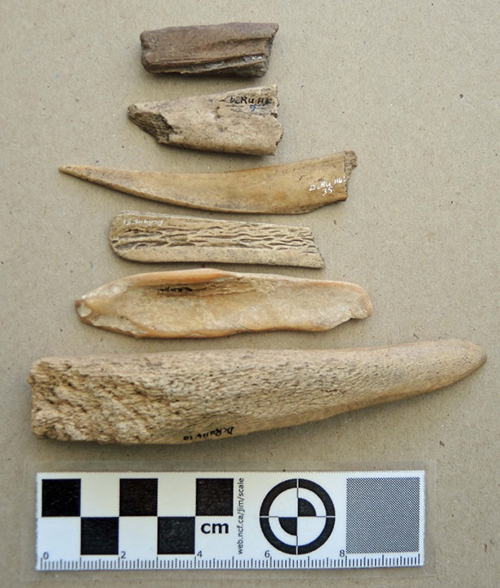
Figure 14. Bone and Antler tools. DcRu-116:101;9;35;51;26;10
DcRu-116:10. Antler tool. An antler wedge that has been sectioned and re-worked into a tapering point on the distal end. Could be used as a finer wedge or a fibre fabricating tool. Disturbed surface at Capital Iron. 12.1×2.3×1.7cm.
DcRu-116:26. Possible worked bone object. Mammal leg bone splinter. Water worn. May have extra use wear on one end. N 9.74 E18.33m DBD 84cm. 7.9×1.85×0.4cm.
DcRu-116:51. Spatula-like bone tool fragment. Use unknown. Heavily ground mammal rib with one end nearly complete, but split longitudinally along one side. Likely the proximal end of the unknown object. Kimta Road midden. (4.37)x(1.35)x(0.27)cm.
DcRu-116:35. Distal end of deer Ulna tool. Ground to pointed rounded tip. Kimta Road midden. (8.0)x1.4×0.3cm.
DcRu-116:9. Mid-section of the distal end of a deer ulna tool. N8.32 E20.35. DBD 40cm. (4.1)x1.9×0.7cm.
DcRu-116:101. Broken portion of a ground bone tool that has been graved to remove a section for other uses. N8-18m E18-20. DBD 0.50-0.60m. 3.8×1.5x.07cm.
Sub-class: Fabrication Tools. Abrading stones.
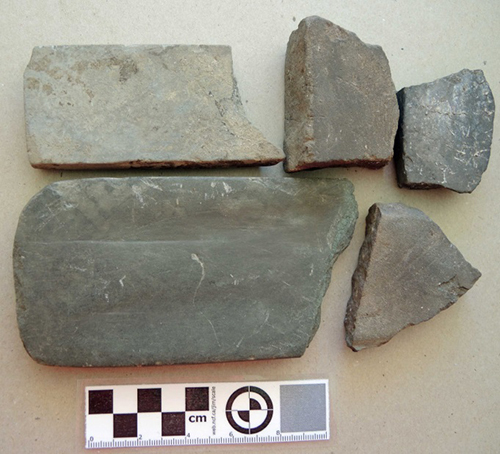
Figure 15. Abrading stones. DcRu-116:24;27;133;3;22.

Figure 16. Ground stone beach cobble. DcRu-116:25.
DcRu-116:39. Large abrading stone. Provenience: Kimta road dumped material. 19.3×16.0x4.6cm
DcRu-116:3. Abrading stone. Shale-like material. Portion of one end missing. Rectangular. Ground on both surfaces and sides, but very fine surface on one side with two shallow grooved areas. N8.408.55 E18.0-18.12. DBD 16cm. (14.3)x7.6×1.35cm.
DcRu-116:24. Abrading stone. Sandstone. Portion of one end missing. In tan-brown ash. Rectangular. Ground smooth on both flat surfaces and sides. N9.65 E19.48. DBD 77cm. (10.7)x5.1×1.4cm.
DcRu-116:27. Abrading stone fragment. Sandstone. Ground on both surfaces. N10-12 E19.15. DBD 80cm. (6.35)x(4.65)x2.7cm.
DcRu-116:22. Abrading stone fragment. Sandstone. Ground on both surfaces. N11.64 E19.55. DBD 64cm. (6.2)x(5.5)x1.5cm.
DcRu-116:133. Shaped abrader fragment. Ground on both surfaces and side. Kimta Road dumped material. (5.2)x(4.3)x1.6)cm.
DcRu-116:25. Ground portion of beach pebble. This was originally a naturally flattened and round edged cobble that was fractured into a few pieces. It may have been a larger complete ground cobble artifact that was broken. However, wear patterns extend over the two fractured edges showing that the stone was used after the original stone was fractured into portions. There is heavy grinding, mostly on one larger surface, of the portion of the original cobble that remains. The long side and to a lesser extent, the shorter end have been ground. There are numerous very fine scratches in all directions on the two smoothed and polished surfaces of this cobble. Its function is unknown, but it could be a rubbing stone for rubbing substances into and compressing wood, such as various practices in treating canoes. Provenience: N9.08 E.18.40. DBD79cm. (6.8)x(4.6)x(2.3).
Sub-class: Fabrication Tools. Hammerstone.
DcRu-116:23. Hammer stone. Elongate coarse sandstone cobble, pecking on one end. Provenience: N8-9.0 E18-20m. DBD 65-70cm. In ash, crushed shell and dark brown soil. 9.4×5.1×3.8cm.

Figure 17. DcRu-116:23. Sandstone Hammer.
Sub-class: Fabrication Tools. Worked stone flakes.
DcRu-116:20. Retouched stone Flake. One long side and the distal end of this flake are intentionally retouched to create a special use edge. This could have been used for shaving hard wood. N9-9.8 E19-20. DBD 60-68cm. 3.8×2.15×0.65cm.
DcRu-116:16. Use retouched flake. Fine grained grey chert. Tiny flaking on two edges suggest this may have been used as a scrapping tool. Given that it was found on the surface the damage on the fine edges could be a result of recent crushing. Provenience: Surface at the Capital Iron site. 3.9×2.8×1.15cm.
DcRu-116:41. Use retouched flake. A few areas of tiny flaking suggest this fine dacite flake may have been used as a scrapping tool. Provenience: Kimta Road midden.4.2×3.4×1.1cm.
DcRu-116:5. Flake with bifacial flaking on one side. Basalt. This is likely a flake fractured off a larger piece in an attempt to make a projectile point. N10.23 E19.20. DBD 38cm. 3.5×2.5×1.1cm.

Figure 18. Worked Stone flakes. DcRu-116:20;41;16;5
TEST
Sub-class: Debitage. Antler.
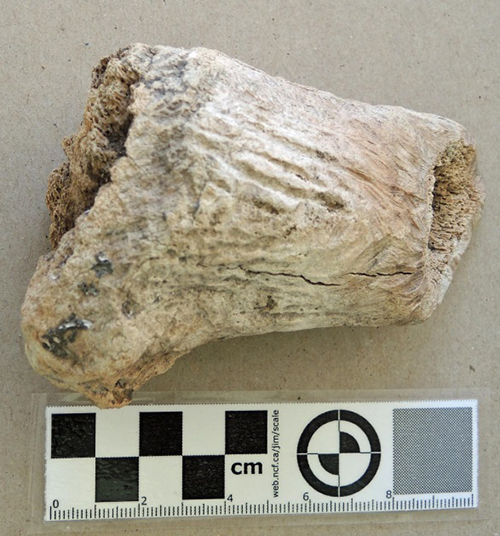
Figure 19. Worked elk antler debitage. DcRu-116:32.
DcRu-116:32. Antler. The base portion of an elk antler that has been chopped off and subsequently chewed by rodents. Disturbed surface deposits at Capital Iron. 10.4×7.7×4.1cm.
Sub-class: Debitage. Flaked Stone.
In urban areas, fine grained rocks crushed by machinery can be found scattered about, especially when used on pathways and fill around houses and in cement structures. It is not uncommon in this environment to find what falsely appear to be ancient flakes or cores discarded in tool manufacture. Since many of the items described here are from disturbed deposits – that is midden mixed with other material of unknown origin – we need to be cautious that some may be of more recent non-First Nations activity. Many of the flakes do have an old surface patina demonstrating that they are ancient. I have included two that I have determined are of a recent nature – numbers 11 and 30. Artifact no. 11 was found in the 0-30cm level of unit 2 – indicating some historic disturbance in this upper level.
From my own experience of collecting and flaking many thousands of stones from many sources in the greater Victoria Region, I am able to observe there are what I would call field cobbles and beach cobbles. Where the original outside cortex of the flaked basalt is present, field cobbles have a duller and mottled heavy patina on the outer surface as opposed to beach or stream cobbles which have smoothed surfaces and less evident outside patina. DcRu-16:49 and DcRu-116:46 are examples of the latter types. X-ray analysis is needed to see if these types have any compositional differences. One item, DcRu-116:128, is not flaked, but is a fire-exploded cubicle piece of fine basalt or dacite that may have been intentionally heat treated and intended as a core of raw material.
DcRu-116:46. Basalt Core segment. Original cortex on two sides. Field basalt based on surface texture. Kimta road dumped midden. 5.66×4.40×3.6cm.

Figure 20. Two types of surface texture. Mottled surface of field cobble (DcRu-116:46) on left and smoother surface beach cobble (DcRu-116:49.

Figure 21. Flakes with original cortex surface. DcRu-116:54:47:45:43:50:55.
DcRu-116:49. Basalt Flake with cortex on one side. Beach cobble based on surface texture. Kimta road dumped midden. 7.6×3.8×1.9cm.
DcRu-116:54. Flake with original cortical surface on one edge. Kimta Road midden. 3.4×2.7×1.3.
DcRu-116:45. This is a section of a cobble that has been formed by bi-polar percussion – that is, smashing one end of the cobble while the other end rests on a stone anvil. It is a very hard chert-like material. Kimta Road midden.
DcRu-116:47. Flake with most of the original cortical surface on one side. 5.16×3.36×1.35cm. Kimta Road midden.
DcRu-116:43. Large flake of basalt. Some original cortical surface. 7.4×4.1×1.1cm. 6.11×4.00×1.61. Kimta Road midden.
DcRu-116:50. Core segment with remnants of the original cortical surface remaining on one end. Provenience: Kimta Road midden.
DcRu-116:55. Large flake of basalt. Some original cortical surface remaining on one end and in small amounts of two thin edges. 4.6×4.1×1.8. Kimta Road midden.
DcRu-116:2. Basalt core segment. N 8.52m E18.19m. Upper level. 4.85×4.0x1.5cm.
DcRu-116:42. Basalt flake. Some recent edge crushing. 3.9cmx2.8cmx0.5cm.
DcRu-116:48. Basalt flake. Some recent edge crushing.
DcRu-116:53. Basalt flake. Some recent edge crushing.
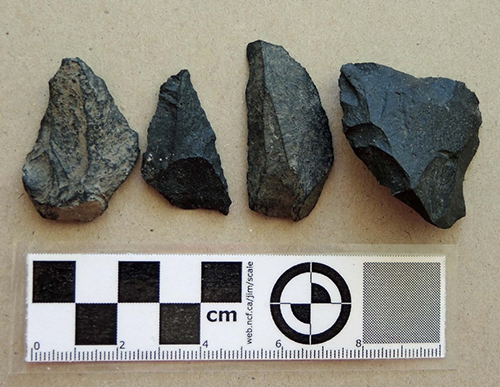
Figure 22. Stone detritus from Tool making. DcRu-116:42;48;53;2
DcRu-116:4. Small percussion flake that likely came off a core with the removal of larger flakes. Although it has a similar size as some micro-blades, it is not a pressure flaked micro-blade. Surface at Capital Iron site. 1.25×0.8×0.25cm.
List of Debitage within the DcRu-116:59-133 range.
In 1992, I extracted the following artifacts from the 1976 excavation level bags that were labelled as to provenience in the excavation units. Exceptions are numbers 129-132 from the Kimta Road midden that were originally lumped together as #49.
Measurements are not given, as anyone undertaking lithic analysis would want to measure the artifacts in a prescribed way and develop more specific descriptions of flake morphology. The majority of these are basalt, andesite and other volcanic rocks.
DcRu-116:64-65(Pit 1,Level 1, 10-20cm); DcRu-116:60(Pit 1, Lev. 3, 30-40cm); DcRu-116:66-67 (Pit 1, Lev. 4, 40-50cm); DcRu-116:101-107 (Pit 1, Lev. 5, 50-60cm); DcRu-116:59&76-88 (Pit 1, Lev. 6, 60-70cm); DcRu-116:121-127 (Pit 1, Lev. 7, 70-80cm); DcRu-116:117-120 (Pit 1, Lev. 8, 80-90cm); DcRu-116:89-90 (Pit 1, Lev. 10, 100-110cm). DcRu-116:100&128 (Pit 2, Lev. 2, 20-30cm); DcRu-116:61-63 (Pit 2, Lev. 3, 30-40cm); DcRu-116:68-75&133 (Pit 2, Lev. 4, 40-50cm); DcRu-116:91-99 (Pit 2, Lev. 6, 60-70cm); DcRu-116:108-116 (Pit 2, Lev. 7, 70-80cm).

Figure 27. Basalt core or raw material. DcRu-116:38.
DcRu-116:38. Basalt core or raw material. Large five sided core of coarse grained basalt. Flakes are fractured from two faces resulting from single impact point on the corner of one side. This could be a raw material sample that was tested by removing a flake or a piece of unworked raw material brought to the site in ancient times and subsequently struck once by modern machinery while being dug up. Kimta road dumped midden. 9.3×9.2×6.8cm.
Modern stone artifacts
Two stone artifacts are of a recent nature. DcRu-116:11 is a section of a quartzite cobble that has been formed by heavy bi-polar percussion. It was found in a disturbed level with historic materials. Modern commercial cement is still adhering to the rock. This appears to be a mechanically crushed rock that was inside a cement structure. N10-12 E18-20.DBD 0-30cm. 5.9×4.5×1.8cm. DcRu-116:30 is a small spall off of a large cobble that was removed with enormous force. Although spall tool artifacts are occasionally found in ancient sites, this one exhibits a large secondary outside spall and a crushed point of impact which is typical of recent machine crushed rock.

Figure 28. DcRu-116:11 & 30. Modern machine crushed pebbles.
Provenience: Kimta Road midden. 5.6×4.75×1.5cm.
Private Collection Artifact
In March of 1991, I observed shell midden at the west end of the parking lot located at the S.W. corner of Store and Chatham Streets. It had been exposed by large truck ruts. I observed a nephrite adze blade found by a private citizen at this location. The 9.5cm long adze blade had a cutting edge that was beveled mostly on one side with a slight bevel on the other. It measured 6cm across the cutting end and 3.4cm across the poll end. It was thickest, 1.4cm, near the cutting end and 1.2cm thick at the poll end.
Observations of DcRu-116 in 2014.
Midden deposits were found underneath a small building on Store Street when it was being torn down in 2014. This location was to the north of the 1976 excavation area. On November 20, 2014 I visited the site to examine and photograph the exposed shell midden. The upper portions of the midden were disturbed by historic non-First Nations activity, but the southern lower portions were intact.
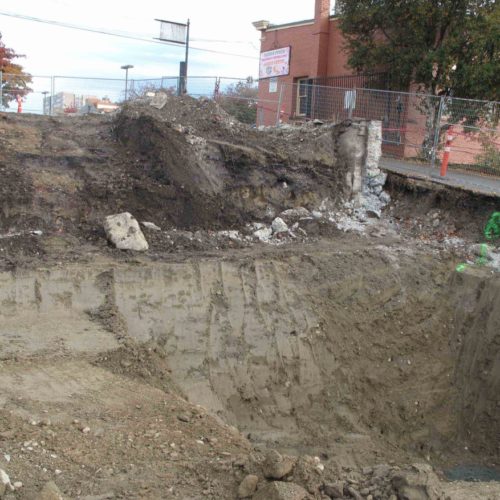
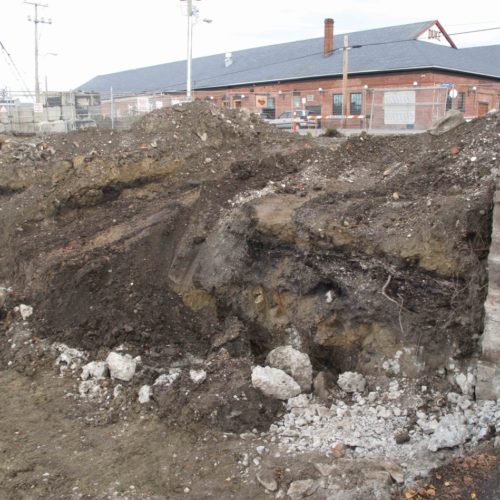
Midden Content Observations
Figure 32, shows a close-up of the shell midden which is composed mostly of native oyster shell. In a close examination of the exposed midden, I observed many small weathered beach pebbles (1-3cm) mixed in with the shell fish remains. There are no local inner harbour beaches that could be the source of these small pebbles. They are similar to the small pebbles that one often observes entangled in the roots of the Bull kelp (Nereocystis luetkeana), that has been pulled up either by storms or by people. I would suggest that these pebbles came to this site when First Nations brought large canoe loads of kelp that they processed on the site for making a variety of items. The long stalks of Bull kelp were dried and cured, and spliced or plaited together to make ropes, nets, and fishing, harpoon and anchor lines. Kelp bulbs were also used for liquid storage and for steam bending wooden fish hooks.
In 2014, Stantec undertook archaeological work on the site under alteration Permit 2014-0300. This work resulted in the removal of the last of the shell midden from the west side of Store Street.
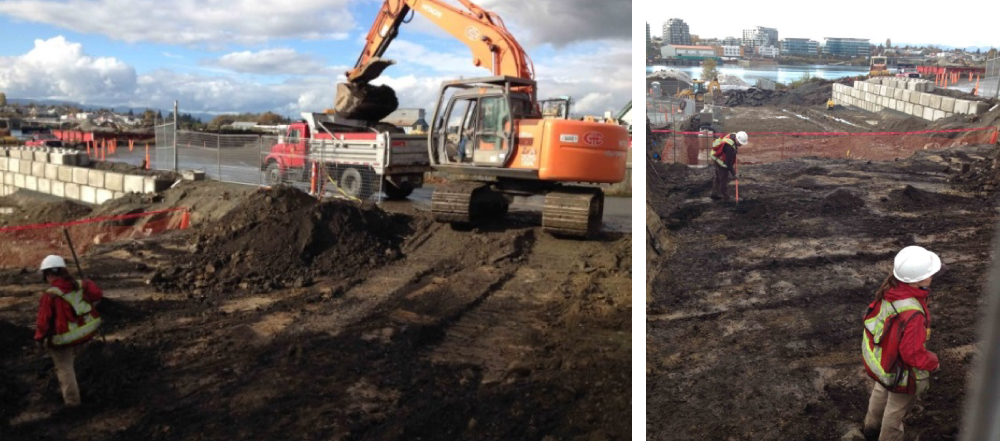
Figure 33. Stantec monitoring removal of Midden. Tom Bown photograph October 31, 2014.

Figure 34. Site location after archaeological monitoring and removal of cultural material. Grant Keddie photograph December 3, 2014.
Summary
The Capital Iron site, DcRu-116, is one of only three pre-contact archaeological sites in Victoria’s Inner Harbour. The other two are located on rocky bluff peninsulas at Raymur Point and Lime Point across from each other near the entrance to the inner harbour. The Lime Point site dating between 600 and 1200 years old is a known defensive site – having once had a trench embankment dug around the back end of the peninsula. The Capital Iron site was first occupied earlier around 260A.D. to 424 A.D. It is likely that the location of the Capital Iron site was chosen for both economic reasons and its defensive features – being high above the beach with a good view of the harbour. Modern development has now destroyed all of the Lime Point site and most of the Raymur Point site.
DcRu-116 has been heavily impacted by historic activities. The recovery of information has been piecemeal but has begun to build a story of the human activities that occurred here in the past. The recovery of more information from any intact midden will help to build a more complete picture.
Future archaeological work at DcRu-116.
The shell midden is now mostly or all gone from the west side of Store Street on the property around the Capital Iron Buildings. The low areas near the water are landfill on a previous embayment that will not contain any intact midden.
Portions of site DcRu-116 are known to exist under Store Street east of the Capital Iron buildings and extending, at least, onto the parking lot at the S.E. corner of Chatham and Store Streets. If some of this midden is still in-tact, it will be important to recover an adequate faunal sample that was not recovered in the 1976 excavations due to the rushed emergency nature of that project and also to get more radio carbon dates to provide a better time frame as to when the site was occupied. This site has the potential to be a valuable source of information on the history of Lekwungen peoples and their use of Victoria Harbour.
Appendix 1
Historic Disturbance of the Archaeological Site Location
Lot 114 adjacent to the south of the excavation area was owned by a J. Crow in 1861 (Victoria Archive tax assessment records). Extensive activities, modifying the landscape began in this area with the building of the two story stone warehouse of Dickson and Campbell & Co. on lot 114, with a wharf and other buildings adjacent (they later bought lot 113). The three foot thick walls were “built of granite, blasted from the adjoining primeval rock” (Colonist October 31, 1862 & September 8, 1863).

Figure 35. The Dickson and Campbell & Co building (later the Capital Iron building) on the far right in 1863.
In 1885, the location had become the Mount Royal Milling and Manufacturing Co. on lot 113 (two floors added) and Joseph D. Pemberton’s Royal Milling and Manufacturing Co. on lot 114. These properties later became part of the Capital Iron and Metal Company property at 1900 Store Street (an earlier address was 1832 Store Street).
It is likely that some intact midden still exists beneath Store Street and extending onto the properties east of Store Street on both sides of Chatham Street. Less disturbance of the landscape has occurred in the past on the south side of Chatham. I observed shell midden at this parking lot location in the 1970s when some shallow bulldozing activity was undertaken. A private citizen found a stone nephrite adze blade for a work working tool in exposed shell midden at this location.
On the north side of Chatham Street extensive disturbance occurred beginning in 1862, with development of the Albion Iron Works facilities. This included Foundry buildings, machine shops and a sequence of other buildings (see 1885 Fire Map for later changes).

Figure 36. 1885 Fire Map.
After the Iron works closed the railway was extended into this area (see 1957 Fire Map). Large amounts of land fill were dumped in the area, especially toward Government Street where bottle diggers, during the 1960’s and early 1970s, uncovered large amounts of refuge that came from the Brewery site on the other side of Government Street.

Figure 37. 1957 Fire Map.
In the 1970s, I was aware of an old lantern slide in the Royal BC Museum ethnology collection that I later identified as a Songhees First Nation. I based my information on the original field portrait catalogue of Paul Kane – created when he was at Fort Victoria in 1847 (Harper 1971:315-317). I did not know at the time the original sketch was missing, and this seemed to be the only image of it.

Figure 1. Photograph of a missing sketch by Paul Kane, 1906. Charles Newcombe. PN17161.
Figure 1, is No. 46 in Paul Kane’s portrait log: “Ska-tel-san – a Samas Tillicum with a (grass) hat that is much worn here south of de Fuca”, and in his Exhibition of 1848 he is listed as: “124 Sca-tel-son – a Songhes Indian, Vancouver’s Island” (Harper 1971:316 & 319).
A painting in the Royal Ontario Museum (ROM912.1.870) was made from this original sketch. Harper was led into miss-labelling the latter as “A Babine chief” (1971:265). There was a mix-up of information during exhibits of Kane’s work, where various writings and collection lists, rather than his original accurate field logs, were used as source information. Incorrect identifications in publications of Kane’s friend Daniel Wilson also contributed to the confusion in names.

Figure 2. Lithograph of painting of Sir Daniel Wilson, Published in 1862.
Lister in his Paul Kane/the Artist/: Wilderness to Studio (fig.58; 2010:301) and again in his editing of Wonderings of an Artist Among the Indians of North America (Plate 60; 2017: 242-243) labels this later painting (ROM912.1.87) as “A Babbine Chief. Tsimshian. Skeena River region, northwest British Columbia.” He records that the description is based on “A list of Pictures sent to Mr. G.W. Allan, March 6, 1856”. Harper’s speculation on this painting in his Catalogue Raisonne IV-587, is correct: “This canvas is probably based on an unlocated sketch. When lithographed for the frontispiece in the Wilson book, Prehistoric Man, the title was changed to “Chimseyan Chief” (Harper 1971:308).
Figure 2, shows a lithograph of a painting by historian and artist Sir Daniel Wilson copied from the missing Paul Kane original. This did appear in volume I of Wilson’s 1862 publication.
In the third edition (1876) of Volume 1, of Wilson’s Prehistoric Man, this person is noted as “Kaskatachyuh, a Chimpseyan” Chief”, where it is noted that Wilson drew it “from sketches by Paul Kane”. Wilson, in discussions about what are obviously Haida argillite pipes, refers to them as those of the “Babeen Indians”, and mentions, mistakenly (in the second part), that they are: “from a drawing made by Mr. Kane, during his residence among the Babeen Indians” (Wilson 1857:42). Paul Kane never went to the northern coast of British Columbia, and First Nation visitors from that region did not come to the Victoria area until after Paul Kane’s visit. A few First Nations from the central and northern coast of British Columbia did work at the Hudson’s Bay posts, but there is no indication that these were the source of Kane’s sketches.
In the mid-19th century, accurate writing about the First Nations of British Columbia was lacking. Kane’s historian friend, Daniel Wilson, kept current with the ethnographic literature of the times, such as the writings of geographer and ethnologist Henry Schoolcraft, but often lumped unrelated groups together or got their geographic locations wrong. Wilson was likely a strong influence on the use of First Nation names in the Paul Kane writings and exhibits.
This Songhees person in Wilson’s (1862, Vol. 1) frontispiece, is also the same person, but from the original Kane sketch in reverse image in my book (Keddie 2003:3). I have since realized that lantern slide RBCM PNH104 was mistakenly photographed in reverse. I have identified the person as Sketlesun, a Songhees from the old Cadboro Bay village. He is the 6th person on the Che-ko-nein treaty list of 1850. Because Sketlesun is wearing a Chilkat blanket and northern style hat, this image has been mistakenly labelled as a “Tsimshian chief” (Keddie, 2003:30). This style of Chilkat blanket was a valuable and high status trade item in the mid-19th century. Kane had purchased his own Chilkat blankets (see Lister 2010), but used designs from at least two different ones in his portraits.
In 1906, Charles Newcombe took, at least twelve, photographs of Kane paintings. In regard to three of these (not figure 1) that he published, he notes they are: “reproduced by kind permission of E.B. Osler, Esq, M.P., of Toronto, who owns the originals” (Newcombe, 1909:53). He also acquired copies of paintings that were used in Daniel Wilson’s, two volumes – Prehistoric Man: Researches into the Origin of Civilisation in the Old and the New World (Wilson 1862). Wilson made copies of several of Kane’s sketches for use in these and other publications.
I have now found the original negative from which Newcombe’s lantern slide was made (RBCM PN17161). Newcombe seemed to accept the naming of this image as Tsimshian because of the cape – not having access to Kane’s field catalogues at this time. It is clear that the photograph taken by Newcombe of Kane’s No. 46 portrait is a photograph of what Harper referred to as Kane’s “unlocated sketch”. I do not know where the original is, but this photograph might lead to its re-discovery.
Edmund Osler had much of his collection on loan to the University of Toronto from 1904, until it became part of the Royal Ontario Museum collection in 1912 (Harper 1971:35). We know that in 1906 Charles Newcombe was in Montreal visiting “Dr. Lowe” to see his collection on June 2, and the next day visited the Red Path Museum. On June 10, he was in New York and around that time visited the Field Museum of Chicago. Somewhere after Newcombe took photographs of the collection(s), the sketch of the Songhees man named Sketlesun, referred to in Kane’s portrait log, disappeared or lies unidentified in some collection.
References
Harper, Russell J. 1971. Paul Kane’s Frontier. Including Wanderings of an Artist among the Indians of North America by Paul Kane. Edited with a Biographical Introduction and a Catalogue Raisonne by J. Russel Harper. The Amon Carter Museum, Fort Worth, and the National Gallery of Canada, Ottawa, University of Toronto Press, Toronto.
Keddie, Grant. 2003. Songhees Pictorial. A History of the Songhees People as seen by Outsiders, 1790-1912. Royal B.C. Museum, Victoria.
Lister, Kenneth R. 2016. (Editor) Wonderings of an Artist Among the Indians of North America by Paul Kane. Royal Ontario Museum.
Lister, Kenneth R. 2010. Paul Kane/the Artist/: Wilderness to Studio. Royal Ontario Museum Press, Toronto.
Newcombe, Charles. 1909. Guide to Anthropological Collection in the Provincial Museum, King’s Printer, Victoria, B.C.
Wilson, Daniel. 1857. Pipes and Tobacco: An Ethnographic Sketch. Lovell and Gibson, Toronto.
Wilson, Daniel. 1862. Prehistoric Man: Researches into the Origin of Civilisation in the Old and the New World, McMillan, Cambridge.
There is an ancient archaeological shell midden – the refuse from what was once, at least, a seasonal camp on Raymur Point at the intersection of St. Laurence Street and Kingston Avenue. Raymur Point is a raised bedrock peninsula on the south side of Victoria’s inner harbour located to the west of Laurel Point and at the east end of Fisherman’s Wharf. The site was not occupied by First Nations in historic times and appears to have had a limited occupation in the distant past.

Figure 1. Western portion of Victoria’s Inner Harbour in 1878. Shoal Point in the foreground is the start of the inner harbour. Raymur Point can be seen as a small peninsula with a house on it at the centre of the right side of this lithograph. Close up of Bird’s Eye View of Victoria, 1878. RBCM PDP-02625 .
The midden location, known as Archaeological site DcRu-33, includes the extreme northern extension of the point and the shoreline along the wider section of the point extending along the west shore to the area around lots 1291 and 1292 on the west side of St. Lawrence Street.
The site is now mostly destroyed by the building and clearance of the large Texaco Oil storage tanks that were here until the 1980s (see figure 10), and the more recent building of apartment units. Midden may still be intact on some parts of the adjoining lots 1291 and 1292. The latter locations were not included in the last Archaeological work undertaken on the site in 1998 (Hewer 1998).
The original configuration of the peninsula can be seen in Figure 2. The large home just to the right of the centre of this photograph is still on lot 1291 near the corner of St. Lawrence and Kingston Street’s.

Figure 2. Raymur Point in the late 1890s. Richard Maynard Photograph. BCA A-3457.
An 1890s, close up of the northern tip of the Point can be seen in Figure 3. This shows the area of the (then) probably undisturbed midden. The midden eroding over the bank can be seen in Figure 4. I took photographs in March 1990, during the digging out of the foundations left over from the removed of oil tanks.

Figure 3. North end of Raymur Point at centre. The house on the right is located beyond the next small bay and not on Raymur Point. Close-up of RBCM F-9653.

Figure 4. Midden eroding out of a crevice.
The house on lot 1291 can be seen in figure 5. This photograph shows the west side of the site where only disturbed midden and extensive rock fill existed in the foreground in 1990. Figure 6, shows the north end of the site where midden can be seen slumping down the bank into a tiny embayment in the bed rock. It is below this area where I collected some of the artifacts.

Figure 5. The west side of the site in 1990, showing disturbed shell midden. Grant Keddie photograph.
The east side of the site is seen in Figure 7. This area was previously destroyed and now being dug up again. The northern tip of Raymur Point is on the other side of the bulldozer in the photo. The now destroyed Lime Bay First Nations defensive site, DcRu-123, can be seen across the harbour in the form of the knoll just to the right of the backhoe.

Figure 6. The north end of Raymur Point in 1990, before the condominium development. Midden can be seen eroding down the face of the bedrock. Grant Keddie photograph.

Figure 7. Looking North on East side of Raymur Point.

Figure 8. Looking east at the black midden on the outside of the cement wall.

Figure 9. The same bedrock area seen in Figure 6, after 25 years of erosion. Grant Keddie photograph, 2015.

Figure 10. Raymur Point covered with oil storage tanks. Keddie photograph 1986.

Figure 11. Raymur Point on right with dock on north end. Keddie photograph July 29, 1993.

Figure 12. Raymur Point as it looked on March 29, 2012. Looking east from the Fisherman’s Wharf Area.
The Midden Contents
On May 8, 1986, I observed that the shell midden was composed of mostly native little neck and butter clams, and some cockle clams and barnacles. This is not the unusual kind of mollusks found in other ancient sites in Victoria’s inner harbour and those further up the Gorge Waterway. The latter contain mostly native oyster shells.
The site contained many fire-altered rocks, scattered throughout the midden. These were traditionally used for steaming or boiling food. Most artifacts found in the site were stone waste materials, such as cores and flakes, resulting from the making of stone tools. These, the other limited artifact contents of the site, and the shallowness of the cultural deposits indicate that the location was occupied for a limited time, at least on a seasonal basis, around 2000 years ago.
A single human burial was recovered from the site in 1956, when constructing a cement wall. These remains were subsequently re-buried in the cemetery on the Songhees reserve. I located and talked to the bulldozer operator who worked on the site in 1956. He told me that the burial was in a flexed or fetal position. He observed that most of the midden was concentrated toward the east of Raymurs Point, where midden can still be seen eroding down the bank today.
On May 7, 1991, I examined the excavation trench for a waterline installation around the north side of the centre line on Kingston and St. Lawrence. There was no midden under St. Lawrence Street in front of 1293, 1292 and 1291 lots or under the Kingston Street and St. Lawrence intersection.
The Artifacts
Artifacts were sporadically collected from the surface of this site from 1956 until 1998, when the first formal site evaluation was undertaken that involved the excavation of test pits. Museum employee Micheal Kew recovered bone artifacts DcRu-33:1-2 in 1956. #1 is a portion of a ground bone that is broken at both ends. It was likely a fish hook barb; #2 is a mid-section of a deer femur with ends that were sectioned through but have extensively weathered, making it difficult to see if it might have been cut with an iron hacksaw. Butcher shops in 19th century Victoria often sold deer and elk meat. The way this bone is cut is similar to others found in historic garbage dumps, and not like those found in ancient aboriginal sites (Figure 12).
Don Abbott and John Sendey of the (then) Provincial Museum, surface collected artifacts DcRu-33:3-17. These included #3, a sawn section of a deer femur bone; #4 is a unique side indented projectile point, likely for use as a point on a spear as it is too large for an arrow point. It is a flaked basalt point that is heavily ground on both sides from the notched area near the bottom to near the top or distal end (Figure 11). #5 is a fragment of a burnt sandstone abrader; #6 is a naturally fractured basalt cobble, but is of stone tool making quality and may have been brought to the site location; #7 is a small section of a mammal bone with grinding of one edge.

Figure 11. Projectile points. Left to right. DcRu-33:4. Corner indented point. Possibly for small spear. DcRu-33:21. Unfinished projectile point that was broken during manufacture. DcRu-33: Small portion of what was once a large hexagonal slate spear point.
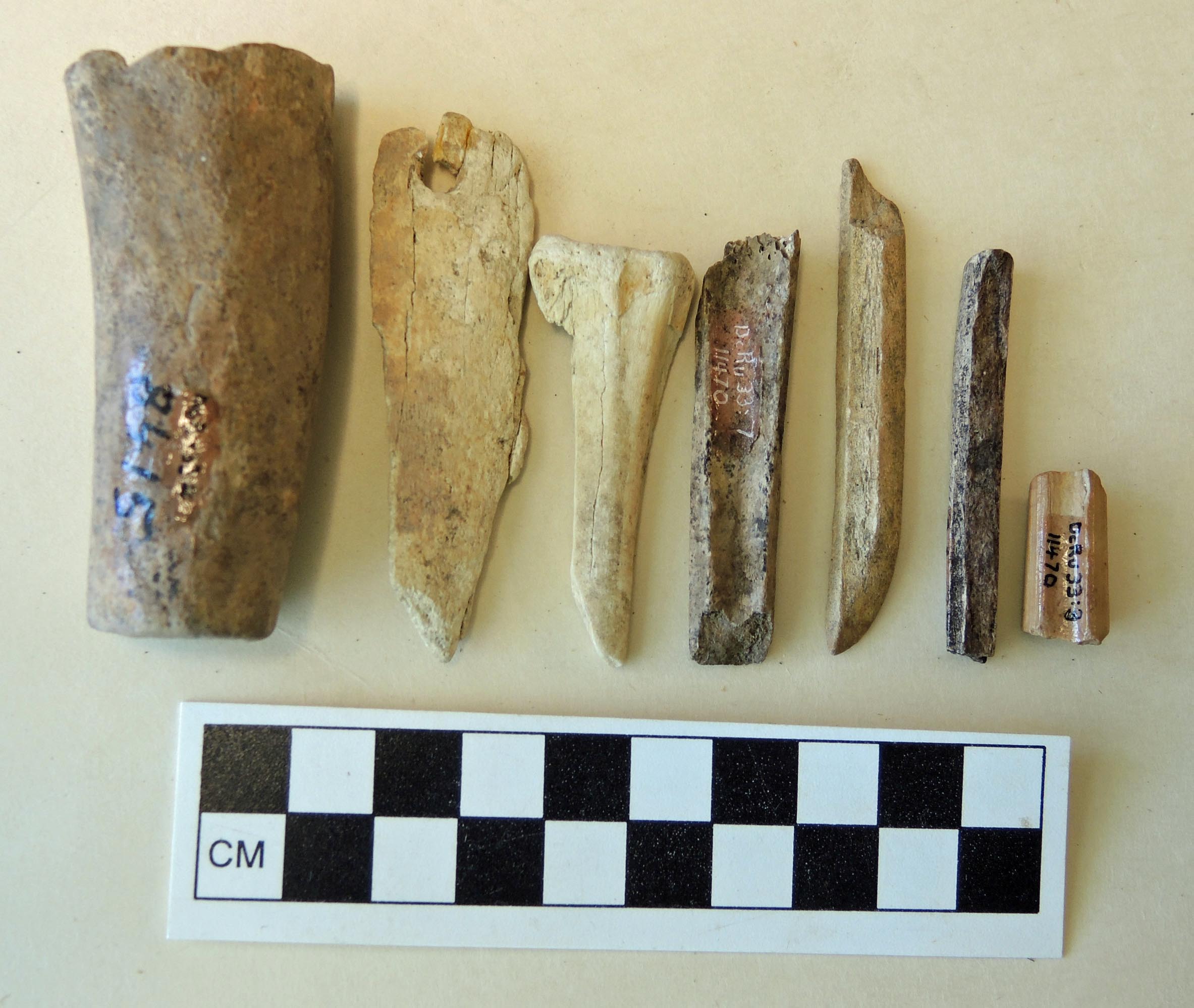
Figure 12. DcRu-33:3. Sawn and ground section of mammal bone. DcRu-33:20. Fragment of ground bone tool with drilled hole. DcRu-33:19. A non-artifact. Unworked deer cannon bone.DcRu-33:7. Section of a mammal bone with grinding of one edge. DcRu-33:9. Portion of a split deer cannon bone, ground on one end. DcRu-33:1. Portion of a bone fish hook barb.
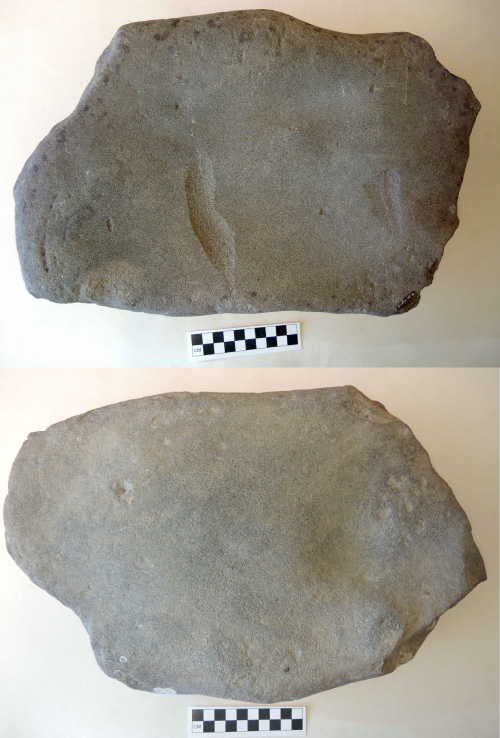
Figure 13. DcRu-33:16. Two sides of a large block sandstone abrader.
#8 and #18 are very small siltstone beads. These types of beads are only found in sites pre-dating 1800 years in this area; #9 is a portion of a split cannon or lower leg bone of a deer which is ground on one end; #10 is a broken portion of what was once a large thick hexagonal slate point. This type of point, like the stone beads, is not found in sites dating in the last 1700 years in this area; #11 is an extremely fine flat bar shaped abrading stone ground on both surfaces; #12 is a thicker rectangular sandstone abrader ground on two sides.
#13 and #17 are large fractured beach cobbles from the disturbed surface of the midden. It is possible that they are both rocks smashed by heavy machinery working at the site during the time that the large Texico oil tanks were installed on the property. This is a common pattern I have observed in urban areas around construction sites. The edge damage does not suggest that they were used as cobble choppers and the flake patterns are inconsistent with intentional human flaking patterns for this type of raw material. The type of stone is not the same as that found in the flakes at the site, which suggests they are not cores from which intentional flakes were removed (Figure 16).
#14 is a stone flake with the original cortex on one side; #15 is the mid-section of a very fine abrader with similar dimensions to # 11; # 16 is a very large block sandstone abrader that has been heavily abraded on both sides. This is an artifact that may have been used to grind items such as shell, slate or wood. Barnacle attachments indicate it was found on the beach (Figure 13);

Figure 14. Bottom row L. to R.: DcRu-33:12. Rectangular sandstone abrader. DcRu-33:5. Triangular portion of a course grained abrading stone. DcRu-33:11. Smooth, shaped slate abrader. Top: DcRu-33:15. Fragment of shaped sandstone abrader. DcRu-33:14. Stone flake.
On December 4, 1986, I found artifact #s 19 to 21 in disturbed midden on the surface at the north end of the site. #19 is an unworked deer cannon bone; #20 is a fragment of a mammal bone tool. It is a broken flat piece of bone with a bi-conically drilled hole near its intact end. This is possibly a netting needle fragment; #21 is a portion of a bifacial tool that was started, but broken during manufacture and not finished.
On May 8, 1986, I found 103 stone flakes eroding out of the midden and fallen on the beach at the edge at the north end of the site. #22 includes a group of 35 stone flakes with no original outer cortex – indicating they are secondary flakes struck after the outer cortex of the original stone was removed; # 23 includes 68 stone flakes with remnants of the original outer cortex of the rock. Another eight flakes I collected from disturbed surface midden on February 15, 1991, included 6 with portions of the cortex and two without. This assemblage indicates a practice that likely involved collecting local cobbles and flaking them in the process of tool making on the site.
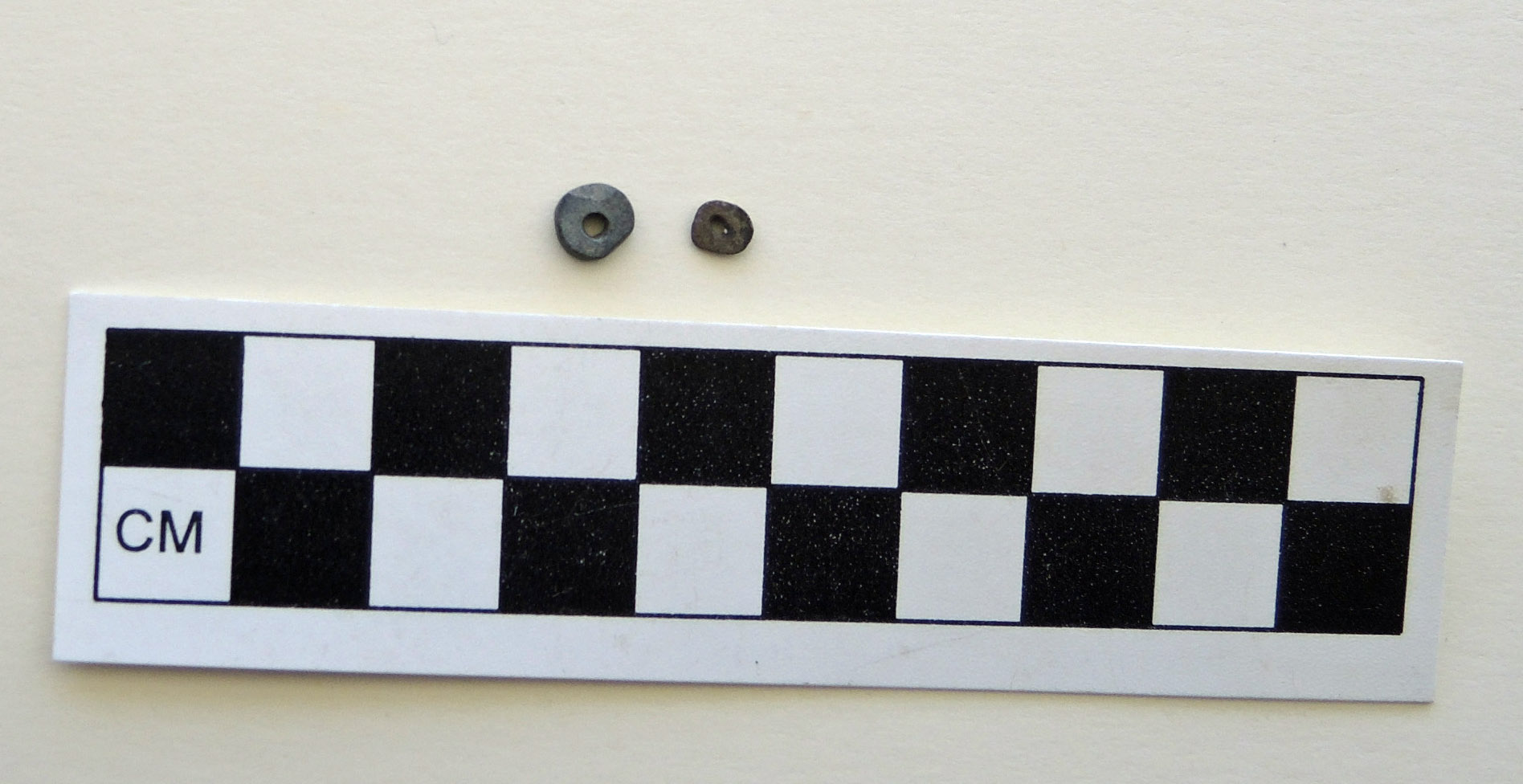
Figure 15. Small flat siltstone beads. DcRu-33:8(6mm diameter). DcRu-33:18 (5mm diameter).
I. R. Wilson Consultants Ltd., working under permit in 1998, recovered 23 stone flakes in excavation test pits and in disturbed midden areas. #24a included 8 stone flakes and #24b to # 38, another 25 stone flakes.
None of the flakes from this site show any signs of intentional secondary flaking or unintentional use wear. Some slight breakage on a few very thin edges is not a produce of tool use but of tool manufacture.

Figure 16. DcRu-33:17 and DcRu-33:13, are large fractured stone cobbles. DcRu-33:6. A naturally fractured basalt cobble.
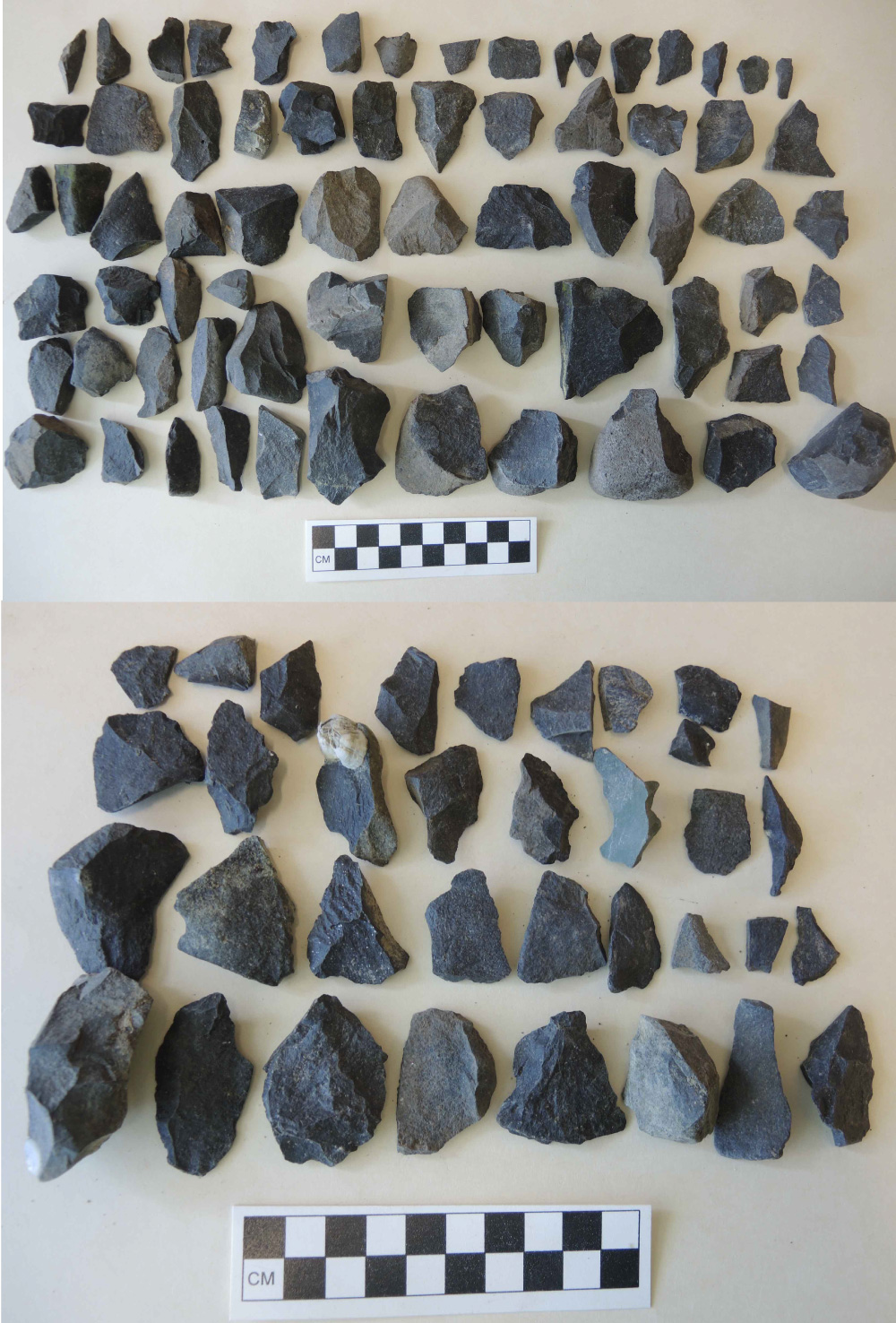
Figure 17. Top: DcRu-33:23. 68 stone flakes with portion of the original outer cortex of a stone cobble. Bottom: DcRu-33:22. 35 secondary flakes.

Figure 18. Left: DcRu-33:24b-38. Stone flakes collected by I.R. Wilson excavations in 1998. Right: DcRu-24a. 8 stone flakes collected by author in 1991.
References:
Hewer, Tony. 1998. Archaeological Inventory and Site Evaluation 129 Kingston Street, DcRu-33, Victoria British Columbia. Heritage Conservation Act Permit 1998-050.I.R. Wilson Consultants Ltd. Prepared by Tony Hewer.
CETA 1972 style post
While working with archival documents it is always of interest to look at the other side of the page.
In today’s example, A person needed to publish several legal notices in the local paper.
Luckily, the entire newspaper page was submitted.
The following article appeared on the back of the page (The Province [Vancouver], Friday, 10 November, 1972.)

It describes how Pacific Western Airlines was able to ship live beef to Europe, because its cargo plane could return with a cargo of grapes which were now available throughout BC and Alberta.
The article also explains how the plane was cleaned, presumably before the grapes were loaded on to the plane.
The Wikipedia page for PWA mentions the following:
Boeing 707 equipment was added to the fleet in 1967… The addition of a cargo model Boeing 707 meant that livestock and perishables could now be carried all over the world, and the name Pacific Western became synonymous with “World Air Cargo”. The company aircraft visited more than 90 countries during this period of time.
Pacific Western operated a worldwide Boeing 707 cargo and passenger charter program until the last aircraft was sold in 1979.
This is in the era where container shipping was beginning its world wide adoption.
Air cargo was expanding during this time as well, when “Boeing launched the four engine 747, the first wide-body aircraft” in 1968.
As the newspaper report explains, transportation of people and goods only makes sense if the airplane is loaded to maximum capacity at all times.
This was the thinking behind the Triangular trading system of the 19th century.
Moving people extended this thinking to modern day hub airports such as Toronto Pearson, London Heathrow and Dubai UAE.
Even today with airplanes that can travel half way around the world, the take off and landing locations are the national hub airports.
Air cargo has undergone the same thinking.
In the 1972 news report, it only made sense to Pacific Western Airlines to undertake this one-off trip once the entire route was fully booked.
The article goes on to describe how the airline was looking for other opportunities. They recognized the potential, but the tipping point (the development of an airport hub for cargo) had not yet arrived.
To see what kind of completion PWA would face today simply go to an airplane tracking app and filter for FedEx planes, or track the Memphis airport.
UPS has a similar hub in Louisville. Here is an example of one airplane in the UPS fleet that revisits the hub city regularly. This particular plane left Louisville on 28 May 2017 and travelled around the world via Honolulu, Hong Kong, Dubai, Cologne, and Philadelphia, before returning to Louisville three days later.
When you read this article, there will probably be more recent examples of round the world trips or forays to Asia or Europe before returning to it’s home base.
The article does not quote anyone from the BC Livestock Export Association, however Europe is again front of mind for the Cattlemen’s Association.
Mr. W. Allan Eadie produce manager for Woodward’s, and PWA cargo specialist Ken Bjorge would be impressed!
As Mister Eadie says in the report, he hoped that this operation would expand because of “this cattle thing.”
He and Mister Bjorge may have failed to realize that the problem was not to solve the “cattle thing.” They needed to solve the “hub thing.”
On a side note, The Imax movie “Living in the Age of Airplanes” has an excellent section on the transportation of flowers that is well worth the price of admission.
PWA purchased CP Air to form Canadian Airlines International in 1987.
Canadian Airlines has the distinction of being the first airline in the world to have a website on the Internet (http://www.cdnair.ca/).
It merged with Air Canada in 2001.
Inspired by the Landscape

Figure 1. Viewfield Farm at Macaulay Point, in1854. The farm extended along the southern water front from Saxe Point in Esquimalt, to Lime Bay in Victoria West and across the peninsula to Selkirk Waters.
As Donald Macaulay with his Tsimshian wife Margaret and the first four of their six daughters Mary, Flora, Catherine and Sarah, gazed out at the beautiful ocean view and the fields draped with blue camas, he must have been reminded of his native home on the Scottish Isle of Lewis. It was 1850, and Macaulay was bailiff of the new 600-acre Viewfield Farm owned by the Puget Sound Agricultural Company.
Macaulay could hardly have known that this landscape would one day be named after him. Or that it would become a popular military camp in the late 1890’s, where Victoria’s citizens flocked to witness regimental demonstrations.
Macaulay Point was first named Sailor Point in 1847, but the Hudson’s Bay men called it Macaulay Point in 1851 and this was made official by the surveys of Captain Richards in 1859.
With the building of the military base and houses, the Macaulay Plains disappeared. But a visit to Macaulay Point reveals the large defensive structures that were still being used in the Second World War. Less visible are the three ancient archaeological sites in Fleming Bay.

Figure 2. In 1878, based on the belief of a threat from Russia, an Earthwork Battery was built at Fort Macaulay. Later, in 1887, the old earthworks were dismantled and new six-inch disappearing guns were installed. These were used during both world wars. (Robert Kidd photograph, 1959; RBCM, Archaeology Collection.).
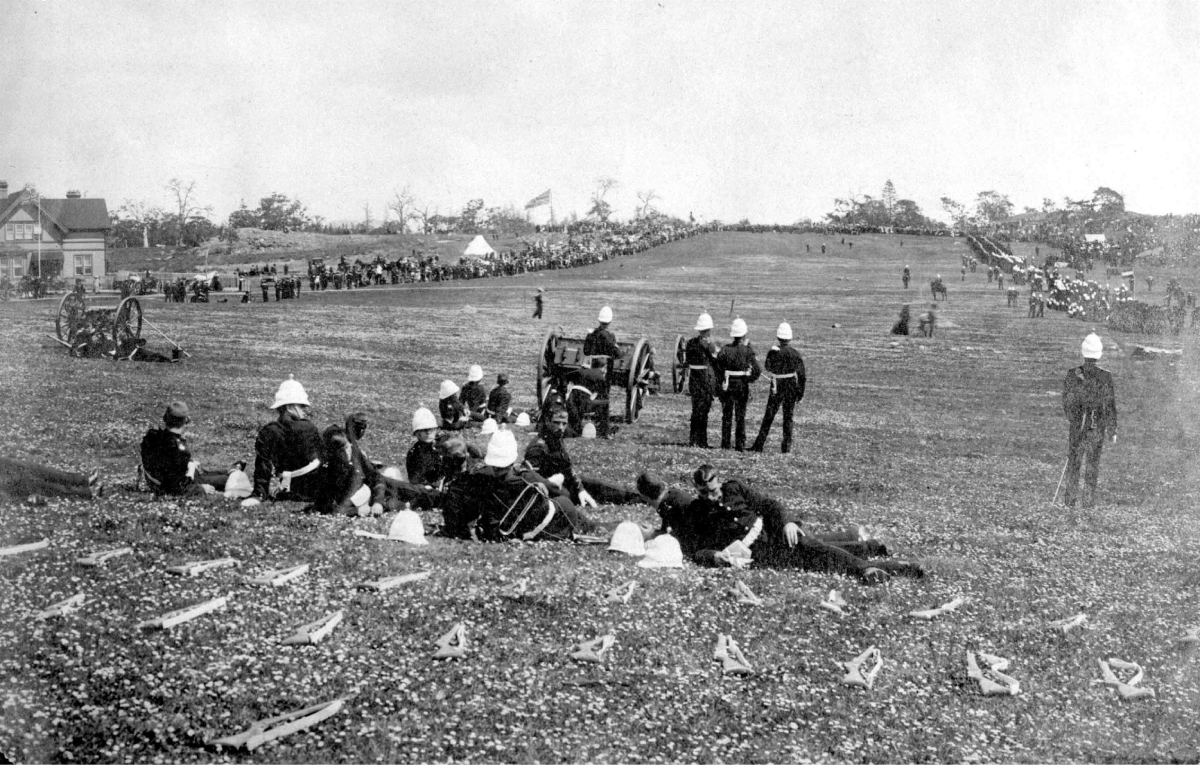
Figure 3. Crowds of people witnessed the performances of the British Columbia Provincial Regiment of Garrison Artillery on Macaulay Plains, about 1885. (RBCM A-03131).
First Nations cultural features
Macaulay Point was known as Mukwuks by the Lekwungen First Nations on whose traditional territory it was located. Today the Lekwungen are represented by the Esquimalt and Songees Nations. In 1952, Songhees elder Jimmy Fraser indicated that Mukwuks was once the location of a salmon reef net fishing station. The stone seen here in figure 4 is a net weight or anchor stone found by divers on Macaulay reef.
Divers also found piles of larger, unmodified rocks used as anchors on the reef net. Every year the kelp rope holding these anchors would be cut, and they would be left behind. This shaped rock would have been one that was retrieved after use, but in this case was probably accidentally lost.
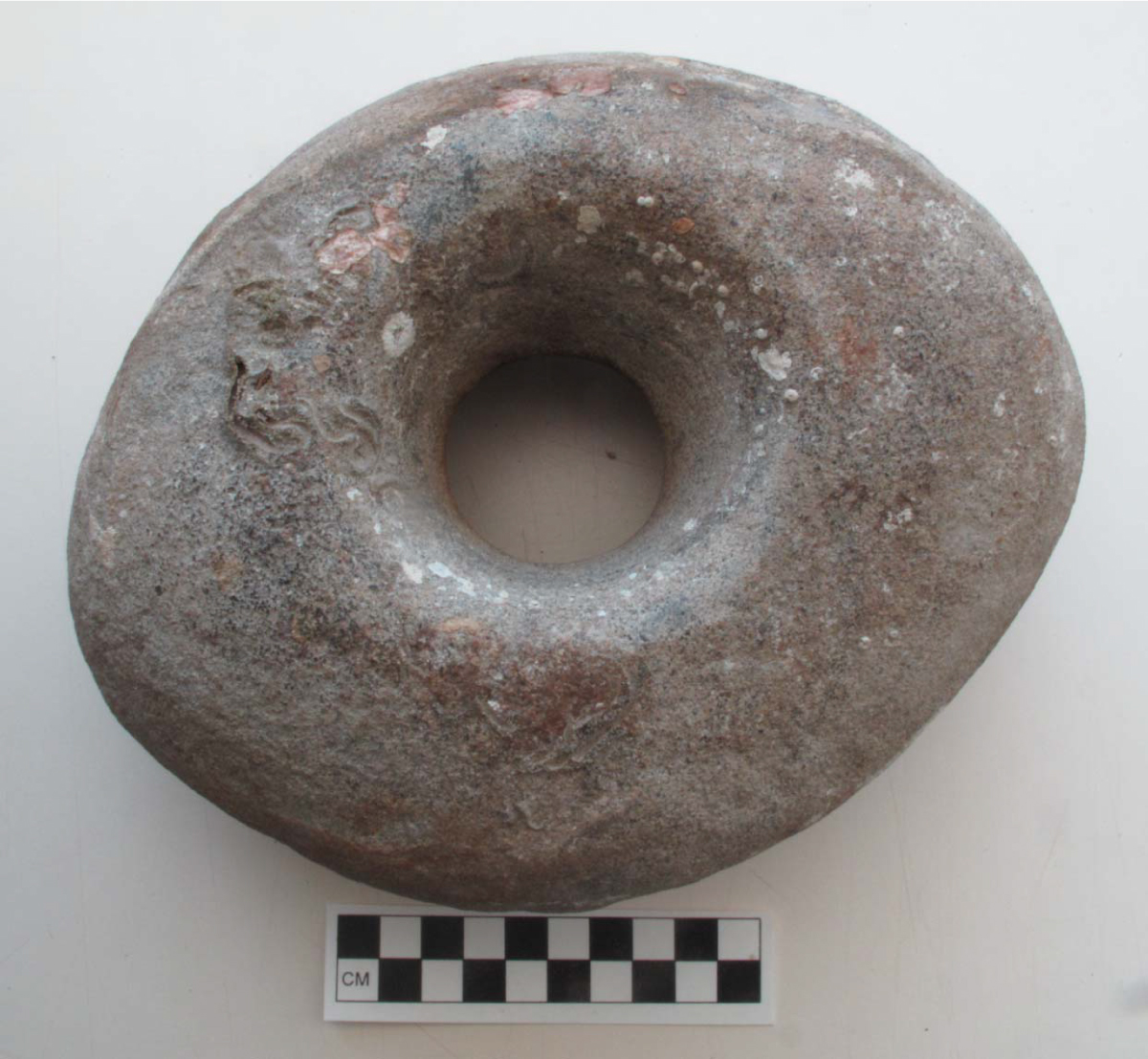
Figure 4. This shaped rock was used as a net sinker to hold a reef net down between two canoes. It weighs about 4 kg or 9 lbs (RBCM. DcRu-Y:96).
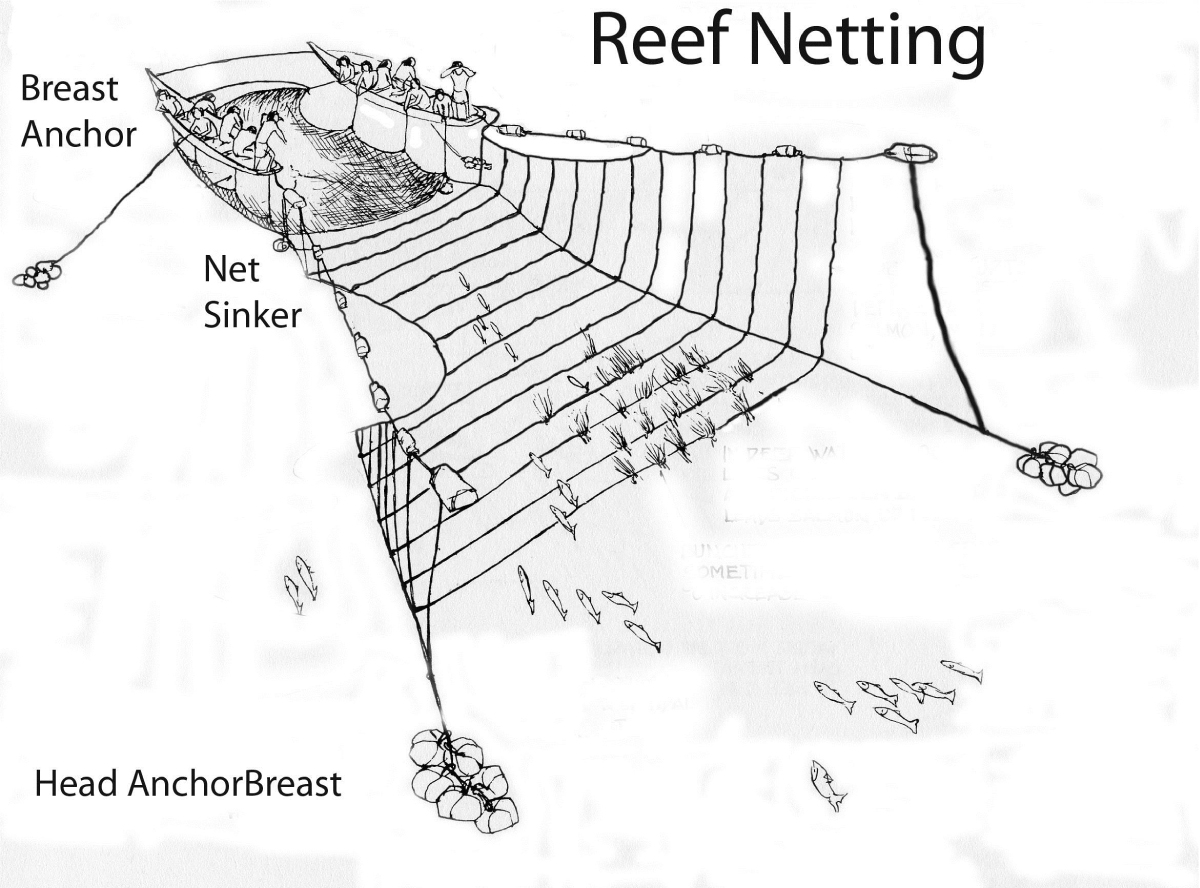
Figure 5. On reefs where the salmon came close to shore, this type of net was placed in a pathway cut into the kelp beds. When the fish were above the mesh net, it was pulled up by crews in boats on each side. (Re-drawn after Hilary Stewart 1977:94).
The oldest archaeological site in Esquimalt
Between about 5000 and 11,000 years ago, all of the many archaeological sites in bays around Esquimalt, were dry land. As the sea level rose to near its present height about 4,200 years ago, we find evidence of First Nations living at Fleming Bay.
A large shellmidden stretches across the back of the bay, containing shellfish remains, bones, artifacts and other evidence of past human behaviour. It is one of two equally old Archaeological sites in the municipality of Esquimalt. It dates to the same age as a shellmidden under the Tillicum Road Bridge. Much of the site has now been destroyed, but there are still portions intact.
The location was a camp, used at least on a seasonally basis, at various times starting 4200 years ago. On both ends of this large site were two later period shellmiddens identified as aboriginal defensive locations – used in times of warfare.
Defensive sites are often located on a raised peninsula with an intentionally dug trench across the back of the peninsula. The dirt was mounded up on the inside of the trench and wooden palisades placed in the inner rim of the trench.
This peninsula, extending out from the main shellmidden site was occupied at a later time period than the older deposits of the main site. This was a defensive location where about 800 to 1000 years ago a trench was dug across the back end of the peninsula.
A second defensive site was located on the south side of Fleming Beach. Shellmidden deposits once occurred from the tip of the small peninsula that once formed the south side of Fleming Bay and extended eastward along the Bay to the ”Climbing Wall”.
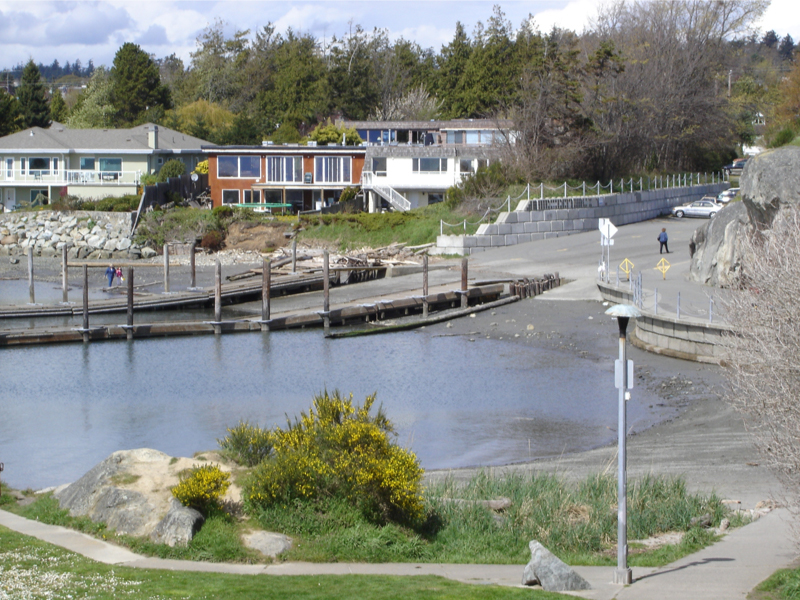
Figure 6. The ancient shellmidden at Fleming Beach once extended west from the high rocks on the east side of the Esquimalt Anglers Association boat ramp. Much of it has been destroyed by the boat ramp and housing development. The “Climbing Wall” is on the far right (Grant Keddie, 2006).
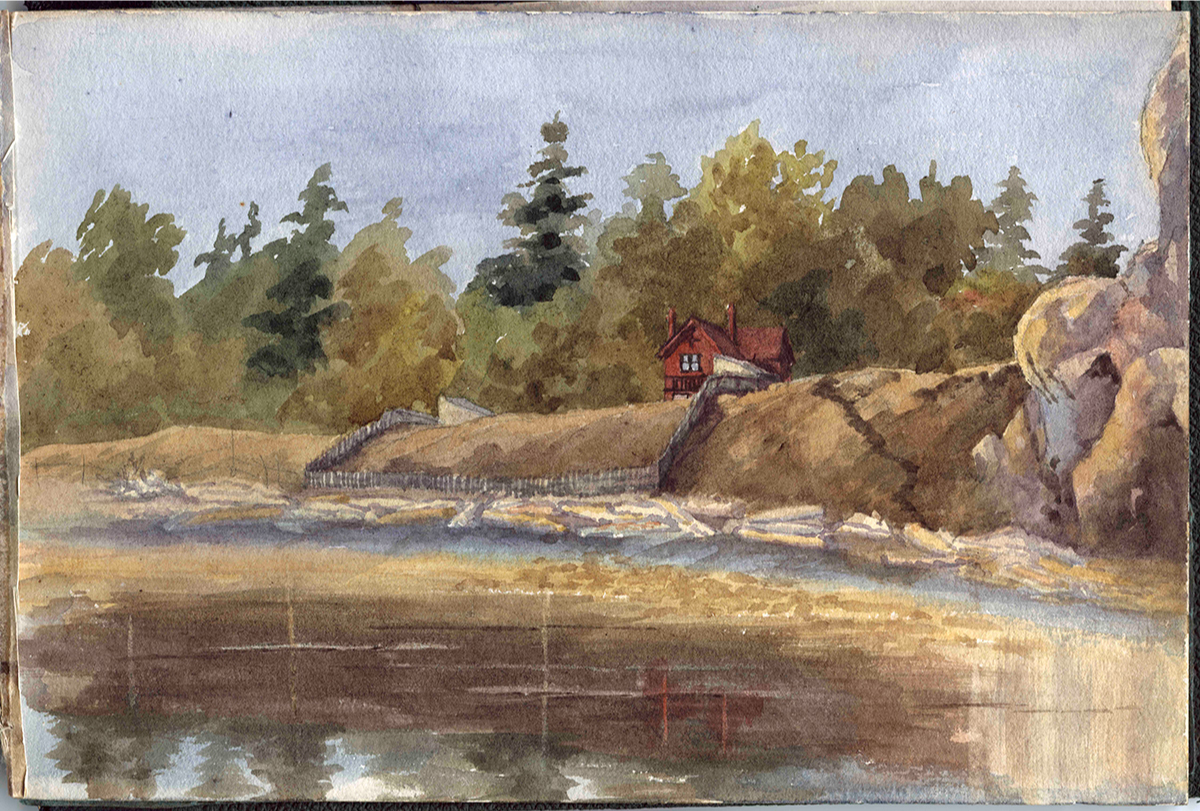
Figure 7. The beach is named after the family of photographers’ Harold and Edgar Fleming, who built their house, Viewfield, here in the 1880s. This 1896 painting shows the house above what is now the boat launch, before three metres of soil and shellmidden were removed. The rocks on the right are now a popular climbing wall. (RBCM; PDP4171).
Fleming Beach shellmidden
The archaeological sites at Fleming Bay were known since the 1890s, but officially recorded by Robert Kidd for the Provincial Museum in 1959. He took a series of photographs at that time which allow us to see the recent changes that have occurred.
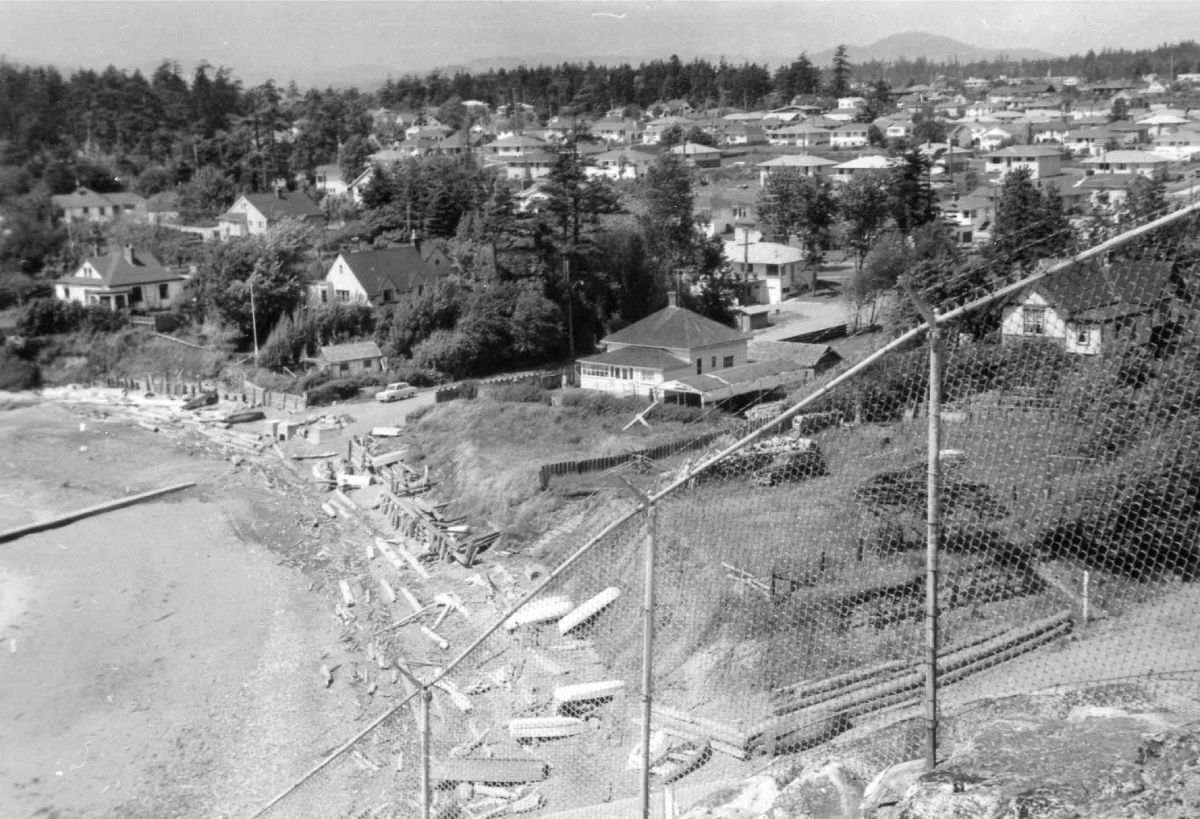
Figure 8. Archaeological site DcRu-20. Looking down over the boat ramp at Fleming Beach, toward Kinver Road in the background. (Robert Kidd photograph taken in 1959. RBCM, Archaeology Collection).
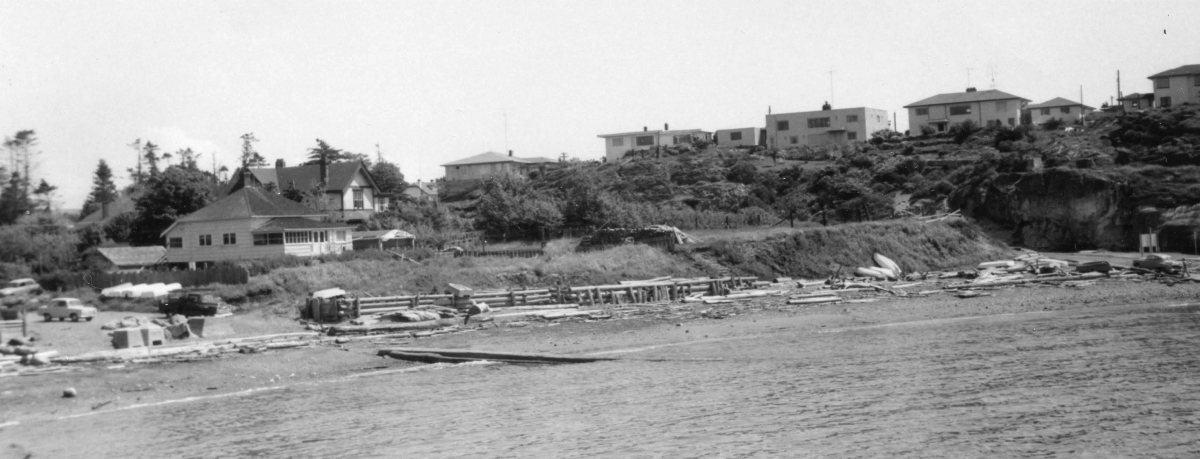
Figure 9. The raised shellmidden bank can be seen across the back of Fleming Beach. Kinver Road is on the far left and what is now the climbing wall on the far right ( Robert Kidd photograph. 1959. RBCM, Archaeology Collection).
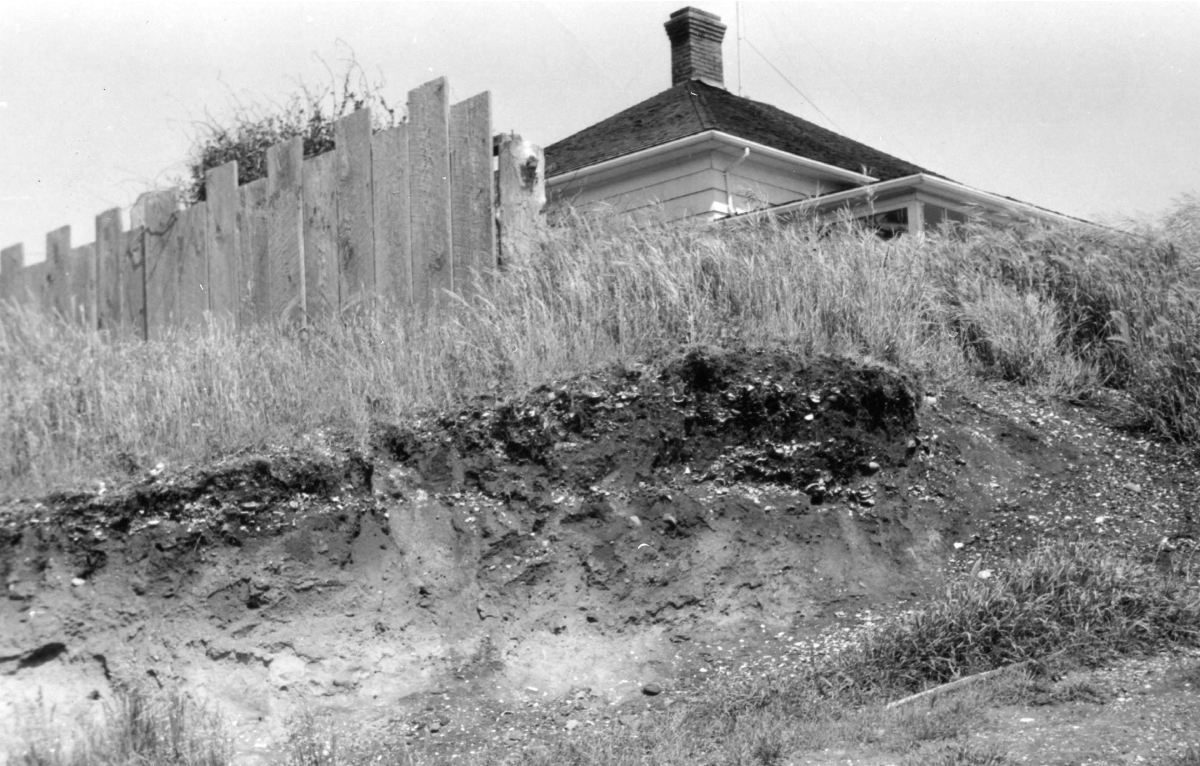
Figure 10. The cultural debris that made up the shellmidden at Fleming Beach was once up to two metres deep. (Robert Kidd photograph 1959. RBCM, Archaeology collection).
The western defensive site
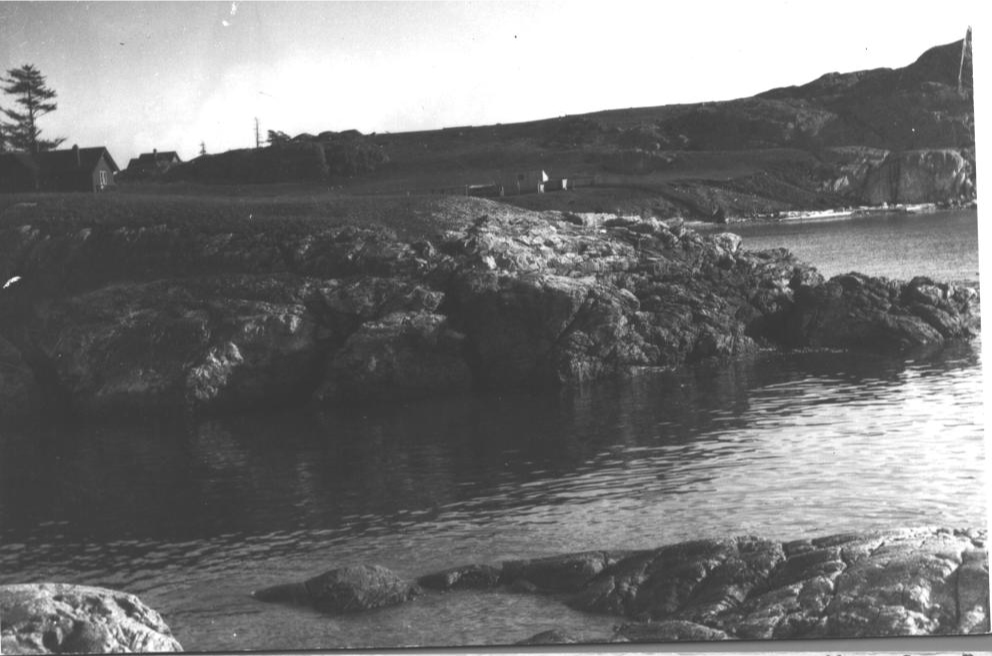
Figure 11. Looking across the aboriginal defensive site on the west side of the back of Fleming Beach, in 1901. The present day Esquimalt Angler’s Association ramp is on the distant right next to the exposed climbing Rock. (Charles Newcombe photograph; RBCM, Ethnology Collection, PN139).

Figure 12. Remnants of a defensive trench that once cut across the back of the peninsula of the site, in 1928. The climbing wall can be seen at the centre of the photograph in the far background. (William Newcombe photograph; RBCM, Ethnology Collection, PN169).
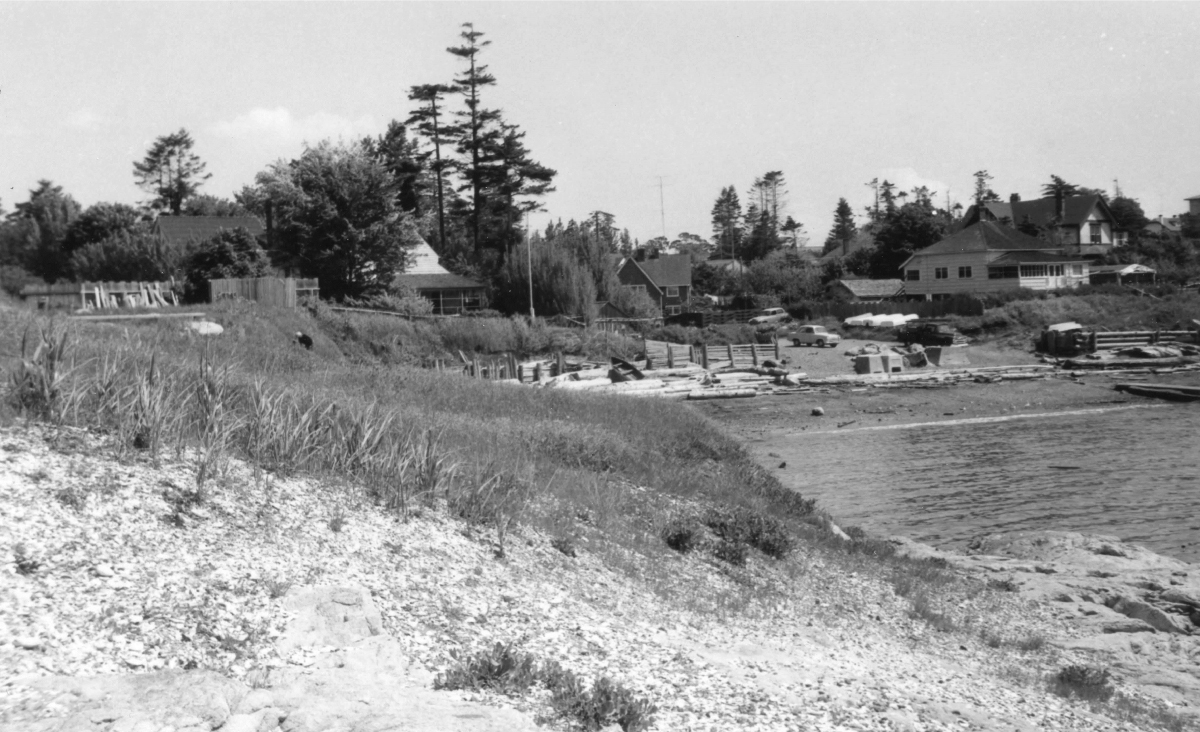
Figure 13. Looking across the south end of the defensive site seen in figures 11 and 12. Shellmidden can be seen eroding down the slope. (Robert Kidd photograph; RBCM, Archaeology Collection).
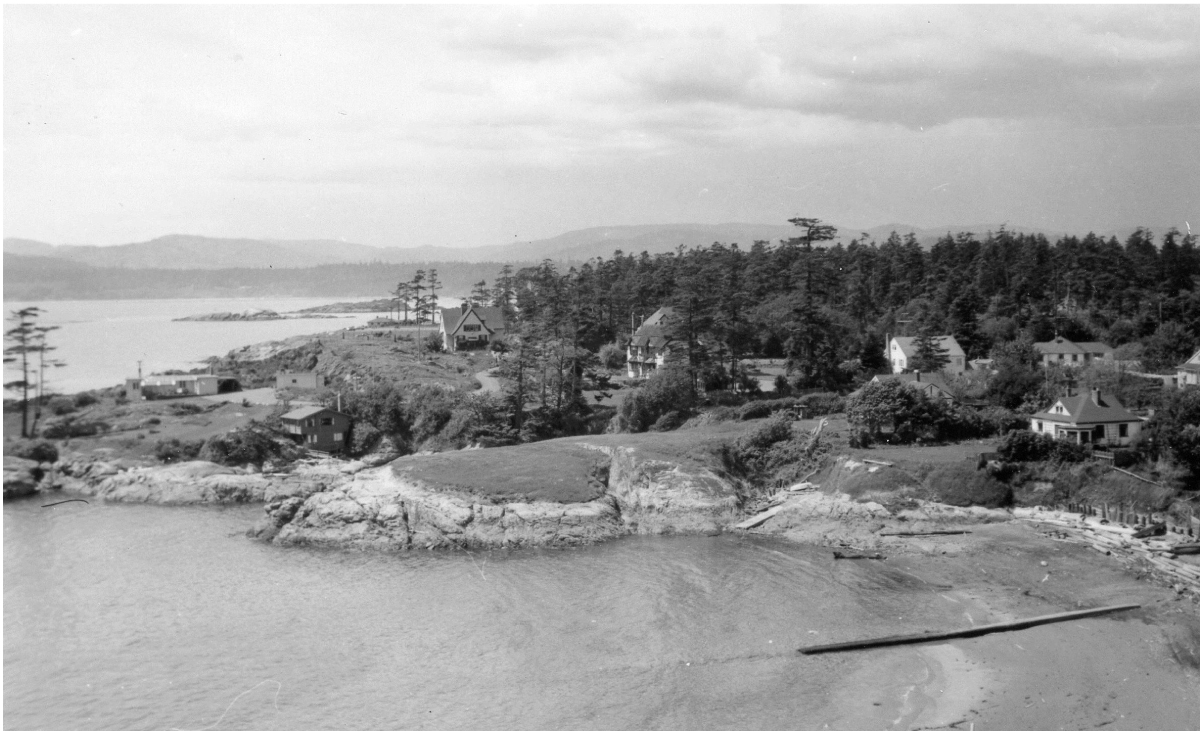
Figure 14. The Aboriginal defensive site on the west side of Fleming Bay is on the peninsula at the centre of the photograph (Robert Kidd photograph 1959; RBCM Archaeology collection).
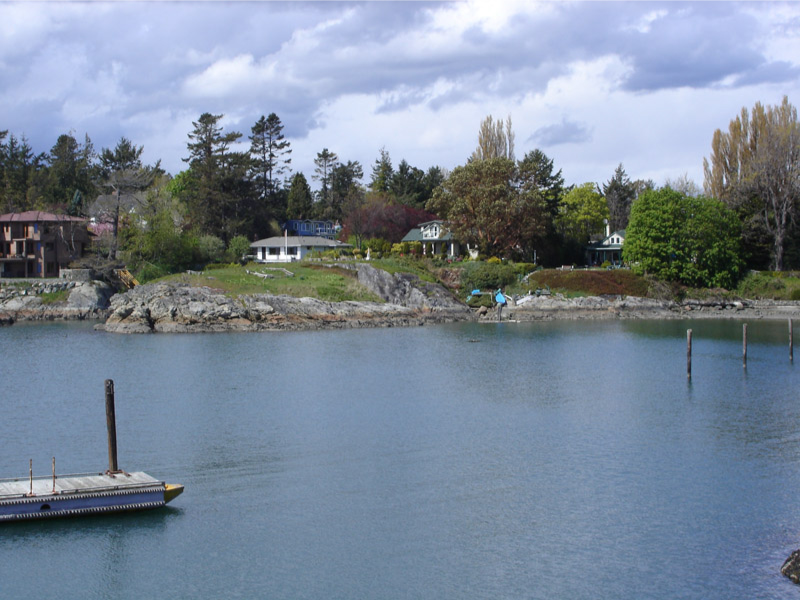
Figure 15. Looking across Fleming Bay to the Aboriginal defensive site at the left of the centre of the photograph, 2006. (Grant Keddie photograph).
The southern defensive site
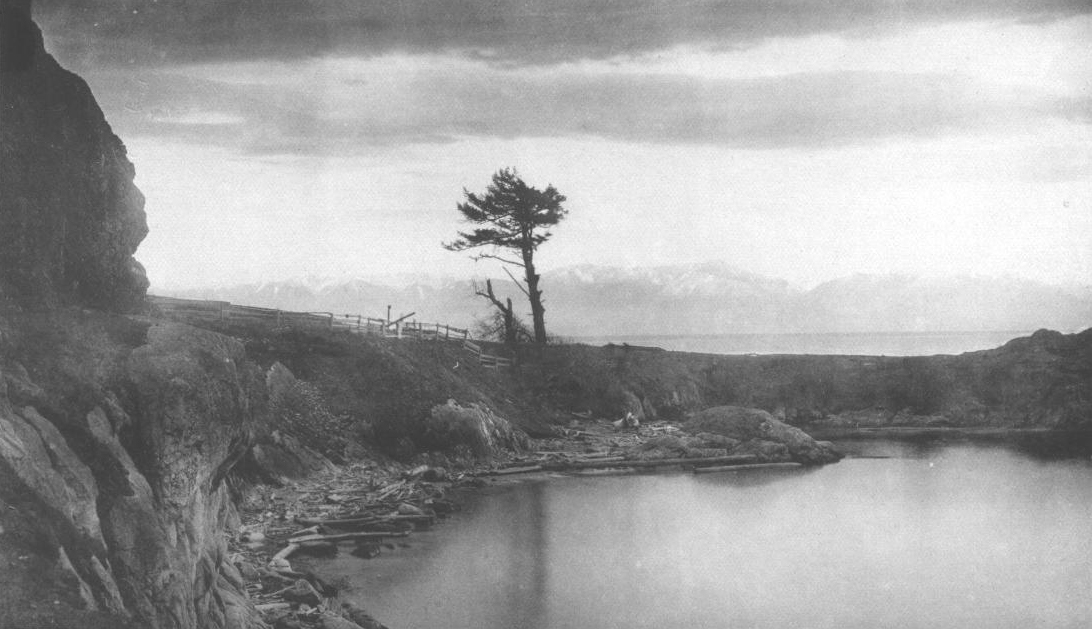
Figure 16. The location of the second defensive site on the south-western side of Fleming Beach, in 1900. Part of the area in the foreground has been filled in and now forms part of Buxton Green Park. Shellmidden deposits once occurred from the far right to what is now the climbing wall on the left. The photographer is unknown, but it was likely the professional photographer Edgar Fleming who lived at the beach. (Grant Keddie Collection).
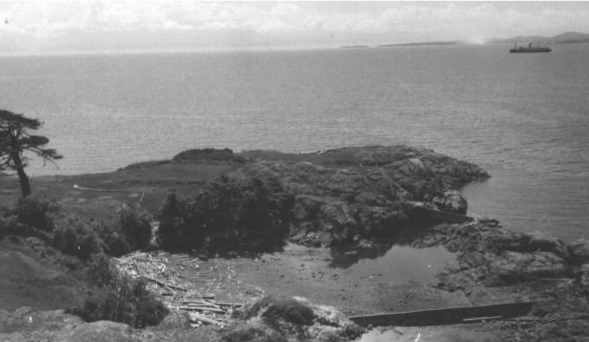
Figure 17. The southern aboriginal defensive site (DcRu-21) is seen in 1959 in relation to the peninsula before it was artificially extended in 1965. The stone wall in the foreground is part of the first salt water swimming pool built in greater Victoria. It was built by Canadian soldiers stationed at Work Point Barracks during the Second World War. It was filled in with the creation of Buxton Green Park in 1983 (Robert Kidd photograph; RBCM, Archaeology Collection).
Take a walk
Fleming Bay and Macaulay Point are home to one of the oldest First Nation habitations in the region and two types of defensive sites – one from a thousand years ago and one used from 1878 until World War II.
As you walk around the bay you will be able to observe these special features and think of the Macaulay family that walked here before you.
Taking knowledge of the community’s heritage features, the rock underneath your feet, the birds, the plants and the fish in the water below will make your stroll along the waterfront a much more enjoyable experience. It gives the community a sense of place.
Spindle Whorls in British Columbia download
Part 1. Introduction and Spindle Whorls in the Archaeology Collection of the Royal BC Museum
Introduction
In order to provide a broader understanding of the earlier history and origins of both historic and pre-contact spindle whorls used in British Columbia, I will provide a description with images of all the spindle whorls in the Archaeology and Ethnology collection of the Royal B.C. Museum.

Figure 1. Examples of small sea mammal bone spindle whorls in the Royal BC Museum ethnology collection.
This will be presented in three Parts: (1) Introduction and Spindle Whorls in the Archaeology Collection of the Royal BC Museum. (2) Small Spindle Whorls in the Ethnology Collection of the Royal BC Museum. (3)Large Spindle whorls from speakers of the Salish language family in the Ethnology Collection of the Royal BC Museum.
The archaeological record suggests that significant differences existed in the past. This project will look at the larger picture of all uses of spindle whorls in British Columbia, their age and distribution in earlier and more recent times.
Most of the discussion on this topic to date involves reference to the making of woven capes and blankets of mountain goat, dog hair and other materials using large spindle whorls. However, the majority of small spindle whorls in Museum ethnological collections that derive from the coast of British Columbia are related mainly to the production of fibers, such as stinging nettle, for the production of fishing nets. An overview for understanding this broader topic is presented here.
The Significance of Spindle Whorls in British Columbia
The weaving technology of First Nations of British Columbia is a popular topic. Designs on historic Salish Spindle whorls have had the greatest influence on what is termed modern Salish Art. Over recent decades Salish Artists have copied designs from Spindle whorls in Museum collections and have developed from these a wonderful array of new and creative designs that are a reflection of those early patterns.
The word Salish is, of course, a term used by linguists to refer to a number of different human populations that speak different languages that have a common origin. The common language origin indicates that these groups have interacted with each other to varying degrees at various times in the past, but each has their own history. The history of the use and expression of weaving technology will be different for some of these groups. We know, for example, in the historic period that some Salish speaking groups did not decorate their spindle whorls with designs.
The Interests of Archaeology
There is a desire to know the history and origins of the weaving of clothing, but the role of spindle whorls for other purposes is generally not understood. This project will put the broader role of spindle whorls in the public domain.
For Archaeologists, artifact typologies and where they fit into defined cultural phases play an important role in developing hypothesis about cultural development on the northwest coast.
What artifacts to include and exclude from trait lists defining cultural phases can be a very subjective exercise. Interpreting what the artifact represents in terms of cultural behavior can also be a subjective exercise.
Determining which spindle whorls were used for the production of different products and determining when this behavior began in the past would be crucial in making time specific statements about past human behavior.
Did the spinning of nettle for making nets precede the spinning of materials for clothing or were they both produced at the time of the introduction of spindle whorls?
Spindle whorls are a type of artifact that is not likely to have been independently developed, but rather introduced into the region. This seems to be the more typical pattern in other parts of the world. Knowing the function and timing of the introduction and/or local development of specific types of spindle whorls may help us better understanding the process by which it was introduced into this region and the source of its introduction.
Both internal and external cultural catalysts may underlie the explanation for the introduction of this new form of behavior. Does the introduction of the spindle whorl reflect a change in economy or a new technology for an existing economy? Is it a result of new trade and exchange with, or a borrowed idea from some outside culture?
In comparing the ethnographic record with the archaeological it is important to understand the nature of both. Archaeologists and ethnologists can make incorrect assumptions about the others data when they are not familiar with it. Knowing the specifics of when and where both the ethnographic and archaeological examples of spindles whorls were collected is important in making comparisons between them.
When comparing ethnographic spindle whorls with archaeological examples we need to ask if the ethnographic examples were actually used – or ones made for sale or made as models for collectors or museums. Are the whorls made in the early 20th century the same as those made in the early 19th century?
The biggest factor in the comparison of modern and ancient whorls will be in the nature of the raw materials. Wooden examples will be lost from the archaeological record except in the case of those found in extremely wet or dry conditions.
However, since almost all of the ethnographic examples of small whorls are made of sea mammal bone and stone, these should be found in archaeological sites.
Spindle Whorls in the Archaeology Collection of the Royal BC Museum

Figure 2. Examples of the size range of archaeological stone spindle whorls in the Royal BC Museum collection.

Figure 3. Example of size differences in sea mammal bone spindle whorls in the Archaeology collection of the Royal BC Museum.
Identifying archaeological spindle whorls is not something that can always be done with certainty. Some archaeological examples are similar enough to known ethnographic examples. They are often finely made with a lenticular or flat cross-section. The hole for inserting the whorl on the spindle is usually well defined and in proportion to the size of the diameter of the whorl. The hole is usually well centered.
There are other bone and stone objects that seem to be more likely to be spindles whorls than anything else. These come in a variety of sizes. Spindle whorls in other parts of the world show considerable variation in size depending of what kind of material is being spun. A few of the 27 specimens described here deviate from the known historic examples, but are being considered as possible whorls until further research can substantiate or reject them as whorls. There may be some elements of the spinning and weaving industry that are found in earlier times that do not have an historic equivalent. For example, the presence of spinning bowls (Keddie 2003).
Description Notes
In some cases sea mammal bone whorls have a smoother side that is the outer portion of the original bone and a rougher side with a more porous surface. Where this is clear, the smoother side will be considered the upper portion or top against which the fibre being spun accumulates.
The whorls will be described here in regional clusters of my own invention for comparative purposes. This is based on general geographic areas and in part reflects the current state of the collection.
South East End Vancouver Island. Pedder Bay to Nanaimo. (Total 11)
DcRt-Y:41 Cadboro Bay. Flat, rounded, but slightly rectangular, whale vertebrae epiphysis. The smoother top is nearly flat, while the bottom is convex only along a thicker middle portion. 155mm – 123 mm dia. Hole dia. 17mm. It varies in thickness from 12mm near the center to 5-6mm around the outer rim. Records show that this is from the Cadboro Bay archaeological site DcRt-15 [old accession 1932-1]. The porous bottom surface has an incised face on one half composed of two eyes and a mouth. On the top surface is a star-like pattern composed of two rings encircling the center hole with four triangular extensions that have long thin triangles in them, and two thinner arm-
like extensions between the larger triangles extending to each side. Weight: 102 grams (portion missing – estimated original weight 120 grams). Surface collected by T.W.S. Parsons, 1932.
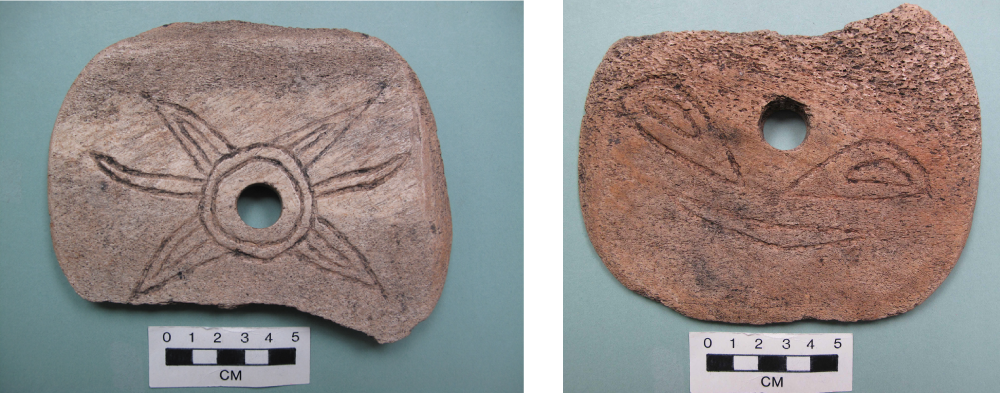
Figure 4. The only large bone whorl with a design. DcRu-25:1555.
DcRt-15:1289. Cadboro Bay, Victoria. Bone whorl blank. Whale vertebrae epiphysis. This was shaped by chopping around the circumference with an adze. Flat with original smooth bone top surface and porous bottom surface. Maximum dia 15.5cm; Max. th. 1.5cm. Weight: 179 grams. (Old number 12650].
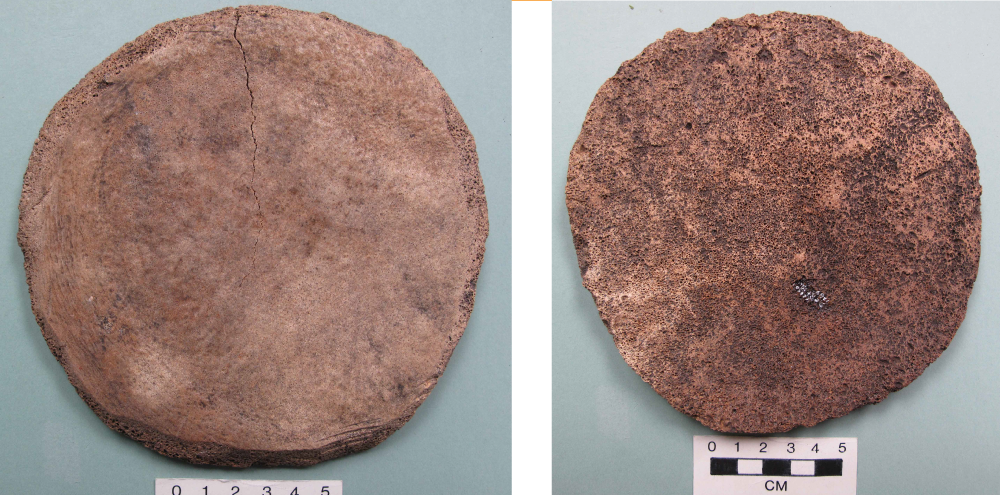
Figure 5. Unfinished whalebone whorl.
DcRu-25:1555. Victoria Harbour. Old Songhees Reserve. Portion (about 40%) of round to slightly rectangular whale vertebrae epiphysis. Flat smooth ground top surface and porous, ground, slightly convex bottom surface. Only slight remnant of center hole exists. The outer rim is flat sided with rounded edges. Maximum diameter present (144mm). Estimated original diameter based on continuance of outer rim is about 160mm. The radius from the hole remnant edge is 68mm. If the hole was the same size as the similar DcRt16:158 specimen, the diameter across this portion would be a minimum of 154mm. This whorl is larger from the hole to the edge than DcRt-16:158, and seems to have been slightly rectangular – suggesting that an original diameter of about 160mm is accurate. Thickness ranges from 9.5mm at hole to 6-7mm on the outer edge. Weight:(32.8 grams). Estimate of original weight is about 135 grams. Excavated form disturbed historic debris. This site was occupied from 1844-1911. It is likely that this whorl dates to the earlier period of the mid-19th century.

Figure 6. DcRu-25:1555.
DcRt-16:158. McNeil Bay, Victoria. Whale vertebrae epiphysis. Nearly flat on the ground top – which is the original bone surface. The ground porous bottom is slightly convex. Diameter: 144mm by 132mm. Thickness varies from 4mm-5mm around the edges to 7mm near the centre. Hole diameter: 18mm. No raised area near the spindle hole. Outer bone cortex side more polished with wear patterns. Weight: 123.5 grams. This site has two bottom dates of around 500 years. The oldest (WAT1627, RH86-10; 560-+65) dates the base of the midden to the period around 1390 A.D. to 1455 A.D. A second date covers the period from A.D. 1445 – A.D. 1680.
Oral history refers to this site being occupied by the Chikawich people. It may have been last used in the early 1800s as a more permanent village, but used on a more temporary basis after this. The spindle whorl, therefore dates to a maximum of 500 years, but may be closer to a date of 200 years ago.
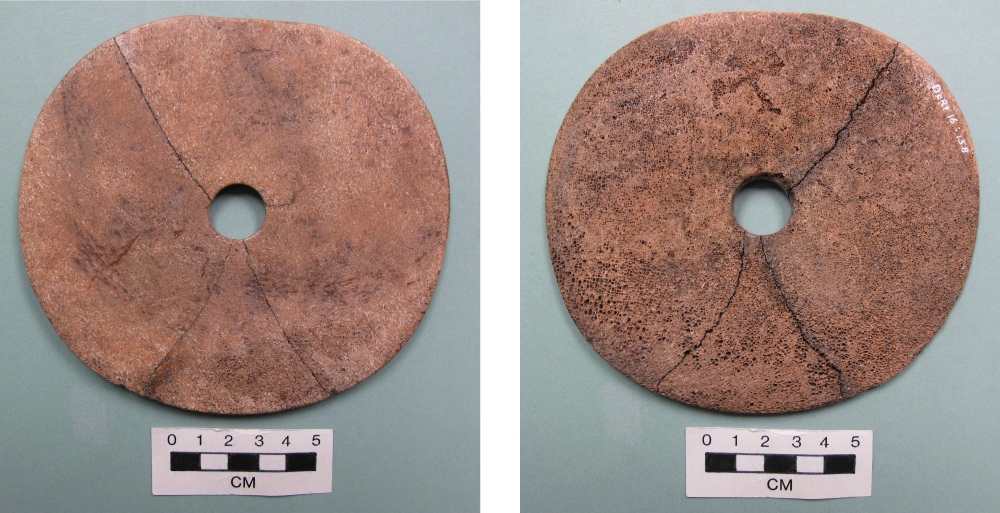
Figure 7. Large spindle whorl, Both sides. DcRt-16:158.
DcRt-16:335. McNeil Bay, Victoria. Whale vertebrae epiphysis bone. This small fragment is flat on the original ground bone top surface and convex on the bottom ground porous surface. There is no central whole present but the ground contours are the same as the outer edge of the whorl DcRu-12:1555. Diameter: (51mm). Width: (28mm). Thickness: 6mm on edge to (11mm) inward. Weight: (6.9 grams).
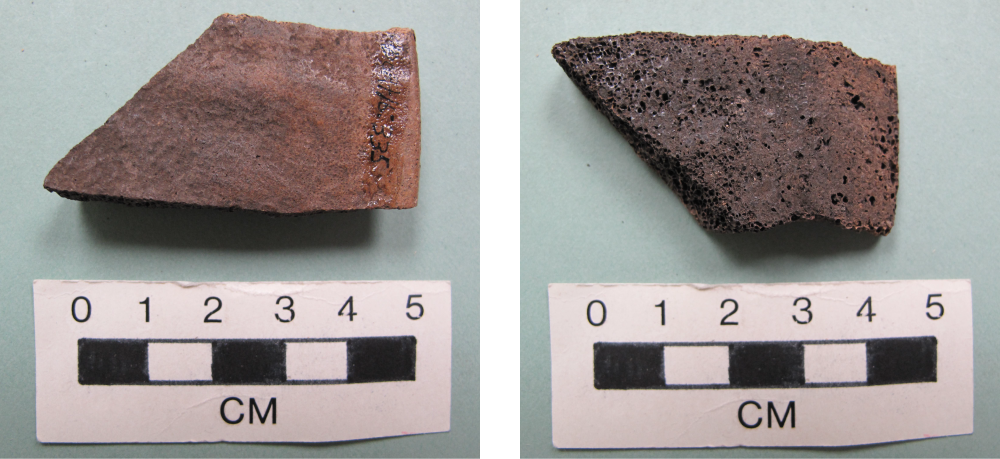
Figure 8. Fragment of large spindle whorl, DcRt-16:335. Obverse and reverse sides.
DcRv-1:733 Pedder Bay. Oval shaped, sea mammal bone vertebral epiphysis. Flat on both surfaces and flattened sides. Diameter: 73mm – 64mm; Thickness varies from 3mm to 5mm; Hole diameter is 7.5mm. Weight: 12 grams.
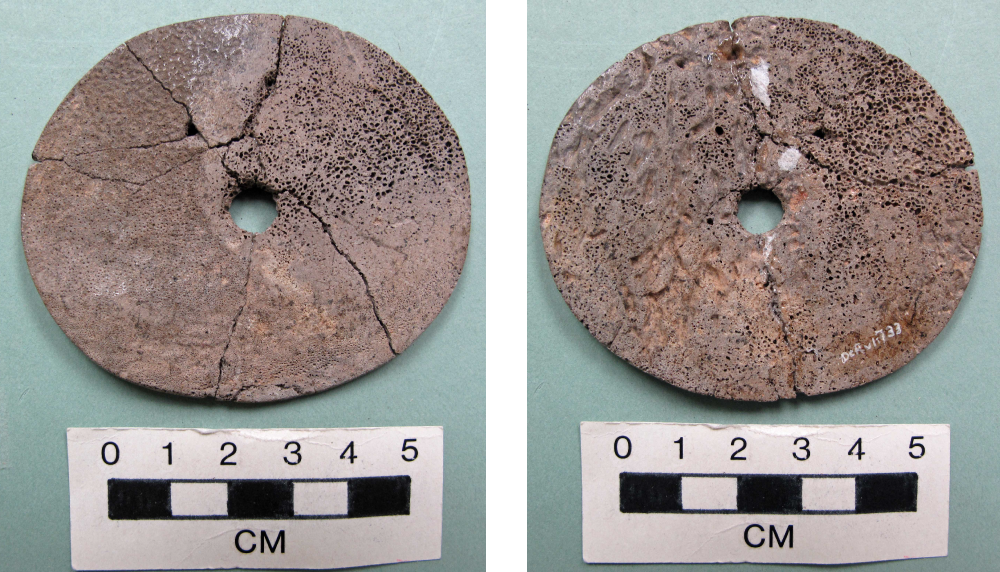
Figure 9. Obverse and reverse of spindle whorl, DcRv-1:733
DcRu-Y:63. Esquimalt Lagoon area. Small grey siltstone whorl fragment (about 22% present). One side is flat and the other slightly convex. It tappers from a thickness of 4.8mm at the hole to 3mm at the rim. Maximum diameter present (67mm). Original estimated diameter is about (78mm). Original hole diameter about 7mm. Old accession 75-57. Written on artifact: “Seashore Belmont, A. N. Marrion”. Marrion was known to have collected other material from site DcRu2. This is likely the site that it came from. A series of radio-carbon dates places most of this site after 1000 B.P. Weight: 13.9 grams.

Figure 10. Small Siltstone spindle whorl, DcRu-Y:63
DcRu-Y:266. (DcRu-23). Finlayson Point, Victoria. Ground sea mammal bone. Nearly flat on both surfaces. Fragment only. Includes portion of central hole and portion that includes a section of original outer rim. Distance from hole edge to outer rim 55mm. Hole diameter 16mm. Thickness varies from 3.8mm on the outer rim to 5.5mm near the central hole. Original diameter estimated at 126mm. Collected by William A. Newcombe at a shell mound in Beacon Hill Park in 1902. The only site this description would fit at that time is the Finlayson Point site, DcRu-23. Weight: [23.4] grams. Original weight would be about (70 grams). This site dates within the last 1000 years and was likely last occupied in the mid-1700s.
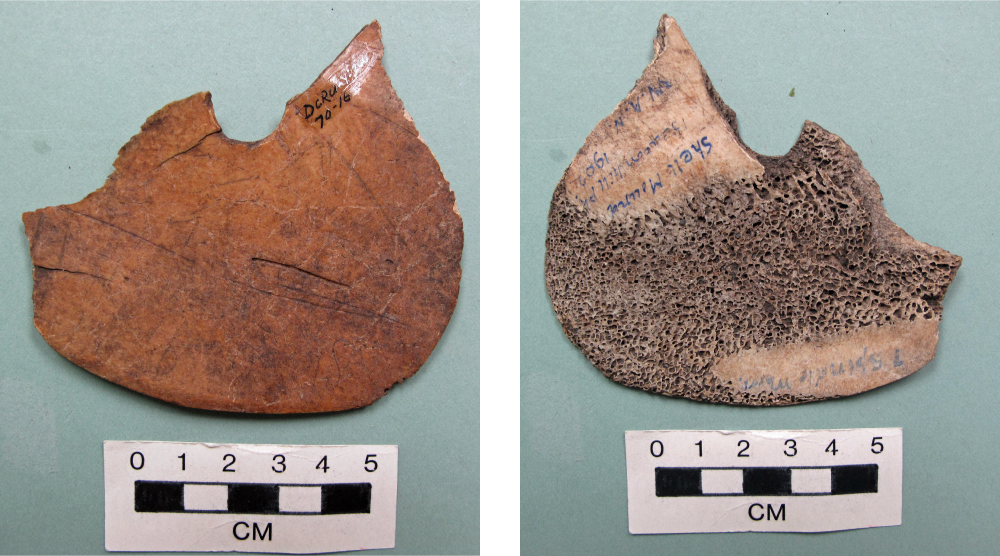
Figure 11. Portion of whalebone spindle whorl, DcRu-23. Obverse and reverse sides.
DeRu-1:2611. Sidney area. Whalebone whorl fragment (about 7/12 present). Flat on more porous bottom surface and slightly convex on top surface. Tapers from 9mm thick at hole to 4mm at rounded outer rim. Original hole dia. c.8mm. 50–52mm from hole edge to outer rim. Original diameter c. 114-118mm. Slightly rectangular. (Old accession 5489; From collection of A. and Francis J. Barrow – #358, from Barrow property). Weight: [52] grams. Original weight about 120 grams.
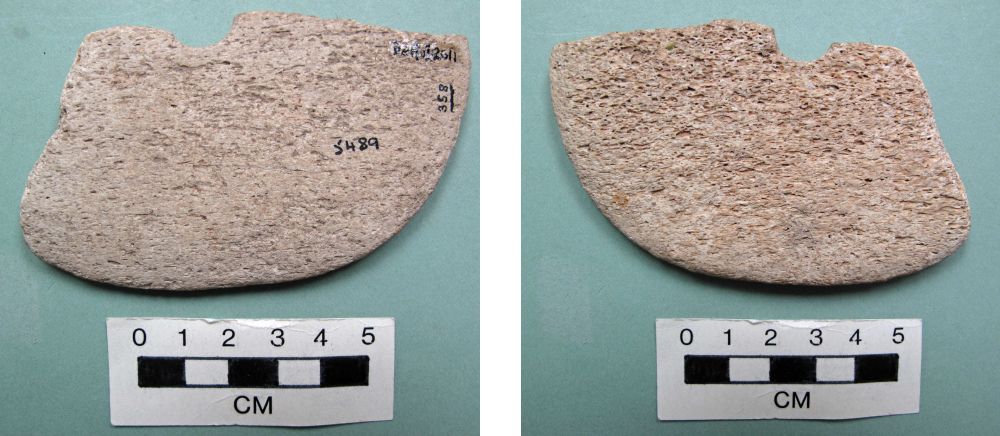
Figure 12. Fragment of large spindle whorl, DeRu-1:2611.
DeRv-Y:56. Cowichan region. Possible whorl? Oval shaped siltstone. Slightly bi-conical in cross-section. Bi-conically drilled central hole. Edges ground flat with portions slightly rounded. Diameter ranges from 76mm – 89mm. Outer hole diameter 15mm; Inner hole 9mm. Thickness: 10mm – 13.5mm toward centre. Weight: 148.1 grams. Old accession # 275, donated by E.M. Skinner) On label “Cowichan. Mrs. Skinner, May 1890”. Smooth surface. This may also be a small net weight, but there are no other net weights like it in the region.
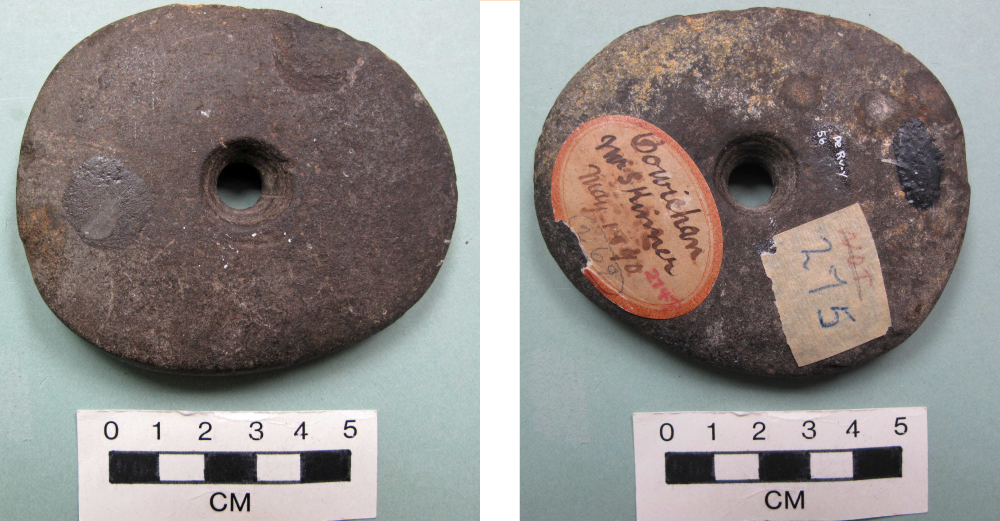
Figure 13. Small Stone Spindle whorl, DeRv-Y:56.
DgRx-Y:14. Nanaimo District. Large disc shaped stone with slight 2mm collar (raised rim around the hole edge). Bi-convex cross-section. Diameter: 144mm-164mm. Thickness varies from 25mm at the inner hole to 6mm on the outer edge. Hole diameter: 33mm. Raw material: Andesite. Weight: 623.3 grams. (Originally from the D. Steveson Collection, that became part of the Charles Newcombe Collection. Old accession #10946).
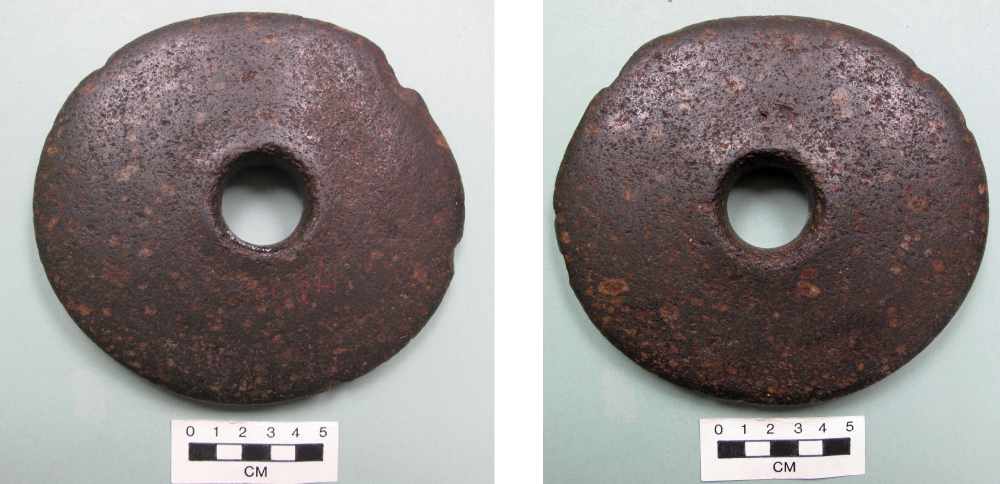
Figure 14. Large Stone spindle Whorl, DgRx-Y:14
Gulf Islands (Total 4)
DfRu-24:749. Galiano Island. Active Pass. Georgeson Bay. Whorl fragment of whale vertebrae centrum epiphysis. Nearly flat top surface and slightly convex bottom surface. Weight :(30.8) grams. This has the characteristics of a whorl but is missing the portion where the central hole would be. Minimum diameter estimated at about 160mm-180mm.

Figure 15. Fragment of large spindle whorl, DfRu-24:749.
DfRu-24:1287. Galiano Island. Possible whorl? Very small round, flat stone with central hole. Edges ground flat. This is much smaller than any known ethnographic examples or any information provided in ethnological accounts in British Columbia, but does fit the size range of whorls in other parts of the world. It could be a decorative button or some other object? Diameter: 25.5mm; Thickness: 3mm; Hole size: 4mm. Weight: 2 grams. Accession 68-19.
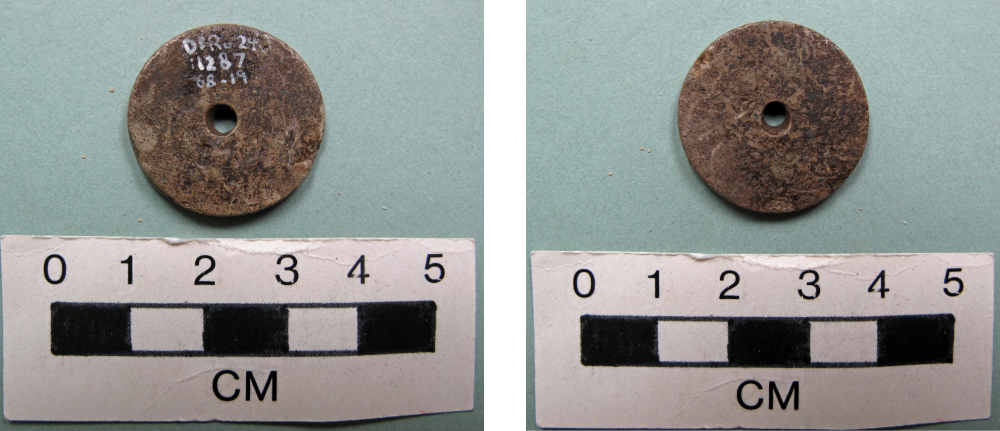
Figure 16. Possible small stone spindle whorl?. DfRu-24:1287.
DgRw-4:2740. Gabriola Island. Flat slate whorl. Diameter: 56.8mm to 59mm. Thickness: Varies from 2.5mm to 3.0mm. Hole diameter: 6.5mm. Bi-conically drilled. Weight: 16 grams. Accession 1967.27. Excavation. David Burley 1988. False Narrows III component. Gulf of Georgia Cultural type (“with an approximate age between A.D. 1200 and the historic period”).
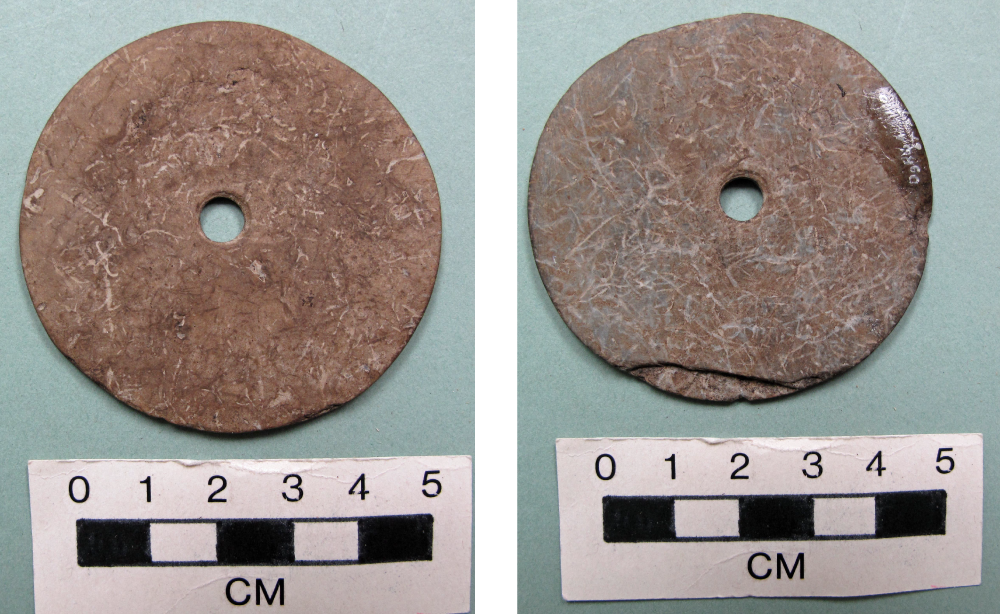
Figure 17. Small siltstone spindle whorl, DgRw-4:2740.
DeRt-1:103. Pender Island. Small flat sandstone whorl. Diameter 38-42mm. Even thickness of 7mm with well defined, steep edges. Hole diameter: Inner 6mm; outer cut area 10-12mm. (#94 of Herbert A. Spalding collection). Weight:16.1 grams.
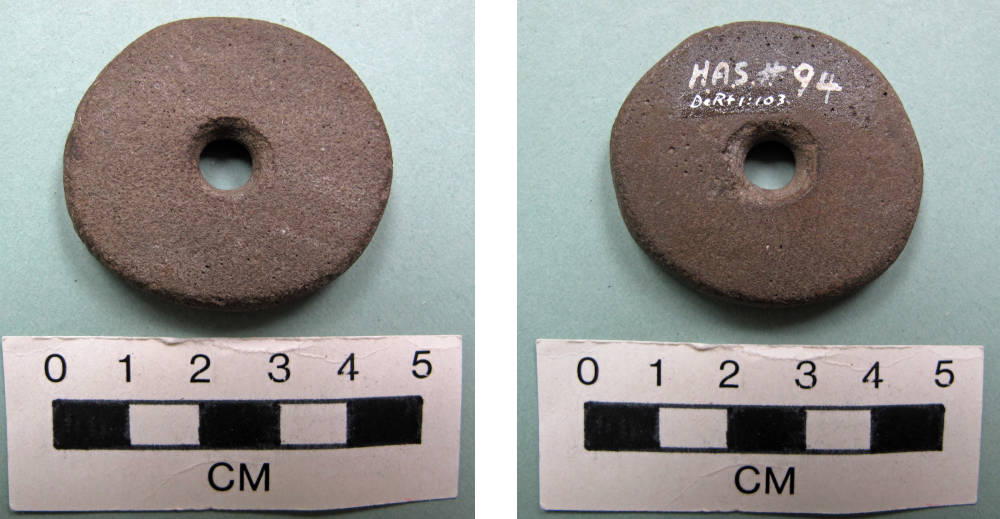
Figure 18. Small stone whorl. DeRt-1:103
Lower Fraser River. (Total 3)
DjRi-Y:134. Yale area. Small disc shaped siltstone whorl. Bi-convex in cross-section. Weight: 31 grams. Diameter: 5.4cm. Thickness: 9.4mm at center and tapering to edges. Hole diameter: 9mm. [old #3134; Accession 1917.27].
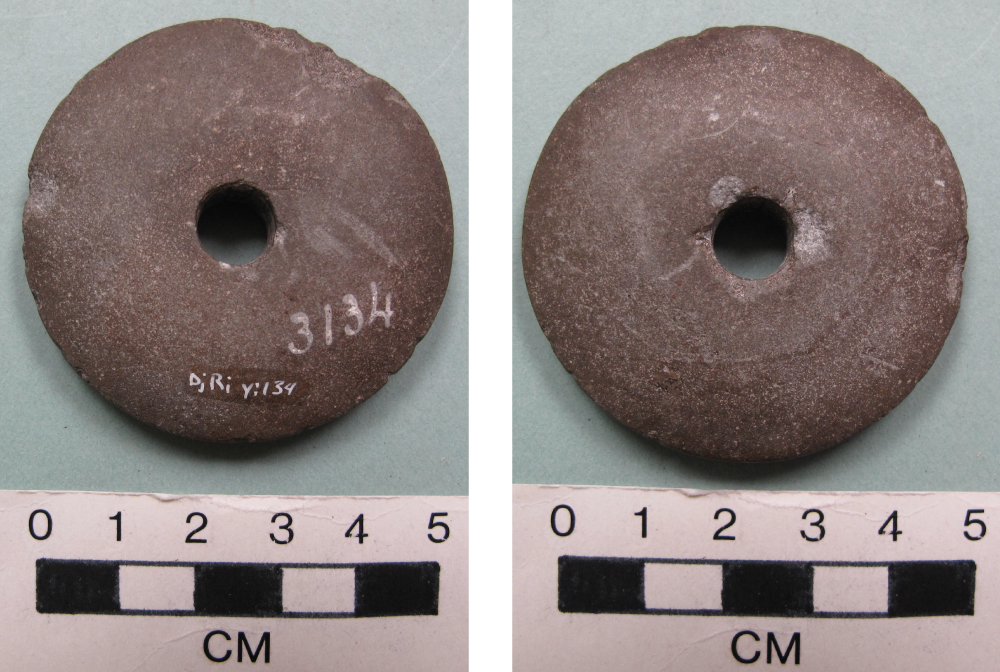
Figure 19. Both sides of stone spindle whorl DjRi-Y:134.
DjR1-3:14. North of Yale. Unfinished round whorl. Flat on bottom and nearly flat on top surface. Schist-like material. Unfinished 4mm deep hole drilled at center on one side. Diameter: 45mm by 43mm. Thickness: 4.8mm at center tapering to an average of 4.5mm at outer edges. Weight: 15.9 grams. [Old accession # 12625; 65-48].
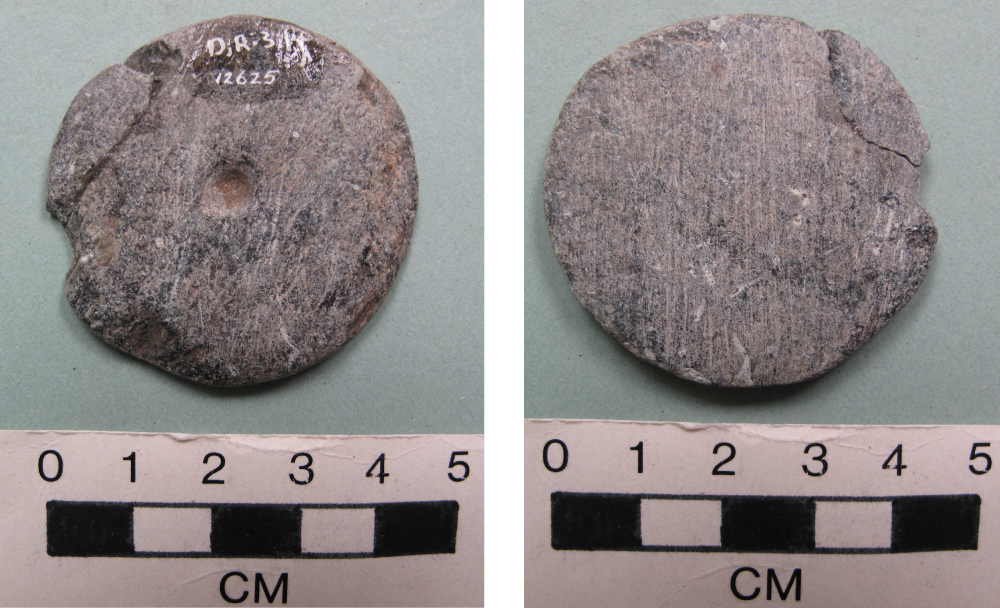
Figure 20. Both sides of stone spindle whorl DjR1-3:14
DhRlm-Y:1832. Agassiz-Dewdney general area. (67-4). Flat nearly round siltstone whorl with rounded edges. Bi-conically drilled hole. Diameter: 69-73mm. Thickness 8mm. Hole diameter: Inner 8mm, outer cut 13-14mm. Weight: 64.6 grams.
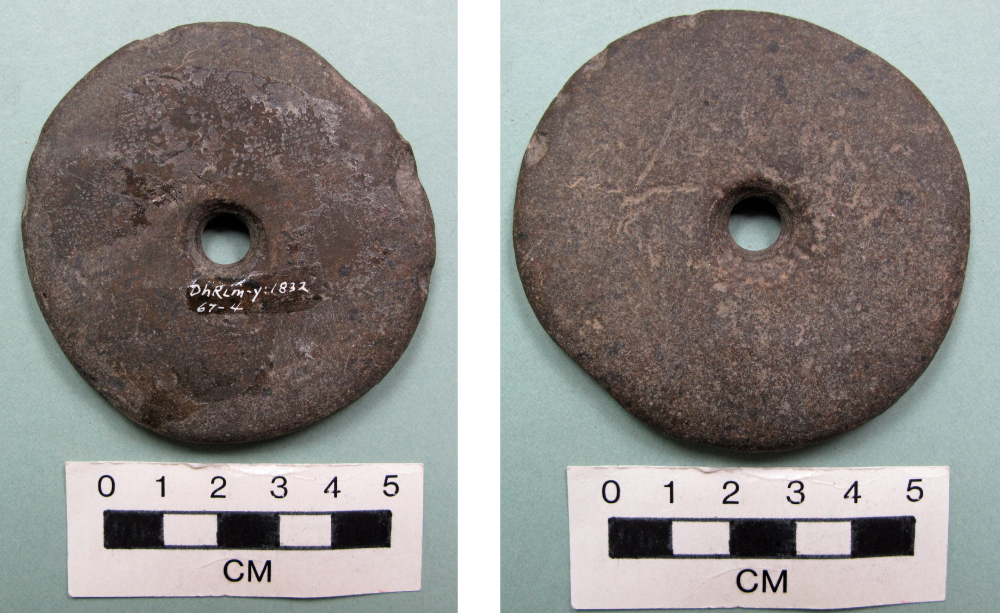
Figure 21. Small stone spindle whorl, DhRlm-Y:1832
North end Vancouver Island/Mainland region (Total 2)
EdSo-Y:1. Lagoon Cove, Cracroft Island. Flat sea mammal vertebral epiphysis bone. Flat ground edges. Diameter: 72.5mm Thickness: 5.5cm. Hole diameter: 11mm; [old #5556; 425]. Surface collected by M. Miles. Became part of collection of A. and F.W. Barrow – #425. Weight: 22 grams.
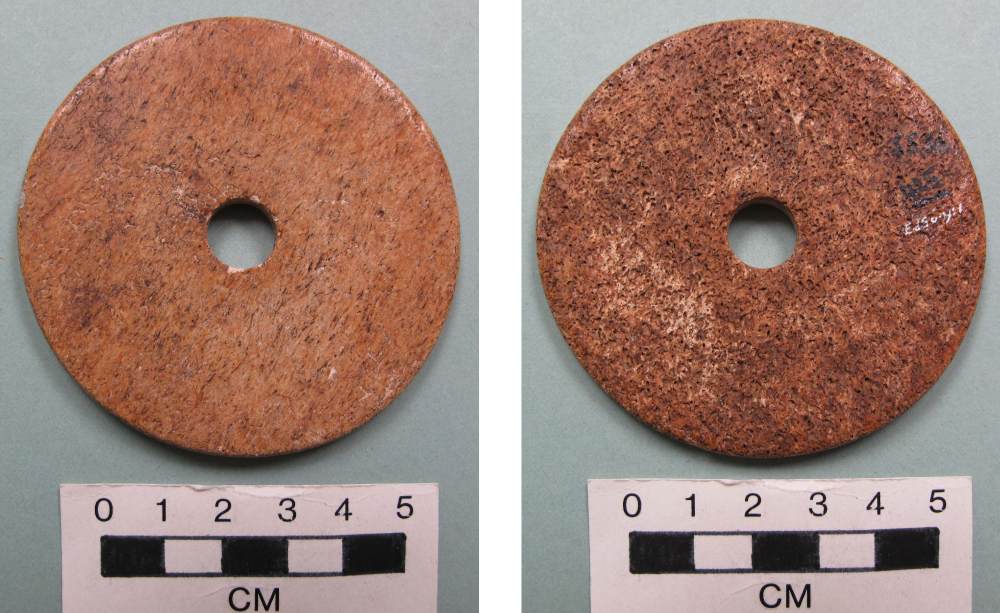
Figure 22. Obverse and reverse sides of bone spindle whorl EdSo-Y:1.
EaSe-Y:23. Prideaux Haven. Siltstone whorl. Near flat to slightly bi-convex in cross-section. Ground around edges and high area on surfaces. Rough, unground portions on both sides. Diameter: 49mm to 49.9mm. Thickness: 4.7mm near centre and tapering to 3mm at edges. (old accession “5625”; Found by Phil Lavigne in 1938 and given to Francis Barrow. Part (#494) of A. and F.W. Barrow collection donation in 1944). Weight:16.1 grams.
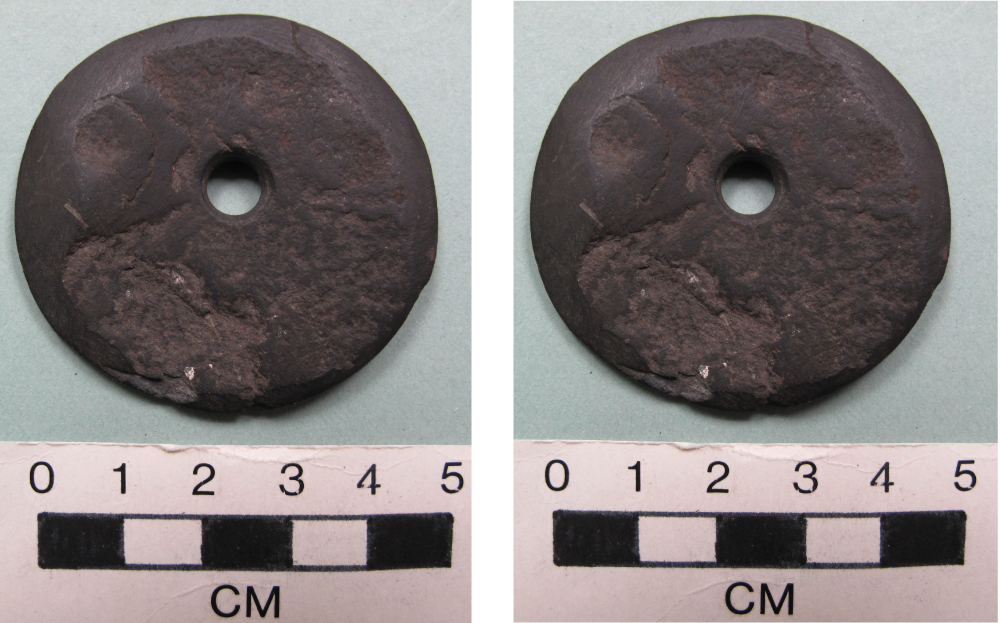
Figure 23. West Coast Vancouver Island. (Total 1)
EdSv-6:20 Quatsino Sound. Sea mammal bone whorl. Bi-convex in cross-section. Diameter: 61.5–64.1mm. Hole diameter: 10.5mm. Thickness varies from 4mm at edge to 10.8mm at hole. Transferred from Ethnology. John Stephenson Collection. A-1985-10. Weight: 37 grams.
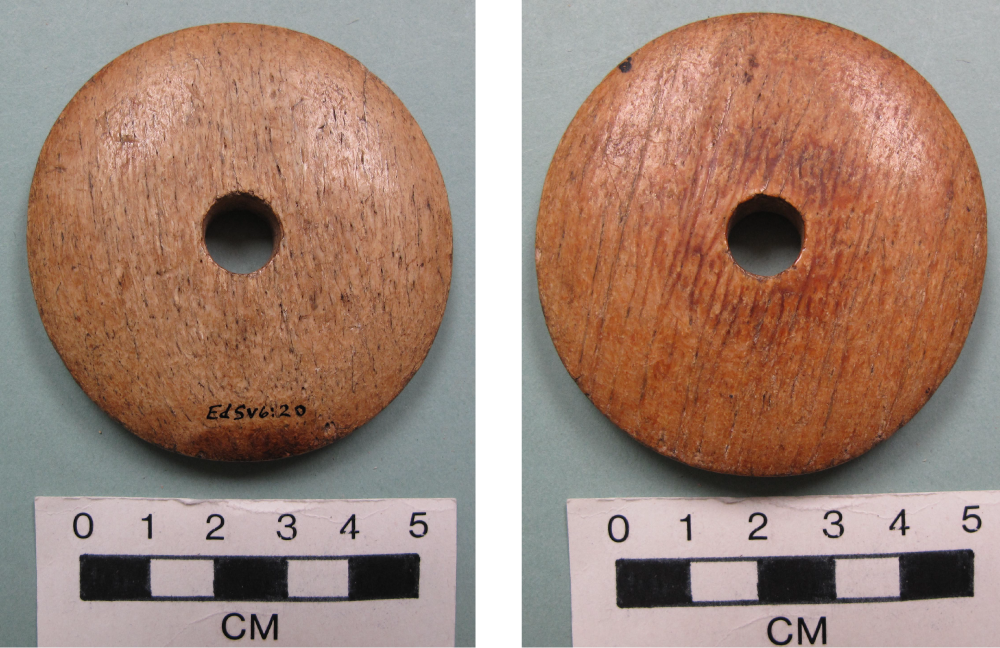
Figure 24. Both sides of bone spindle whorl EdSv-6:20
Interior (Total 2)
EbRj-Y:39 Lytton area. Flat circular siltstone. Flattened to rounded edge. Bi-conically drilled hole. Diameter: 100–102mm. Thickness: 8cm. Hole diameter: 9mm [13mm hole depression area].[old catalogue #455, lists this as from “S.Thompson” [South Thompson River] 1892.3, from the collection of F.M. Stevenson of Lytton]. Weight: 147 grams.
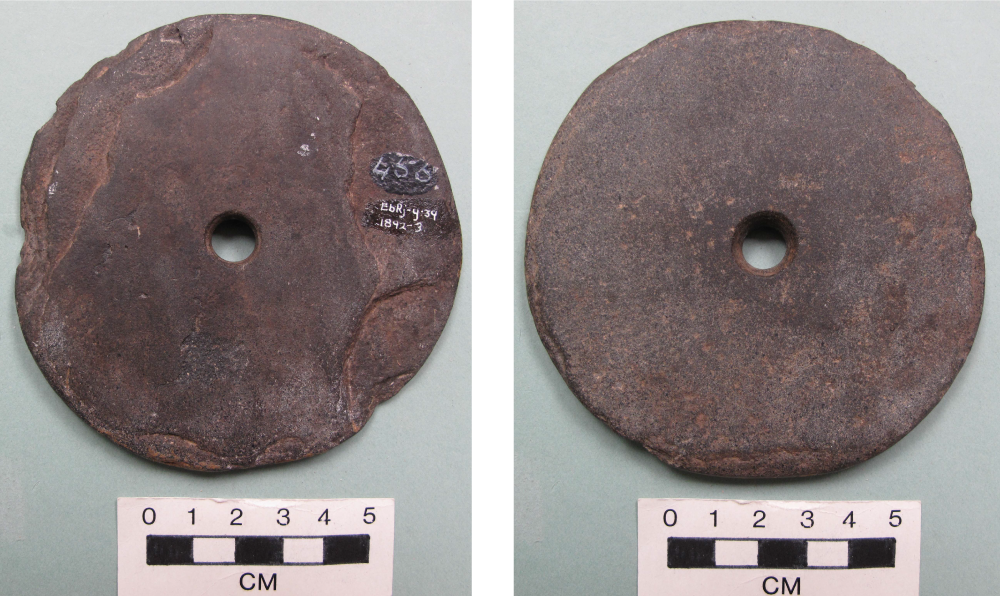
Figure 25. Both sides of stone spindle whorl EbRj-Y:39
ER-Y:836. Southern Interior. Flat schist whorl fragment. Radius of piece from edge of hole to rim 41mm. Estimated diameter based on hole at center 90mm. Thickness: 9.3mm; Hole diameter estimate c. 9mm. Design pattern – A groove 3mm in from and around the edge separates a slightly lower area extending to the edge. Inside the grooved circle there is a star-like pattern formed by three 13mm high triangle patterns on the inside of the circular groove. Fire burn marks on one portion. “Interior Salish”. [old acc.66-6] Surface collected by H. Cowden. Weight: [47] grams (original estimated weight – c.120 grams)
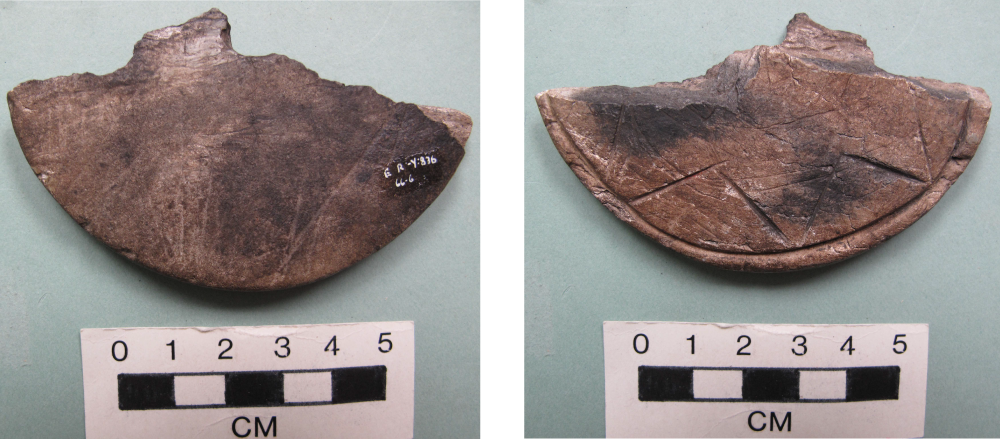
Figure 26. Obverse and reverse sides of stone spindle whorl ER-Y:836.
Central Coast (Total 3)
FcTe-4:458. Price Island. Sea mammal vertebrae epiphysis bone whorl fragment. Diameter: 77mm. Oval shape; only half present; Thickness: 4mm; Diameter of hole: 6mm. [accession #72-362] Weight: 11.2 grams.
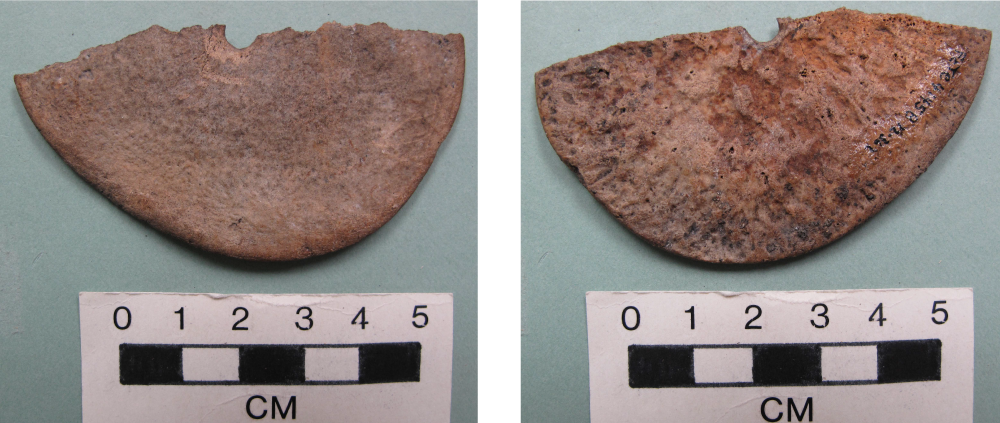
Figure 27.Obverse and reverse side of bone spindle whorl FcTe-4:458.
EkSp-13:5293. Owikeno. Sea Mammal bone whorl. Flat. Diameter: 61mm by 60mm. Thickness 6mm. 5.5mm on edges. Hole diameter: 11mm. Weight: 25.8. Excavations 24.7.75. N.E. Quadrant. Likely date 18th to early 19th century.
EkSp-13:5542. Owikeno. Sea Mammal bone whorl. Flat. Diameter: 52mm by 50.5mm. Thickness 8mm. 7.5mm on edges. Hole diameter: 11mm. Weight: 24.8. Excavations 24.7.75. S.W. Quadrant. Likely date 18th to early 19th century.
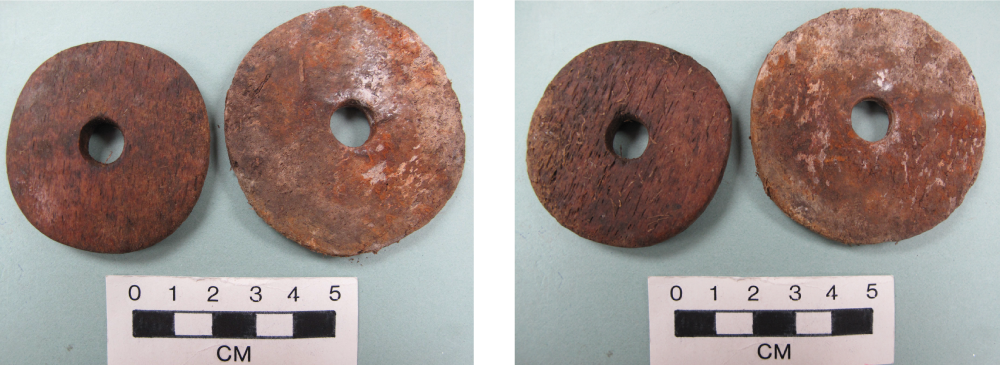
Figure 28. Obverse and reverse views of bone spindle whorls EkSp-13:5293 and EkSp-13:5542.
B.C. Unknown Location (Total 1)
Y:1879. Stone. Flat surfaces, but with 7mm wide angled facetting around edges on both sides. Edges ground flat. Weight: 67 grams. 6.4-6.5cm dia.; .5-.6cm flat edge; 1cm max. th.; hole .9cm (1.9cm hole depression area).
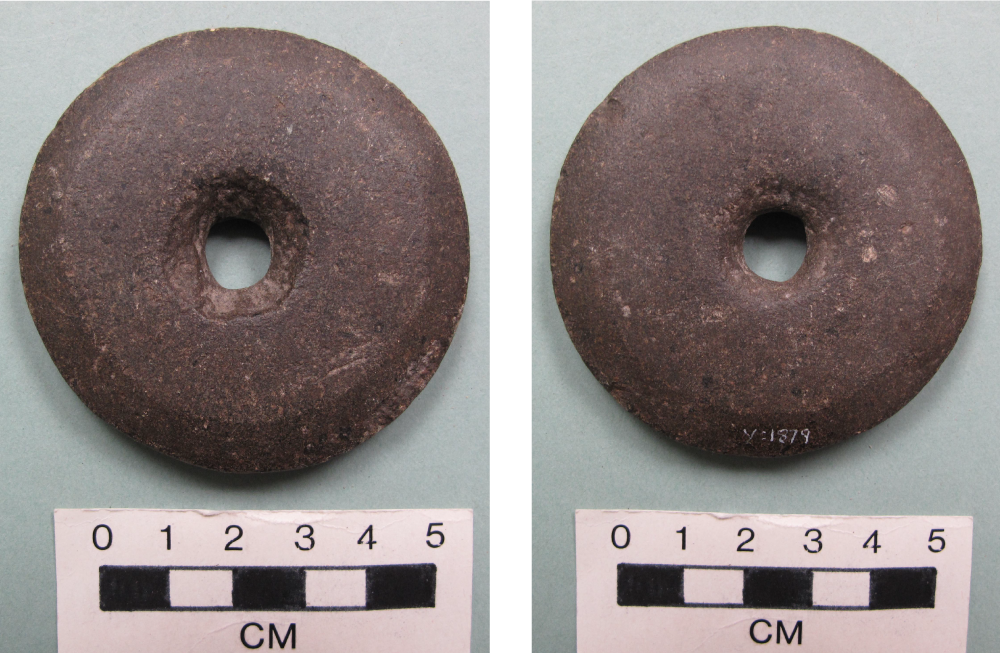
Figure 29. Both sides of stone spindle whorl from unknown B.C. location.
Possible whorl?
DhSb-11:31. There is no evidence of a central hole, but other dimensions suggest that this is a whorl.
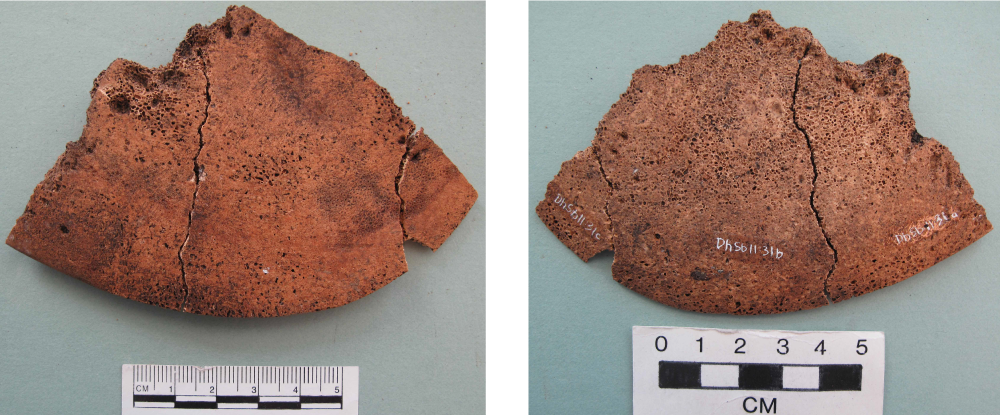
Figure 30. DhSb-11:31. Possible bone whorl
DdRu-5:85a&b. Unidentified object. This item was originally described as a possible whorl but I matched another piece, DdRu-5:159, which showed that the placing of the ground edges meant this could not be a whorl.

Figure 31. Ground whale bone that is not a whorl.
Dating and context of spindles from other collections
Haida Gwai. A spindle whorl was found on the floor of a habitation rock shelter, FaTt-36:2. The site is located on the south shore of Djitkan Ankun near Cape Freeman, S.W. Coast of Moresby Island (Acheson 1998:188&202). (Dia. 78.2mm; Th. 6.9mm; hole dia. 12mm. Weight not given). Date unknown.
Queen Charlotte Strait. Two sea mammal bone spindle whorls were found at Davies Island Fort site, EeSp-95a, off Fife Sound (Mitchell, 1981:118; Fig. 37p&q) (Dia. abt. 37mm & abt. 63mm (Mitchell, 1981:118 and Mitchell 1988:251, fig.4).
These are only associated with the deposits of a general time period containing what is called the Queen Charlotte Strait Culture Type assemblage which dates from after AD 300 to near the historic period. (Mitchell 1988:251; figure 4i). (Dia. 32mm; Dia. of hole 5.5mm).
A “bone spindle whorl” was found in a shell midden at the head of Echo Bay, site EeSo-1, on the northwest shore of Gilford Island. Known as an historic period Kwicksutaineuk village (Mitchell, 1981:109; fig. 33m).
South-eastern Vancouver Island
DcRw-14:303. 135mm by 125mm; thick 18mm. Private collection of Gordon Crowe. Lower Fraser River
Lower Fraser River
Charles Borden describes a fragment of a spindle whorl from the old Musqueam village of Stselax, site DhRt-2, as a: “Marginal fragment of an elaborately and bifacially engraved spindle whorl fashioned from the epiphysis of a whale vertebra”. This site dates from 1250 AD to late contact times, but Borden suggests that the spindle whorl fragment was among artifacts that were “probably carved and engraved with steel cutting tools during the Historic Period” (Borden 1983:165;Figure 8:34c).
Fraser River Canyon
Charles Borden excavated a small “brown steatite” spindle whorl (DjRi-3L11.142) from the Milliken site in the Fraser River canyon (Diameter: 11.45cm). It has Snake motifs engraving on one side and multiple snake eyes on the other. Borden placed it in the Esilao Phase dating to after 1380 A.D., but then suggested that it is “more likely” to date to the “Historic Period”. He stated that: “On the available evidence it is perhaps best to consider this steatite whorl more of less contemporary with the carefully designed compositions on some of the elaborately carved spindle whorls of the nineteenth century, bearing in mind, however, that future data and deeper insight may eventually justify placing this remarkable artifact into an earlier period” (Borden 1983:161).
Interior
Sanger reports two stone spindle whorls from the Texas Creek site. “Steatite spindle whorls are known from the Mile 28 Ranch Site, but to date they have not been found around Kamloops. The proximity of these site (the Texas Creek and the Mile 28 Ranch) to the Coast, where the spinning of mountain goat hair was practiced, may offer a partial explanation for the presence of these artifacts in the western periphery of the Interior plateau” (Sanger 1968:13).
References
Acheson, Steven. 1998. In the Wake of the ya’aats’xaatgaay [‘Iron People’]: A study of changing settlement strategies among the Kungit Haida. BAR International Series 711.
Barber, Elizabeth J.W. 1991. Prehistoric Textiles. The Development of Cloth in the Neolithic and Bronze Ages with Special References to the Aegean. Princeton University Press.
Borden, Charles. 1983. Prehistoric Art of the Lower Fraser River Region. Pages 131-165. In: Indian Art Traditions of the Northwest Coast. Edited by Roy Carlson.
Keddie, Grant. 2003. A New Look at Northwest Coast Stone Bowls. In: Archaeology of Coastal British Columbia. Essays in Honour of Professor Phillip M. Hobler, pp. 165-174. Edited by Roy L. Carlson. Publication Number 30, Archaeology Press, Simon Fraser University.
Mitchell, Donald. 1988. Changing Patterns of Resource Use in the Prehistory of Queen Charlotte Strait, British Columbia, Pages 245-290. In: Research in Economic Anthropology. Edited by Barry L. Isaac, Supplement 3. Prehistoric Economies of The Pacific Northwest Coast.
Loughran-Delahunt, Isa. 1996. A Functional Analysis of Northwest Coast Spindle Whorls. Master of Arts. Western Washington University.
Mitchell, Donald. 1981. Test Excavations at Randomly Selected Sites in Eastern Queen Charlotte Strait. Pp. 103-123. In: B.C. Studies. Fragments of the Past: British Columbia Archaeology in the 1970s. No. 48, Winter, 1980-81.
Sanger, David. 1968. The Texas Creek Burial Site Assemblage, British Columbia. Anthropological Papers National Museum of Canada, Number 17, Ottawa.
A Unique photograph in the Collection of the Royal B.C. Museum
19th century photographic images in the Victoria region that show Lekwungen (Esquimalt and Songhees First Nations) undertaking traditional food gathering practices are rare. The only example of fishing is a photograph, taken in 1868, by Frederick Dally in Esquimalt harbour at the south entrance to Lang Cove (RBCM PN905). Lang Cove is located south of Skinner’s Cove, both of which are within the larger Constance Cove. This is the location of an ancient shellmidden as demonstrated by the scattered white clam shells seen in the image and later observed by the author at this location.

Figure 1. Herring Fishing Station at Wood’s Landing in Esquimalt Harbour. RBCM PN905.
This image (fig. 1 and close-up fig.2) of a man and woman at a herring fishing site is listed in Frederick Dally’s Miscellaneous Papers, (File 17), as #5 “Indian at Esquimalt, canoes, fish etc.”. A copy of the photograph in the RBCM Archives Dally Album #5 has information along the bottom of the image noting what is in the photograph “herrings drying – rush mat- fish spears – Indian woman cooking – Chinook canoes – Esquimalt Harbour V. Island”.
A copy of this photograph was also in the original photo album of Lieutenant J.C. Eastcott, the surgeon on the ship H.M.S. Reindeer that was on duty at the Esquimalt Royal Naval Dockyard station from 1868-75 (now the Canadian Forces Base Esquimalt).
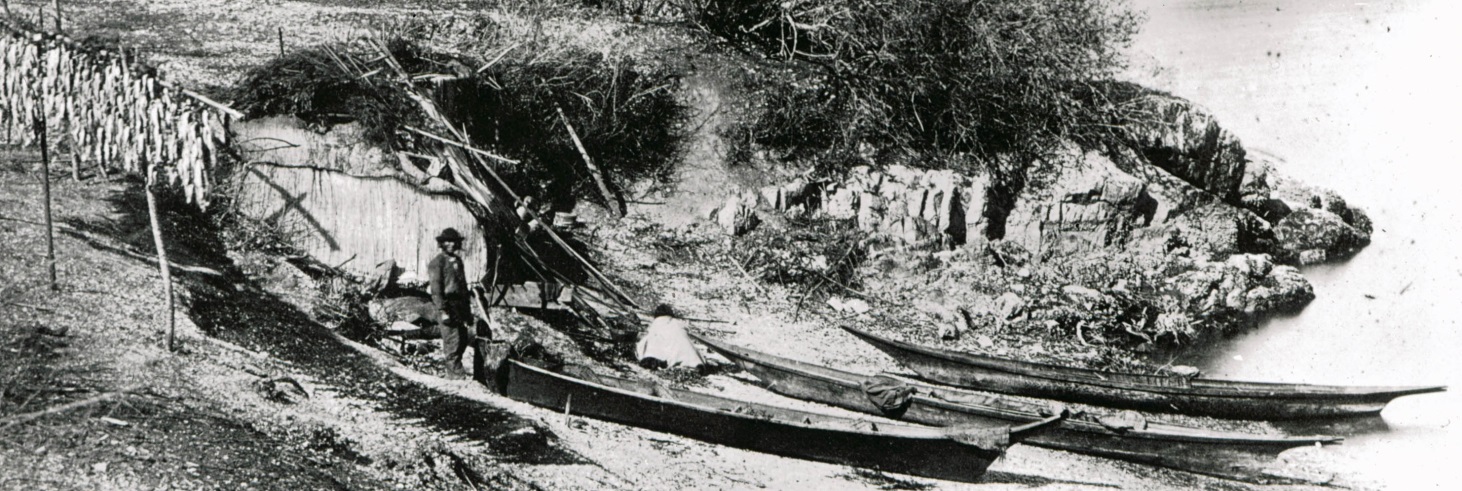
Figure 2. Close-up of Herring fishing camp (RBCM PN905).
Dating and Location of the Photograph
The album, in the possession of A.R. Eastcott, was temporarily loaned to the City of Vancouver Archives in 1958 where the information written on it was recorded by archivist Major James Mattews. This album was also loaned to the Provincial Archives in 1978, and the information copied down by Dan Savard of the RBCM ethnology division on November 23, 1978. They recorded the caption on this image as “Woods Landing, Constance Cove, Esquimalt 1868”. The reference to “Woods Landing” likely refers to the place that Sir Charles Wood, the First Lord of the Admiralty came ashore in 1856. It could also refer to a landing place used by Lieutenant James Wood who surveyed Esquimalt Harbour in 1846 under the supervision of Captain Henry Kellet, but James Wood’s name was not officially given to this location.
Dates placed on photographs long after the image was taken, and by someone other than the photographer, are often subject to error. In this case the date of 1868, is likely correct, and it would have been taken in late February to April of that year during the herring runs. Dally was away from Victoria in the Interior from June of that year and did not return to Victoria until to February 25, 1869.
I was able to identify the location where this photograph was taken by observing the same fishing site location in another photograph of Dally’s (RBCM F-08522), that was undated, but one that must have been taken in 1867 (figure 3). There are five ships in this image. The times they were on duty at the Esquimalt naval station allows us to be specific about the time the image was taken. The ships include the Egmont, Sparrowhawk, Alexandra, Malacca, Shearwater and Grappler. As the Shearwater was only on duty in 1867 the photo must date to that year. The vegetation in this image shows similar growth to that in photograph PN905, suggesting the time separation of a year or less is most probable.

Figure 3. This photograph taken in 1867, by Frederick Dally shows the herring fishing camp in left foreground (RBCM F-08522).

Figure 4. Close-up of photograph (RBCM F-08522) showing the same fishing camp area as seen in figures 1 and 2.
In figure 4, the remnants of many fish drying racks can be seen. Note the large number of upright short posts to the left of the photo and the large framework poles just to the right of centre of the photo at the edge of the bank. The fence-like rails in the background are related to Wood’s Landing and the historic naval wooden buildings to the far left of the photo.
Wooden planks that are held by pegs can be seen at the centre. The planks hold back the midden and create a flat platform for a mat lodge location. Barrels can be seen on both sides of this platform. The large pole framework can be seen in the middle against the back in the same location in image PN905 to the right of the tuli mat shelter.
Note the tiny little Island just on the other side of this point. This is part of what was called “Village Rocks” – as seen in figures 5 and 6.
By knowing what naval construction features were in the adjacent areas and by observing the angle of the two above images and what is in their background, the location can be identified as a small hooked piece of land extending into Lang Cove at its southern entrance.
Image PN905 is looking north-east to the North entrance to Lang Cove. Figure 3 (RBCM F-08522) is looking north, with the Officers Club House on Munroe Head visible on the far right and Ashe Head beyond it. Another image, RBCM F-08538, taken in 1866-67 (based on dates of the presence of the boats) and from higher up shows more of the Bay between Munroe Head and Ashe Head.
The small rock Islet (part of “Village rocks”) off the herring fishing site seen in Figure 3 (RBCM F-08522) can be seen on the far left in RBCM Archives image E-01844 – which also shows the rock formation on the north side of the entrance to Lang Cove as seen in the herring fishing camp image.
Adjacent to Wood’s Landing (on the west side of the hooked piece of land in photograph PN905) is a group of rocks in the harbour called “Village Rocks”. This hooked piece of land with the small bay of the campsite photograph can be seen in the detailed map of Esquimalt Harbour produced by Captain Richards in 1859 (see close-up figure 5). Over the years this area has been drastically altered and is no longer visible. The fact that it was named village Rocks suggests that the survey crew mapping Esquimalt harbour may have observe a group of First Nations camped there – even if it was just a seasonal camp site at the time and not what might be called a more permanent winter village site.

Figure 5. Map showing the small hook of land at Wood’s Landing and Village Rocks. H.M.S. Plumper survey of 1859. Note the larger area called Constance Cove.
The Origin of the name “Village Bay” and “Village Rocks”.
The names of some of the bays and coves changed over time. Several maps produced from 1851 to 1855 show “Village Bay” in Lang Cove or where later maps show Constance Cove.

Figure 6. Small Portion of 1854 “District of Victoria and Esquimalt, Vancouver Island” showing Village Bay at the same location later referred to as Constance Cove. Village Rocks is noted and remains on later maps (Canadian national Archives g.3/96 (N9301).

Figure 7. The name Village Bay is shown here in what later became Lang Cove. Small Portion of Hudson’s Bay Company Archives map T16019 entitled: Peninsula Occupied by the Puget Sound Company. The red marks are naval storage buildings on Thetis Island.
Observations on Photograph Content
Photograph PN905 shows herring fish on wooden drying racks to the left side of the image. A First Nations man, in European style clothes, is standing in front of a tuli (bulrush) mat summer lodge which is located on a built-in flat platform area faced with a board in front. This is the left of the two board faced platforms that can be seen in photograph F-08522. This is an interesting example of the human modification of a shellmidden.
Note the pathway near the right centre that can be seen in both photos. On the right of the mat lodge are poles for fish drying racks. Some of the long ones may be herring rakes (see figures 1 & 2), but the image is not clear enough to identify these. If Dally observed these, his reference to “spears” in his photograph description may have resulted from him seeing the long herring rakes at the site?
Of the three canoes seen in figure 1, the closest one is of a west coast Vancouver Island style, while the outer two canoes with the long pointed bows and sterns are made of the style most common among Salish speaking peoples of the southern Coast of B.C. and northern Washington State. The term “Chinook canoe” used in one caption is now referred to as the “West Coast” style.

Figure 8. Tuli mat temporary lodges. An early 1900, Black and white photograph (private collection) of a Paul Kane painting that was produced during Kane’s visit to the Victoria region between April 8th and June 9th, 1847. The original colour painting is now in the Stark Museum of Art, Orange Texas (cat. 31.78.4).
The Rediscovery of the Shellmidden
In the 1980s, Ernie Colwood of CFB Esquimalt took me to the Wood’s Landing location during construction activities. Here I observed tons of historic debri from previous projects on top of and mixed in with shellmidden.

Figure 9. Buried dense concentrations of Shellmidden. Grant Keddie Photograph.

Figure 10. Ernie Colwood with construction foreman at location of mostly destroyed Herring Fishing camp. Looking N.N.E.

Figure 11. Area of buried shellmidden. Looking North.
A Second herring fishing site in Lang Cove.
In 1851, naval surgeon John Palmer Linton, while visiting on board the HMS Portland, drew a view from the back of Lang Cove (Driver 2013; Driver and Jones 2009). In this image (Figure 12) we can observe, on the far right, a tuli mat shelter with fish drying racks like that in figure 1. This fits the general descriptions of the time about temporary shelters around the edges of Esquimalt Harbour, but no specific mention of this location is in Linton’s writings. We cannot be certain that this imagery was not simply added to enhance the drawing as was a common practice at the time. The added-in drawing of First Nations in canoes near European ships was a common practice among artists.

Figure 12. Drawing by John Palmer Linton in 1851. Constance Cove. Esquimalt Harbour, Vancouver Island. Royal Geographical Society.
Herring and Anchovy Fishing 1843-1878.
In the 19th century, there were both spring and fall runs of herring and anchovy in the Gorge waterway and Esquimalt Harbour. Anchovy bones are common in archaeological sites but overfishing caused their extirpation from this region around the First World War.
In 1865, Frederick Dally described the spring herring fishery in Esquimalt Harbour. During the fishing season: “lodges spring up like mushrooms along the edges of the bays and harbours …When thoroughly dried the fish are packed in bales made of rush mats, each bale weighing about fifty pounds, the bales being tightly lashed with bark-ropes” and carried by horses back to the “winter quarters”. Some of the fish were used “as lamps for lighting their lodges”. The 6 to 8-foot herring rakes had barbs “usually” of bone but “preferably” of nails. They sometimes catch two to three herring on each tooth. (Dally 1865).

Figure 13. This drawing shows the use of the herring rake by Tlingit people near the mouth of the Stikine River in the 1880s (From Elliott 1886:57).

Figure 14. Model of a herring rake in the Ethnology collection of the Royal B.C. Museum.
The first written observation of the Pacific herring in this region was by James Douglas in 1843. He notes that they arrive in April and are “taken in great abundance” in Victoria harbour. In April of 1847, the visiting artist Paul Kane observed:
“The Indians are extremely fond of herring-roe, …Cedar branches are sunk to the bottom of the river in shallow places by placing upon them a few heavy stones, taking care not to cover the green foliage, as the fish prefer spawning on everything green. The branches are all covered by the next morning with the spawn, which is washed off into their waterproof baskets, to the bottom of which it sinks; it is then squeezed by the hand into small balls and dried, and is very palatable.” (Kane 1925:148). A similar description is given by Bayley in 1878. He notes the “immense amount” of herring eggs preserved for winter use. The spawn is deposited on Cedar boughs placed “at low water”, then gathered and taken to camp and “stripped after being dried and put into boxes”.
In 1848, James Wood notes that the most common fish taken in the general area of the Strait of Juan de Fuca were “halibut, flounders, skate, rockcod, sardine [anchovy], salmon, trout, and several varieties of the herring.” Sole and flounder were plentiful in the Royal Roads area off Esquimalt Lagoon where the Songhees “would expose flounders on spits to the sun in order to roast them.” Halibut were once very plentiful on the shallow offshore banks from Victoria harbour to Discovery Island.
The Lekwungen increasingly began gathering resources for others. James Bell described the situation in 1858:
“we are indebted to the Indians for a supply of everything in season …at very reasonable rates; They collect great quantities of Berries,…For a back load of Potatoes they charge one shilling; these they cultivate by simply burying the seed under the green turf; A fine salmon can also be purchased for one shilling; …Cod, Herrings, Flounders &c are always to be had cheap; A large Basket of Oysters one shilling; The market is also supplied with plenty of venison, Deer are quite plentiful, until the arrival of the American Hunters”.
A second seasonal herring run was observed by Captain Wilson in 1858-1859. He noted that during October, and November, “herrings and a species of anchovy appear in great numbers”. In 1867, Edward Bogg describes the fishing technique with the “Herrings and whiting [anchovy]”. A pole (14′ X 3″ X 3/4″) has one edge with “very sharp spikes, made of hard wood, and about two inches long”. The fisherman paddles quickly into a shoal of fish “drops his paddle, picks up his rake”, and “makes a sweep through the shoal” impaling 5 or 6 fish which are dropped into the canoe “by striking the rake forcibly on the gunwale”.
Rev. Owens, after mentioning on September 30, 1869 that the Reserve had been nearly deserted over the past three months, due to the Songhees being away fishing, noted: “The abundance of salmon & anchovies (the latter generally but incorrectly named Sardines) has been extraordinary & unless actually seen would appear incredible”.
The B.C. Guide for 1877-78 says that during the autumn the anchovy “abounds in the harbours and inlets” and is easily taken. Recent studies indicate that the Anchovy may have only been in this area for the last two thousand years. Deep sea drilling in Saanich inlet revealed yearly layers with herring remains over the last 10,000 years, but anchovies only appear in the last 2000 years. Weather this is a pattern that pertains to the larger region, will require further research.
Paul Kane, in 1847, observed many of the temporary tuli mat shelters seen if figure 8. He referred to this image as “Clallum travelling lodges”. Although there were Klallam people from the Port Angeles area visiting the Victoria region during Kane’s stay, he sometimes referred to the local Songhees people in the new village across from Fort Victoria as “Clallum”. Kane may have drawn these tuli reed shelters in Esquimalt harbour, but we cannot be certain if he drew this image at that time of his stay here or later during his stay in what became Washington State. Kane noted in his Landscape log # 74, that “These are only used when they go fishing for a short time” (Harper 1971:314; also see Lister 2010:284-285).It is unfortunate that both Harper (1971) and Lister (2010) miss-identify images of the Village on the Old Songhees Reserve in Victoria Harbour as being in Esquimalt harbour. This was a result of Kane ans others referring to the Victoria West area of Victoria’s inner harbour as being “on the Esquimalt” which was in reference to the Esquimalt Peninsula and not Esquimalt harbour.
References:
Bayley, Charles 1878. Early Life on Vancouver Island. Manuscript prepared for H.H. Bancroft, pp. 28-31. BCARS, E/B/B34.2.
Ireland, Willard (ed). 1948. A Letter from James Bell. In: British Columbia Historical Quarterly, Vol. XII, No.3, July.
Bogg, Edward B. The Fishing Indians of Vancouver’s Island. Memoirs of the Anthropological Society of London, Vol. 3, 1867-8-9, pp. 260-265. Paper Read April 30, 1867.
Dally, Frederick. 1865.BCARS, Add. Mss.2443. Misc paper, Box 1, File 14, E/B/D16m.
Douglas, James. 1843. Diary of a Trip to Victoria, March 1 – 2, 1843. RBCM Archives, Ms A/B/40/D75.4.
Driver, Felix 2013, ‘Hidden histories made visible? Reflections on a geographical exhibition’, Transactions, Institute of British Geographers 38: 420–435.
Driver, Felix and Lowri Jones. 2009. Hidden Histories of Exploration: Researching Geographical Collections, Royal Holloway, University of London, and Royal Geographical Society (with IBG), London.
Elliott, Henry W. 1886. An Artic Province. Alaska and the Seal Islands. London. Sampson Low, Marston, Searle & Riverington.
Harper, J. Russell. 1971. Paul Kane’s Frontier. Including Wanderings of an Artist among the Indians of North America by Paul Kane. Edited with a Bibliographical Introduction and a Catalogue Raisonne by J. Russel Harper. Published for the Amon Carter Museum, Fort Worth, and the National Gallery of Canada, Ottawa, by the University of Toronto Press, Toronto.
Kane, Paul 1925. Wanderings of An Artist Amoung the Indians of North America. From Canada to Vancouver’s Island and Oregon Throught the Hudson’s Bay Company’s Territory and Back Again. The Radisson society of Canada Limited.
Lewis, Adolphus Lee. 1842. Ground Plan of Portion of Vancouvers Island Selected For New Establishment. Taken by James Douglas Esqr. Drawn by A. Lee Lewes L.S. Hudson’s Bay Company archives, Provincial Archives of Manitoba G.2/25 (8359).
Lister, Kenneth R. 2010. Paul Kane/The Artist/Wilderness to Studio. Royal Ontario Press.
Owen, H. B. 1868-69. Reports of Rev. H. B. Owen, Missionary at the Indian Reserve, Victoria, to the United Society for the Propagation of the Gospel. Nov. 1 to Dec. 31, 1868 and April 1 to June 30th, 1869, Vol. E26a, pp.833-849 and pp. 851 – 859, Rhodes House Library, Oxford.
Wilson, Captain. 1866. Report on the Indian Tribes Inhabiting the Country in the Vicinity of the Forty-Ninth Parallel of North Latitude. Transactions of the Ethnological Society of London, New Series 4:275-332, London.
Wood, James. 1851. Description of Juan de Fuca Strait. The Nautical Magazine and Naval Chronicle. A Journal of Papers on Subjects Connected with Maritime Affairs, January, London.
A Modern Linkage to Francis Drake

Figure 1. Approximate location of traditional territories of Nuu-chah-nulth tribes to the south of Brooks Peninsula.
Information about First Nation practices on the West Coast of Vancouver Island have been interpreted as possible evidence of a visit by Francis Drake – rather than the well documented voyages of Juan Perez in 1774 or James Cook in 1788. Part of this is based on a tradition among the Che:k’tles7et’h’ (Chicklisaht) people of the west coast of Vancouver Island who had a ceremony which involved providing food to a “traveling chief” from the sea – a tradition different than all the other Nuu-chah-nulth tribes related to the Chicklisaht (sometimes spelt “Chickleset” and “Checleset”). Juan Perez did not land on Vancouver Island but did trade briefly off shore with a few Hesquiaht people in a canoe. James Cook anchored much further south of the Chicklisaht at Resolution Cove, in the territory of the Muchalaht, and interacted mostly with the Ka:’yu:’k’t’h’ (Kyuquot) people of Yuquot.
The Ka:’yu:’k’t’h’/ Che:k’tles7et’h’ are today part of the Maa-nulth Treaty group along with the Toquaht, Uchucklesaht and Ucluelet First Nations who completed a final treaty agreement with Canada and British Columbia under the B.C. treaty process that came into effect April 1, 2011 (see figure 1 and 2).

Figure 2. The combined Ka:’yu:’k’t’h’/ Che:k’tles7et’h’ territory recognized in the 2011, treaty settlement. The old village of Upsowis is in the red area at the left entrance to Malksope Inlet above the name Checleset Bay.
The first Europeans to anchor in Chicklisaht territory to the south of the Brooks Peninsula were James Colnett in the ship Prince of Wales and Charles Duncan in the Princess Royal in 1787 (see Galois 2000:69-91 for details). The information of interest here is that reported on June 24, 1791, by John Hoskins, the ship’s clerk on the Columbia Rediviva, which visited the village of “Opswis” [Upsowis] in Chickleset Bay to the south of the Brooks Peninsula. Upsowis is located at the east entrance to Malksope Inlet to the north of the Bunsby Islands. Hoskins describes
how they were seated and fed and: “after this entertainment, we were greeted with two songs; in which was frequently repeated the words “Wakush Tiyee awinna’, or “welcome travelling Chief.” These were sung by a great concourse of natives, who came from all parts of the village to see us, for it is very probable we are the first white people that ever was at their village, and the first many of them saw”
(Howay 1990:191-192).
Anthropologist Susan Kenyon noted: “The fact that the first White people in the area went to Chickleset territory (Ououkinish Inlet) is well accepted in the Kyuquot area. The Chickleset people still claim details of these stories as their private property and celebrate them in potlatches and song. Without knowing much of the recorded background history, however, people today claim that this meeting took place “before Captain Cook came” and was with a Spaniard. It is not unlikely that one of the Spanish exploratory voyages from California in the 17th or 18th centuries did get blown off course and met the Chickliset people; the meeting was not repeated (“They promised to come back, but never did,” I was told) and unless details of it are unearthed from a search of the Spanish records, it must remain a mystery.” (Kenyon 1980:42).
In the early 1980s, Peter Webster, an Ahousaht Elder, talked to the author (Grant Keddie) about Sir Francis Drake. Peter went to a lecture on Francis Drake when he was in San Francisco in the 1960s. He told me about the Chicklisaht practice of feeding “the visitor from the sea” during a feast, and thought that tradition might be referring to the visit of Francis Drake. This unique practice of putting food into the sea was also told to the author by Ahousaht Band member, the late Dr. George Louie (February 19, 1912 to July 7, 1995) in 1994. George Louie worked at the Royal B.C. Museum as an affiliate in anthropology in the late 1980s and early 1990s. He worked on transcribing, into English, a backlog of tape recordings of Nuu-chah-nulth elders speaking in their native language. Dr. Louie was also working with linguist Thomas Hess of the University of Victoria in the creation of an Ahousat dictionary. George Louie knew about the story of the Chicklisaht feeding ceremony from stories he heard from elders that had died, and he was aware of the beliefs of other Nuu-chah-nulth, that is Peter Webster and Noah Smith, who were connecting the ceremony with Francis Drake.
Noah Smith was interviewed for an article written by journalist Arthur Mayse in 1982. Mayse notes that: “When I was a boy in Nanaimo, the occasional youthful expedition still shoved off by cabbage-crate boat to dig for ‘Drake’s Treasure’, which was reputed to lie hidden somewhere near the Malaspina Galleries, a series of sea-sculptured indentations in the Gabriola Island bluffs”. Mayse goes on to say: Noah Smith, whose wife, Martha, is a weaver of note, dropped in at out Campbell River museum a while ago. My wife, a museum volunteer, got to talking with Noah. The subject of the old navigators came up. Noah mentioned Drake’s voyages, and even sought help from the British Museum in an attempt to fill in the 68-day gap in Drake’s record of his West Coast cruise” …”Noah Smith’s good friends’ the Chikliset of Queen’s Cove near Zeballos, may hold the key. Quite simply, they believe that for at least some portion of that period, Francis Drake was their honored guest. Like every other Indian band, the Chikliset have a wealth of tales and legends handed down from one generation to the next. One of the oldest of these stories has to do with big, hairy men (the words are Noah Smith’s) who arrived in their cove on an enormous floating house, led by a great chief from beyond the horizon. This countless moons before the arrival of Captain Cook.
Nor is it only in legend that the visit by these bearded men in their floating house is celebrated. The band also has its traditional songs and dances. One of the Chikliset’s oldest songs has to do with the arrival of the visitors and their welcome. There is also a most peculiar potlatch custom, which Noah Smith believes to be unique among this band. It is a tradition of all potlatches up and down the coast that the first gift is given to the most honoured guest. But in the case of the Chikliset, no present guest is awarded their ‘gift of honour’. The gift is carried down with great ceremony to the water’s edge. There it is dedicated to ‘The great chief beyond the horizon’ … a chief whom Noah Smith is utterly convinced was none other than the intrepid sailor who returned to England to become Sir Francis Drake. As I said at the start, the winds of romance blow along this wild and wonderful coast. And who’s to say that matters didn’t fall out in the long ago precisely as Noah Smith and the Chikliset people believe they did?”.
When examining First Nations oral histories, I tend to put more trust in information placed in written form by 19th and early 20th century authors who have at least some understanding of the traditional culture they are recording or preferably by an author who is writing the information down (from a First Nation consultant) in a known linguistic script that is then interpreted in a European language. In the older documented stories it is difficult to tell if a tradition pertains to events that are 200 or 500 years old unless there is some indication in the story as to how many generations back the story goes or if it pertains to known events that are independently documented. More recently written 20th century First Nations stories that have no previous archival history can easily be re-interpreted in light of more recent influences found in reports, books or on television. I am presenting this fragmented information here, so that future readers can incorporate it into their assessment of the stories of early visitors.
References
Galois, R.M. 2000. Nuu-chah-nulth Encounters: James Colnett’s Expedition of 1787-88. In: Nuu-chah-nulth Voices, Histories, Objects & Journeys, pp. 69-91. Edited by Alan L. Hoover. Royal B.C. Museum, Victoria, B.C. Canada.
Howay, Frederic W. 1990. Voyages of the “Columbia” to the Northwest Coast. 1787-1790 and 1790-1793. Oregon Historical Society Press in cooperation with The Massachusetts Historical Society. (Originally published in 1941 as volume 79 of the Massachusetts Historical Society Collections).
Kenyon, Susan M. 1980. The Kyuquot Way: A Study of a West Coast (Nootkan) Community. National Museum of Man Mercury Series. Canadian Ethnology Service. Paper No. 61. A Diamond Jenness Memorial Volume. National Museums of Canada. Ottawa.
Mayse, Arthur. 1982. Campbell River Upper Islander, February 17, 1982.
Webster, Peter. 1983. As Far As I know: Reminiscences of an Ahousat Elder. Campbell River Museum and Archives, Campbell River, B.C.
Piecing together Outsiders Views
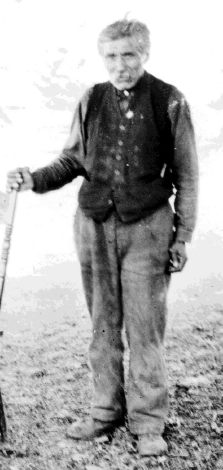
Figure 1. Chief David Latasse photographed on the Tsartlip Reserve in 1922, at age 61-64 (RBCM PN6165).
David Latasse was a Tsartlip (W?JO?E?P) First Nation. They are part of the Saanich (W?SÁNE?) peoples whose territory is centered on the Saanich Peninsula and southern Gulf Islands. Latasse gained notoriety from 1927-1936 as a speaker in his native language at ceremonies, the subject of an early movie maker and as a source of information via translators for newspaper reporters and at least one anthropologist. He was born about 1858-1863 and died May 2, 1936.
For most of his life he lived near his mother’s relatives on the Tartlip Reserve located on the Saanich Peninsula north of Victoria. We are fortunate to have a letter that was dictated by Latasse himself and addressed to the Department of Indian Affairs on June 25, 1903:
“I now live at Saanich on the Sartlip Reserve and have lived here for the last 25 or 30 years. My father was a Songhees Indian and my Mother was a Saanich women. I was born on the Songhees Reserve and lived there until I was about 15 years old and then came to live at Sartlip Reserve. My Grandfather and two brothers are buried on the Songhees Reserve. My grandfather’s name was Skull pult. I don’t remember the names of my brothers I know where all their graves are.”
David Latasse would, by his own statement, be 40-45 years old at the writing of this letter, which means he was born around 1858-1863 or 15 to 20 years after the building of Fort Victoria. His age later became a subject of controversy but was play-up by newspaper reporters perpetuating the stereotype of Latasse as an “ancient” man with a fountain of all knowledge.

Figure 2. Home of Chief David Latasse on the Tsartlip Reserve in 1922. First house on the waterfront at the left of the photo. (RBCM PN11740).
Figure 2. Home of Chief David Latasse on the Tsartlip Reserve in 1922. First house on the waterfront at the left of the photo. (RBCM PN11740).
In his old age Latasse appeared to change the stories of his earlier life to make it seem that he was much older than his true age and the stories he told of his father’s generation were part of his own experience. But, it is uncertain how much of this was a result of his interpreters and the stereotyping of newspaper reporters. Some newspaper reporters seem to have preferred to exaggerate his age as he got older.
The first published newspaper commentary on Latasse appeared in association with the visit of the governor-general of Canada in 1927. Latasse spoke at a special ceremony held at what is now Kosampson Park on the upper Gorge Waterway. The event was to initiate the governor-general as honourary Chief Rainbow (Keddie 1992).

Figure 3. Canoes of First Nations and government officials in Victoria Harbour heading up the Gorge Waterway on March 30, 1927. David Latasse is in the canoe at centre in the poka-dotted white cape with Chief Alex of the Malahat and Chief Cooper of the Songhees in front of him and the Viscount and Lady Willington behind them (Keddie postcard collection).
Figure 3. Canoes of First Nations and government officials in Victoria Harbour heading up the Gorge Waterway on March 30, 1927. David Latasse is in the canoe at centre in the poka-dotted white cape with Chief Alex of the Malahat and Chief Cooper of the Songhees in front of him and the Viscount and Lady Willington behind them (Keddie postcard collection).
More information about Latasse appeared on March 15, 1931, as part of a sequence of articles titled: Soliloquies in Victoria’s Suburbia by Nancy de Bertrand Lugrin – the wife of the editor of the Victoria Colonist. In speaking about the Tsartlip Reserve Lugrin mentions:
“The present chief is David, a very ancient man, who claims to be more than one hundred and speaks only Chinook. If one goes to see him his wife will do all the talking. His present wife does not look more than forty. Occasionally she will translate a question for him to answer. But he says little, though he is pleased to have visitors. His lodge is a fairly modern house, and the living-room a large one.
The chief will tell you, through his young wife, something of his early days. Particularly he likes to dwell upon the part the Indians used to take in the regatta on May 24 in the years gone by. They would practice for this event during the whole year, going out every night in their racing war canoes, for the rivalry between the various tribes for the honor of winning in these events was very keen. They got good money, too, from eight to ten dollars a paddle. One could have a rather fine celebration on eight or ten dollar, he says. But the present-day members of this reserve take little or no interest in the regattas nowadays. ‘It’s too much work’, says old David, ‘for the amount of money there’s in it, and they won’t pay, as they used to do, whether the boats crew win or not.’”.
On July 12, 1931, Lugrin writes about the burial sites among the Saanich and mentions that:
“Just now Chief David is away ‘in the States, for berry picking.’ He is about eighty years old, but that does not deter him from traveling and working. He goes every year at this time. When he returns we are to learn from him some of the old legends of the Saanich Indians with their place names. Tunen, which is the lovely slope of land which faces the southern side of Mount Newton; Omysuk, which is Mackenzie Bay; and the story of Tlespace, the great bare rock in this vicinity which we are told every fisherman knows; Oluktuts, which is Goldstream, and many another. Only old David has the history of Saanich Indians in his head, and he knows no English. But his Indian is very graphic and complete’”.
This is, of course, a stereotype built around Latasse as the fountain of all traditional knowledge. There were certainly other Saanich elders who were knowledgeable about the past and had personal family histories not known by Latasse. To this day, many Saanich families have contributed to providing traditional place names (see Hudson 1970 and Elliott 1990).
On August 23, 1931, another article appears in which Lugrin talks to Latasse after his return from berry picking:
It is wonderful and a precious thing the saga he sings, for with him it will die, and no one will ever hear its cadences again. Therefore we had with us as interpreters Frank Verdier, who speaks Chinook as well as anyone versed in that coast jargon, and Paul, who might have been chief but he was too young. Then there was Mrs. David to help now and then. Paul knows well the musical Indian language of the Saanich tribes, and it is that medium which Chief David mostly employs, though he is fluent in Chinook and knows a little English as well.”
After talking on about Latasse’s mannerisms of speaking, Lugrin notes: All sorts of stories have been told about the chief’s age. When he was received by His Excellency Lord Willington, the Governor-General of Canada, a few years ago, it was said that he was a centenarian. We believe that is wrong. He thinks he is well over a hundred. But Frank Verdier says he cannot be much more than ninety. He doesn’t look over seventy.” Lugrin then chooses to ignore what she just said and focus on the stories that Latasse was a young man at the time of the founding of Fort Victoria in 1842, which would imply that he was in his late 90s.
Lugrin mentions that they “were anxious to learn what the chief could remember of the stories his own father used to tell him”. Latasse is quoted as saying: “Many stories my father has told me of how every summer the Indians from Cape Mudge, the Yucultas, would come down and fight the Songhees, the Saanich tribes and the Cowichans. They would come in their huge canoes, many warriors, and steal upon the villages by night. ‘Always they came for the same reason, to kill the men and to steal the women and young girls, so they might sell them for slaves and become rich. For blankets they would sell them over across the water on the United States side, for blankets and canoes or any other thing the Indians valued’”. Even today you may see throughout the woods in Saanich great pits which have been dug long ago, and which are not yet filled in, so deep they are. That is where the Indian men would hide their wives and children when the wars were on. There they must always sleep at night, so that no enemy Indian stealing through the tree in the dark could find them”.
On August 8, 1931, Latasse’s story is told about the great battle of Maple Bay, where many local First Nation warriors joined the Cowichan to defeat the northern invaders from the Cape Mudge region. On October 18th, Lugrin provides more information about Saanich place names. When trying find out the name for Saltspring Island she says:
“Chief David’s memory is remarkably good, but he does disappoint one occasionally and may have forgotten this. Here are a few names as near as we could get to the spelling. Tod Inlet was known to the Tsautups [Tsartlips] as ‘Snitqualt,’ but the meaning of this euphonious cognomen he could not tell us. Butchart’s Bay was ‘Humsawhut.’ Meaning Sunshine Bay. The bay at the foot of Verdier Avenue [north end of Brentwood Bay] ‘was named for a man who died. We call him ‘Skahasin’.
Another source for Latasse’s stories appears in the Saanich Peninsula and Gulf Islands Review on March 14, 1932 (p.2), entitled: “Aged Chief Tells of Olden Times”.
“The editor of the Review, through an interpreter, recently interviewed the oldest Indian Chief Latess of the Brentwood Reserve, who claims to be 120 years old”. On the topic of extreme weather Latasse indicated that: “some 130 or 140 years ago, according to the information given by the chief’s father, there was an unusual winter when snow fell to a depth of 14 feet on the level and remained for a considerable length of time. Many Indians starved to death as a result, the snow being too deep to procure wild vegetables from the fields and wild game soon being depleted.”
Maclean’s Magazine and the Creation of a Costume
The notoriety of David Latasse had caught the attention of Maclean’s Magazine. On December 15, 1932 (p22&38) they wrote “Indian Saga” which included Latasse’s story of the “Last Great Battle”. “David La Tasse is the oldest living chief on the North pacific Coast. He claims to be more than 100 years of age, and he can remember ‘Jim” Douglas very well – Sir James Douglas, first governor of British Columbia – also the building of the Hudson’s Bay Company’s fort, where Victoria stands today”.
It would appear that Maclean’s arranged for Victoria’s Ernest Crocker of Trio Photography to take photographs of Latasse in what was to be a traditional costume. One of, at least three, images that he took appears in the Maclean’s article (Figure 4, RBCM PN117781). Another, (RBCM PN11778, Figure 6), appeared later in the Victoria Daily times on July 14, 1934 and the other (RBCM PN11743, Figure 5) was not used.
Latasse was holding the same spear, but wearing a different outfit than in the 1927 images. The outfits worn are very much like the large woven blankets made in 1927 for a Tipi constructed for the visit of the Governor-General of Canada (see Keddie 1992).

Figure 4. David Latasse in 1932. (RBCM PN11781).
Figure 4. David Latasse in 1932. (RBCM PN11781).
Latasse was interviewed by the well-known Canadian ethnologist, Diamond Jenness between 1934 and 1936. Using less flowery language than the reporters that proceeded him, Jenness recorded that:
“David LaTesse received his 1st name when he was a little child. There was no potlatch and he does not remember what the name was. He received his second name at a potlatch when he was 12 years old. The new name was qalek waltan (no meaning); it was given him by his grandfather and had belonged to some grand uncle. He received his 3rd name when he was 14. His father conferred it on him. It was the name sxa wal
‘whirlwind’ of his great grandfather who had lived at Sooke. This name goes to the oldest son in the family. The name haiel wat (thunder) goes to the eldest daughter. The name talsit (lightning) to the 2nd son. Sxwa wal remained his name till he was about 50. Then, at a potlatch, he gave himself the name steel um (no meaning), after his mother’s father. This name he still bears” (Jenness 1934-36). Jenness gave David’s age as 85, which would place his birth c. 1849-51.

Figure 5. David Latasse in the middle, with Tommy Paul of the Tsartlip Nation on the left and Chief Edward Jim of the Tseycum Nation on the right, in 1922. (PN11743).
Figure 5. David Latasse in the middle, with Tommy Paul of the Tsartlip Nation on the left and Chief Edward Jim of the Tseycum Nation on the right, in 1922. (PN11743).
Reporter Frank Pagett, writing in The Victoria Daily Times on July 14, 1934, made Latasse considerably older with an article entitled: “105 years in Victoria and Saanich. Chief David Recalls White Mans’ Coming”. By Latasse’s original accounts he would be about age 72-77 at this time.
There was often confusion by reporters about whether Latasse was recalling stories from his own observations or from those of his father’s experience. Latesse provided stories for the newspaper about known historic activities that were clearly out of sequence, mixed up versions of events, such as the observation of the first European ships and the first bringing of cattle to Victoria – which did not occur until several years later – or his suggestion that there was a central camp on Mud Bay where the Empress Hotel and the Union club were located – no evidence of an archaeological site has been found in the historic excavations in this area. Pagett noted that Latasse was “mentally keen, although extremely fragile”. He “was looked after by a well-educated wife, half his age, who aided in interpreting the ancients vigorous statements. The principal interpreter of Chief David’s reminiscences was his grand-nephew, Baptiste Paul, professionally known as Baptiste Thomas, a boxer and wrestler, whose prowess has won fame throughout the Pacific Coast”.
Latasse gave the reporter a political statement about being present during the 1852 meeting regarding the Saanich treaties and interprets the treaties not as a purchase of land but of agreements to use parts of the land for annual payments of rent:
“More than eighty years ago I saw James Douglas, at the place now called Beacon Hill, stand before the assembled chiefs of the Saanich Indians with uplifted hand … I heard him give his personal word that, if we agreed to let the white man use parts of our land to grow food, all would be to the satisfaction of the Indian peoples. Blankets and trade were to be paid. We knowing a crop grows each year, looked for gifts each year. What we now call rent. Our chiefs then sold no part of Saanich”.

Figure 6. Chief David Latasse in 1932. (RBCM PN11778).
Figure 6. Chief David Latasse in 1932. (RBCM PN11778).
The above statement is one that parallels the statement given by Latasse in a letter of April 4, 1932 to Commissioner William Ditchburn with a letter of support from five Chiefs identified as Saanich and witnessed by Simon C. Pierre from the Stolo Nation who was referred to as an “Indian Lawyer” (Latasse 1932). On the same Times article page the relevant sections of the Douglas Treaties referred to by Latasse were published under the title: “Saanich Title Deeds Denounced by Chief”. Latasse was successful in getting across his interpretation of the Douglas Treaties.
Here, Latasse tells a different story about his coming to Brentwood Bay than in his earlier letter version:
“When I was seven years of age I went to Brentwood Bay to live, joining aunts who had become wives of members of the Saanich tribe”. He is quoted as saying that he was 14 years old when the First Europeans came to Victoria Harbour, but this is similar to the age he gave in 1903, for when he moved from the old Songhees reserve to the Tsartlip reserve. This statement may have been misinterpreted in the translation to English. One of the photographs taken by Trio Crocker two years earlier appears with this story (RBCM PN11778).
The Colonist newspaper reports on September 4th, 1935 (p.2): “Centenarian Chief of Saanich Tribe Dances for Movies”. Chief David “being 109…donned his ancient tribal garments and did the Sun Dance before a motion picture camera of Hugh A. Matier, public relations representative for the Union Oil Co. of California …in color …Mr. Matier took 2000 feet of film on Vancouver Island, featuring Indians. … Mr. Matier left yesterday afternoon for Seattle. He expects to return to Vancouver Island next April in search of further interesting material for his lectures.”
The Reporting of His Death
David Latasse died the next year on May 2. The Times Newspaper (p.1-2) provides further miss-information on Latasse’s age, social status and the events of his personal experience: “Chief David Dies at 109″ – “Head of Songhees Indians Remembered Founding of Fort Victoria” … died at his home on the west Saanich reserve this morning”.
The Times mentions the events of the previous summer when Latasse “put on his ceremonial dress to dance before the movie camera.” This is a reference to the American producers mentioned above that made a movie of Latasse dancing.
The next day on May 3 (p.1) the Colonist, with the headline: “Centenarian Chief Passes” repeats the statement of the Times that Latasse died “at the age of 109 years”. The romanticized article by reporter and amateur historian Bruce McKelvie is accompanied by a photograph of Chief David with a woven blanket and spear. “He is pictured above, as he appeared not long ago, when he donned his old-time regalia as a warrior chief.” – “Death Takes Chief David” – “On the Indian Reserve at Brentwood Yesterday morning. … Chief David was a fine type of man. His influence for good among his people was extensive, and his example was an inspiration. He was highly respected by whites as well as by his own people. He recalled the attack by Cowichan and Songhees Indians on Fort Victoria, and was present at the great conclave at Beacon Hill when Governor Douglas extinguished the Indian land title by purchase. … and only last Summer donned his picturesque costume and executed some of the ancient dances before the lens of a motion picture camera. …his name will become a legend and his memory an inspiration to his people – Peace to his ashes”.
On May 8 (p.5) the Saanich Peninsula and Gulf Islands Review under the title “Link with Saanich is Severed by Chief’s death”. The editor notes that: “despite his age, which according to different sources is stated to be anywhere from 110 to 122, was surprisingly energetic to the end”.
Not long after, on May 17 (p.6), the Colonist published another article by Nancy de Bertrand Lugrin about the famous battle of Maple Bay entitled: “Chief David’s Saga”. Here he is telling his father’s experiences when referring to the battle of Maple Bay. The story also appears in Maclean’s Magazine on December 15, 1932, (p.38)
The Latasse version of the lead-up to the Maple Bay battle is recorded as follows:
“For many years, all in the bright summer weather, they have come down upon us, those Ukultahs [Lewiltok] of the north. They have killed our men and taken away our women to slavery. Every year they come and nobody knows whose house shall be left desolate with the ending of summer. They are many and strong and their canoes upon the sea are as the salmon in the spawning season at the river’s mouth. We cannot stand against them. We are too few. We are not united as they are. Year after year we wail the loss of our champions, the loss of our wives and children.”
Latasse provided information on some basic economic activities of “long ago”:
“In July the deer are very fat, we dig our pits for them. In August we hunt the elk with bow and arrow in the swamp lands. The clams too, are fat in August. Always in these days the women are very busy, roasting the meat and drying it for winter; roasting and drying the clams. In August also is the big fishing for tyee salmon, which we dry. All these things we store in cedar bark boxes and hang in our houses. …We gather plenty of bark from the fir trees, big pieces of bark and store it under the wide seat which runs all-round the house. There is plenty of wood for all the cold weather. Only bark we burn, nothing else. When winter come, for four months there is good time. Dancing and feasting and making happy. Nobody sad at all. Everybody laughing like children. Everybody giving parties. You come to my house. I give you present. I go to your house you give me present. All the time like that. Very good”.
Sixteen years later in 1952, Lugrin published a series of articles based on early interviews with Latasse. These included: “Memories. Stories Chief David Told Me” in the Sunday Victoria Times Magazine on April 5 (p.5), where Lugrin notes that: “With the late Frank Verdier and Chris Paul to act as interpreters, we went several times to call”. An article on April 12, was titled:
“Chief David’s Stories – No. 2. Indian Tribes Win Vicious. The Battle at Maple Bay”. Lugrin points out here that the battle “happened when David’s father was a young man”. The story was continued with an article on April 19 (p.5): “Chief David’s Stories – No.3. Triumphant Indians Sing Victory Paean”.
David Latasse was respected by his own people. From the time of the visit of Governor General Willington in 1927, to his death in 1936, Latasse was seen by non-First Nation reporters as an icon representing the romanticized version of the history of local First Nations. David Latasse, however, took the opportunity of playing this role in order to tell his version of history as he remembered it.
References not fully cited in text
Elliott, John Sr. 1990. Saltwater People as told by Dave Elliott Sr. Native Education. School District 63 (Saanich). Edited by Janet Poth. Revised edition.
Hudson, Douglas (compiler) 1970. Some Geographical Terms of the Saanich Indians of British Columbia with information from: Mr. Richard Harry, East Saanich; Mr. Ernie Olsen, Brentwood Bay; Mr. Christopher Paul, Brentwood Bay; Mr. Louis Pelke, East Saanich. Manuscript. McMaster University, Hamilton, Ontario.
Jenness, Diamond. 1934-36.Diamond Jenness, Coast Salish Field Notes. Manuscript #1103.6, Ethnology Archives, Canadian Museum of Civilization).
Keddie, Grant. 1992. Installation of a Songhees chief. Discovery. Friends of the Royal British Columbia Quarterly Review. 20:1:1-3.
Latasse, David. 1903. Letter in Department of Indian Affairs Records. RBCM Archives. RG 10, Vol. 1343, Reel B1874, Cowichan Agency.
Latasse, David. 1932. Letter of April 4, 1932 to William E. Ditchburn, Indian Commissioner for British Columbia. RBCM Archives. RG 10, Vol. 11, 303. File 974/1-9.
This paper deals with the definition, categorization and distribution of labrets, or lip plugs, and gives a regional synthesis of their history as known from both archaeological and ethnological studies on the Pacific Rim, from the Gulf of Georgia region in Canada to northern Japan.
Small fragments of woven material were found along with other items in a burial cave site on Gabriola Island in 1971. The Burial remains and associated artifacts were brought to the (then) Provincial Museum to protect the material that was being removed by unknown persons.
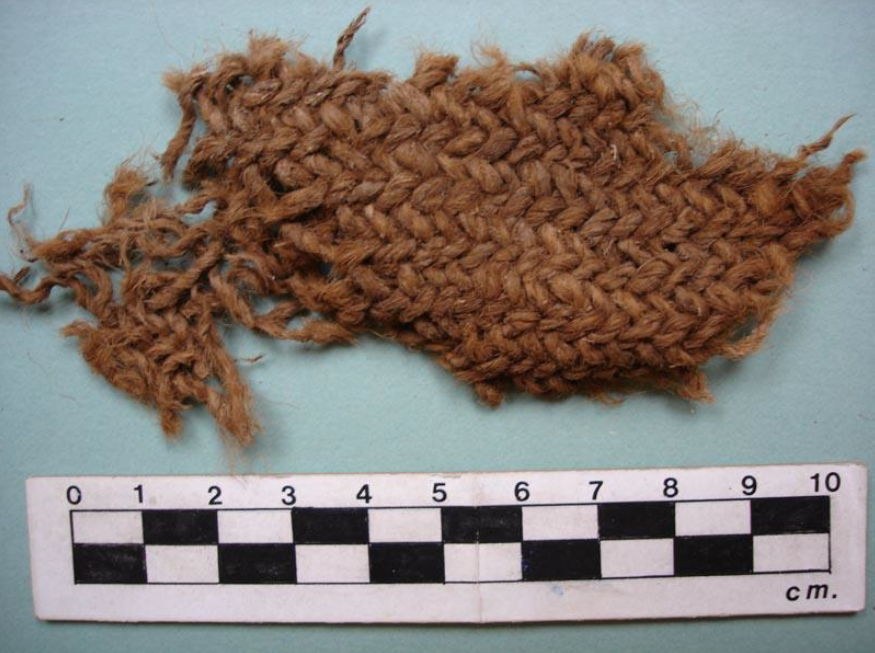
Cloth made from the woven seed plume of the Fireweed plant (DhRx-28:13; accession 71-233). (Grant Keddie photo).
Artifacts found in the cave included bracelets of copper and brass, shell pendants, a stone bead, a green glass wire wound Chinese made bead, a woven rattle head and bark matting, in addition to the small fragments of unidentified woven material. This assemblage of material suggested that the woven material likely dated to around the late 18th to early 19th century.
In 2001, the Snuneymuxw First Nations and the Royal B.C. Museum held discussions for the repatriation of their ancestral remains from a number of archaeological sites, as well as 460 boxes of soil samples and faunal material – mostly from the Departure Bay and Duke Point sites. A ceremony was held at the Royal BC Museum and at the final re-burial ceremony at Nanaimo on October 20, 2001.
During the repatriation process, C-tasi:a – Geraldine Manson, of the Snuneymuxw First Nation, brought a group of elders to the Royal BC Museum, to examine the artifacts to be reburied. The elders held discussions among themselves and agreed that they would allow for small fragments of woven material to be kept for future examination to determine what they were made of.
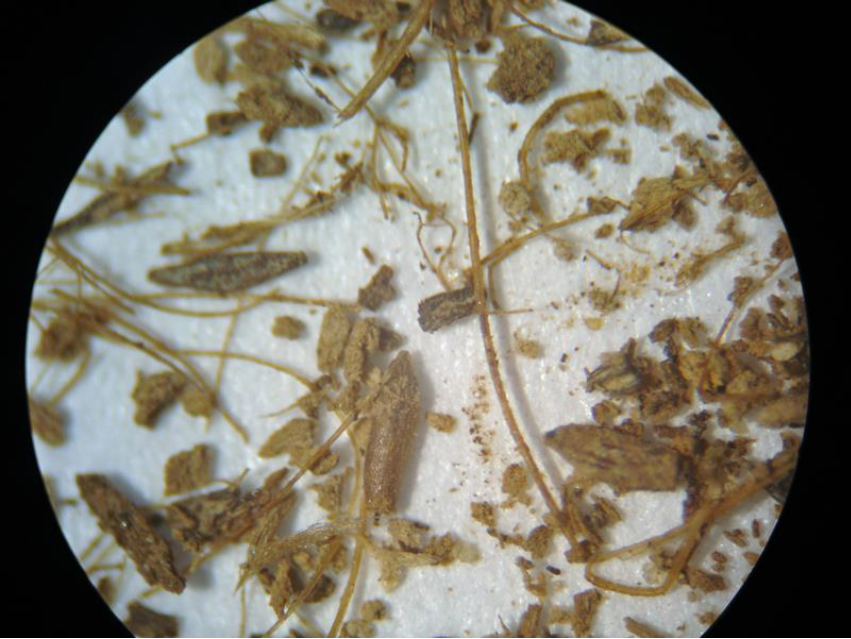
Microscopic view of seed and plume fibres found in the piece of woven cloth
(100X). (Grant Keddie photo).
I examined this cloth fragment under a 200X power microscope with the intent of trying to find hair samples that could be identified as either from dog or mountain goat. The latter are well known to have been used in making several types of blankets. But there were no examples of hair to be found.
What I did find was a mass of tiny plant-like fibres and many tiny seeds. Using our Museums comparative plant and seed collection, I was able to identify the seeds as those of the common fireweed plant, Epilobium angustifolium.

Epilobium angustifolium seeds and plume from RBCM herbarium collection (400X). (Grant Keddie photo).
I surmised that the fibres must be from the plume (the fluff) of the fireweed plant. This proved to be the case even though they were of different thicknesses. It turns out that the fibre thickness varies with the amount of water that the plant has during it active growing stage.
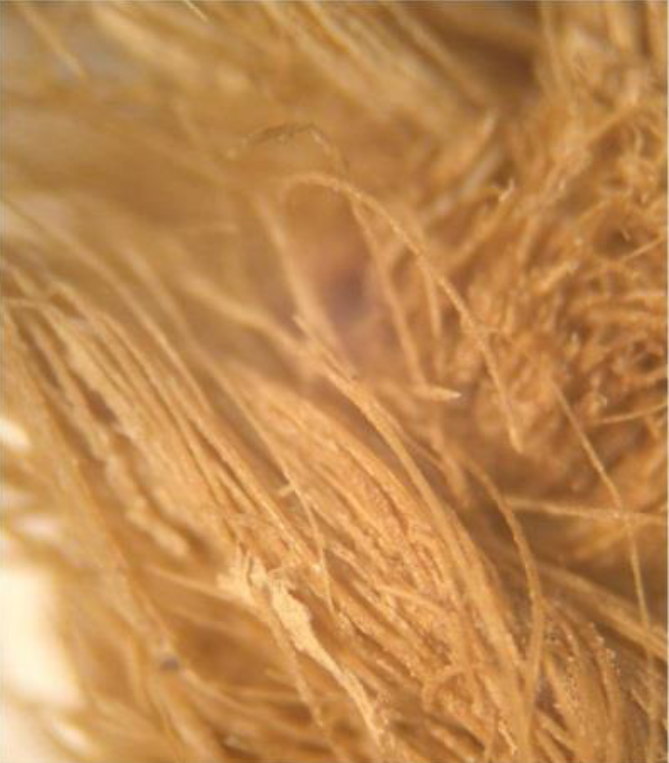
Microscopic View of masses of seed plume fibres in the piece of woven cloth (200X). (Grant Keddie photo).
What is significant about this find is that this cloth fragment is the first and only example of clothing made entirely out of the plume of the fireweed and not just a mixture with other raw material in the clothing construction.
The Early Ethnographic Accounts
In the ethnographic literature it is important to see if statements about plant use are coming from First Nation advisors who have personal experience with the use of fireweed and not just statements by writers repeating the information that previous ethnographers had received.
Myron Eells collected information in the 1870s and 1880s from First Nation advisors who would be knowledgeable about traditional practices, based on their personal observations, from the early 1800s. In speaking about Puget Sound in general and specifically including the Squaxin, Klallam, Skokomish and Twana, Eells notes that: “Fireweed (Epilobium). The cotton-like down from the seed was formerly used in making blankets” (Eells 1985:52). Eells indicates that there are three kinds of blankets: “One was made of dog’s hair, geese or duck down, and the cotton from the fireweed. These were twisted into strings and woven together” (Eells 1985:122).
Edward Curtis, recorded from his First Nation advisors (some of whom were born as early as the 1832 to 1850 period) that the Klallam on the Olympic Peninsula and North Strait Salish speakers on the south end of Vancouver Island “used on special occasions a robe woven from a mixture of down with the hair of goats and dogs and with certain vegetal products. The down of ducks, geese, and gulls, the hair of dogs and mountain goats, and sometimes the cottony fibre of dead fireweed blooms and cattail spikes, were taken in varying proportions and thoroughly mixed by beating and stirring vigorously with a paddle. The resultant fibre was then twisted into loose, fluffy strands, ready for the weaving” (Curtis 1913:44).
Curtis’s statements are confirmed by Erna Gunther’s Quileute and Cowlitz First Nation advisors, in 1924-25, who had never seen a woman weaving a mountain goat blanket, but: “Much more common were blankets made of the fireweed cotton mixed with feathers of seagulls or ducks”. These were pounded together and spun using a spindle whorl (Gunther 1927:221).
Conclusion
It is fascinating to see the ingenuity of the Snuneymuxw First Nations in producing a quality cloth with the very fine seed plume of the fireweed by itself. It is likely that this practice was more wide-spread than previously believed.
References
Curtis, Edward S. 1913. Salish Tribes of the Coast. The North American Indian. Vol. 9, pp.175, Norwood, Mass.
Eells, Myron. 1985. The Indians of Puget Sound. The Notebook of Myron Eells. Edited with an introduction by George Pierre Castile. Afterword by William W. Elmendorf. University of Washington Press, Seattle and London, Whitman College, Walla Walla, Washington.
Gunther, Erna. 1927. Klallam Ethnography. University of Washington Publications in Anthropology. 1(5):171-314, University of Washington Press, Seattle, Washington.
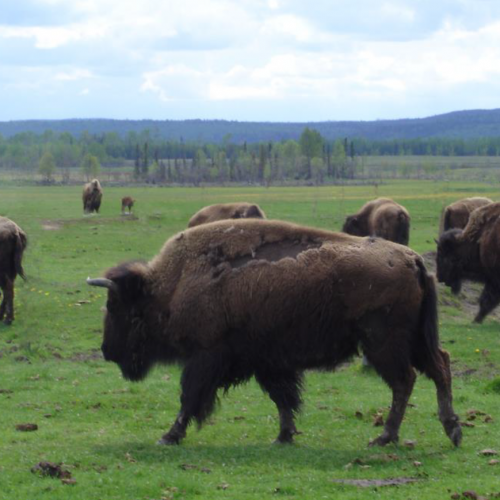
This was a likely scene around Victoria, British Columbia for a 300 year period between 11,700 and 10,900 years ago when an open parkland environment provided habitat for herds of bison. A subsequent cold period saw their disappearance from Vancouver Island.Grant Keddie photo.
Large animals, such as mammoths, mastodons, horses and camels that roamed North America near the end of the ice age are referred to as mega-fauna. Why these large animals went extinct has been widely debated but answers are beginning to emerge.
New information is showing the answer is more complex than previously thought. Both climate change and human hunting play a role at different times in different places.
This was a likely scene around Victoria, British Columbia for a 300 year period between 11,700 and 10,900 years ago when an open parkland environment provided habitat for herds of bison. A subsequent cold period saw their disappearance from Vancouver Island.
Expanding and Shrinking – Habitat and Genes
Before the appearance of humans on the northern landscapes we see that ecosystem stability for animal species generally persisted over long periods of time. During repeated sudden climate changes over the last few hundred thousand years of the Pleistocene (2.6 million to 11,700 years ago) animal populations had the ability to disperse across the landscape to shrinking refugia during harsh times and expand back to increasingly more favourable habits during good times. During cold periods, when the sea level was lower by as much as 150 meters, the Beringian continent was as wide as the Canadian Prairies.
The evidence for shrinking environments is seen in the reduction of genetic diversity in large animals such as mammoth, mastodon and bison. Grass loving animals of the far north were displaced with the expansion of boreal forests during the onset of warm periods. Boreal forest loving mastodons disappeared 70,000 years ago from large regions of the north with the advance of colder climates and the return of an open tundra environment. By the time humans appeared on the scene mastodons only lived much further to the south.
Animal populations were often drastically reduced in numbers, before sub-populations made a comeback. This pattern of population reduction and expansion happened especially during rapid warming periods. The appearance of humans in the region may have destabilized this pattern of population regeneration by restricting the movements of animal populations.
Human Interference
Humans likely interrupted the ability of mega-fauna sub-groups from connecting with each other. This would be especially true if humans were concentrated on regular migration routes between or living on resource rich areas used by the animals. The concentration of large game animals in smaller regions would make them more susceptible to predation from carnivores and humans.
Some mammal species whose ranges straddled the length of Beringia became extinct on one continent, but not the other, with the rise of sea level at the end of the Pleistocene. Examples are the horse (Equus caballus) and Saiga antelope (saiga tatarica) that survived only on what became the Old World side of the Bering Strait.
Humans co-existed for several thousand years in eastern Beringia – the area now including Alaska and the Yukon. During this time mammoths and horses disappeared but muskox, bison and caribou survived.
Further south large animals were faced with rapid environmental change and increasing human and carnivore predation. In the American Southwest mammoths experienced a warm and dry climate that would have made their seasonal movements more predictable and more vulnerable to predation. Large scale predation of mammoths and mastodons is often associated with a culture called Clovis that was only around for a short time period of 300 years from 13,200 to 12,900 years ago. The Clovis culture is recognized by distinct types of spear points. Other cultures before and after the Clovis culture also hunted mammoths, but our knowledge of these cultures is still developing.
The megafauna diversity of North America and Eurasia was considerably reduced around the time of the transition from the ice age to the more recent Holocene period after 11,700 years ago. By this time the woolly mammoth (Mammuthus primigenius) became extinct in many regions in both North American and the Eurasian continent. The last mammoth survivors on Wrangle Island northwest of the Bering Strait disappeared only 3700 years ago when we see the first evidence of human occupation of the Island.
Muskox in British Columbia download
List and Comments on Select Population References to the Lekungen (Songhees and Esquimalt Nations) download
List and Comments on Select Population References to the Lekungen (Songhees and Esquimalt Nations)
Fortified Defensive Sites and Burial Cairns of the Songhees Indians
Netting Needles of British Columbia download
Netting Needles of British Columbia
The Importation of old Chinese Coins for the Playing of Fan Tan Gambling Games in British Columbia. download
The Importation of old Chinese Coins for the Playing of Fan Tan Gambling Games in British Columbia.
Symbolism and Context: The World History of the Labret and Cultural Diffusion on the Pacific Rim download
Symbolism and Context: The World History of the Labret and Cultural Diffusion on the Pacific Rim
The Chuchawaytha Rock Shelter Pictographs
Installation of a Songhees Chief download
Installation of a Songhees Chief





